VOLUME
ISSUE 03
Port of Call
A port of call is a heterotopic site where nautical imaginings contain the mobility of nations, cultures, powers and maritime and economic trade over time. In this issue, art writers, critics and artists reflect and engage with the multiple entries and exits inherent in ports to serve as an aide-memoire to the ancient yet most contemporary of spaces, the port.
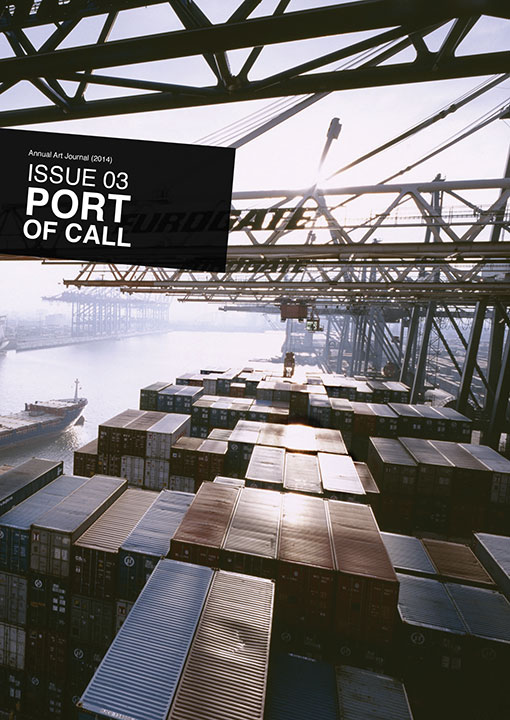
ISSUE 03
2014
Port of Call
ISSN : 123456789
Introduction
Essays
Interviews
Photographic Essay
Contributors’ Bios
Introduction
Introduction: Port of Call
Essays
Art in the Age of Containers?
ON-ZONE Translated by David Williams
Interviews
Photographic Essay
Contributors’ Bios
Contributors’ Bios
Introduction
Editor
Venka Purushothaman
Associate Editor
Susie Wong
Copy-Editor
Bernhard Platzdasch
Advisor
Milenko Prvacki
Senior Fellow
LASALLE College of the Arts
Manager
Linda Loh
Project Interns
Marilyn Giam
Vanessa Lim Yan Mein
Contributors
Tony Godfrey
Ho Rui An
Ho Tze Nyen
Hou Hanru
James Jack
Lim Kok Boon
Pawit Mahasarinand
Aubrey Mellor
Venka Purushothaman
Bala Starr
Dubravka Ugrešić
Introduction
Introduction: Port of Call
The theme of ISSUE 3 is Port of Call. A port of call is a heterotopic site where nautical imaginings contain the mobility of nations, cultures, powers and maritime and economic trade over time. We know of this only through history, which maps the mobility of nations as geographical drawings onto the carapace of the earth. A port of call is simply a place where a ship anchors temporarily or as a destined final place. But its association reverberates through all other forms of travel (communal, personal, metaphysical and spiritual) including everyday activities indulged by a person. A port of call is also an allegory for a longing to locate oneself through a visit or a return. This longing is wrought with an archeology of hope, remembrance and futility. Both the nautical imagining and the allegory speak resolutely to the human condition.
Often the importance of ports to global trade and the nationhood only becomes apparent in politicised discourse found in foreign relations between nations. Moreover, port cities such as Singapore remain slightly more vigilant as this serves as their lifeline to survive as a nation. While travellers’ tales and political discourse provides us with much fodder for consideration, the symbolic power of the port remains its quiet icon: the container. It symbolises the potent discipline of trade, its impenetrable nature and its containment of consumer fetish. The icon does not move. It is moved. The container masks or silences the inherently heterotopic nature of ports and we are confronted with disciplined and universally objectified systems of organisation.
In this journal we provide a platform to art writers, critics and artists to reflect on the theme. In keeping with the multifarious points of entries and exits inherent in ports, we have attempted a multifocal point through essays, interviews and photography to serve as an aide-mémoire to the ancient, yet most contemporaneous, of sites: the port.
Essays
Global Containers: Containing Visual Arts in the Age of Globalisation
Kublai Khan had noticed that Marco Polo’s cities resembled one another, as if the passage from one to another involved not a journey but a change of elements. Now, from each city Marco described to him, the Great Khan’s mind set out on its own, and after dismantling the city piece by piece, he reconstructed it in other ways, substituting components, shifting them, inverting them.
Italo Calvino
Calvino’s fictive imagination paints a dark possibility as to the way history has framed the world today, which uncannily seems to reinvent itself within the discourse of globalisation. To think of the world in distinct and quantitative cultural composites to be venerated and celebrated and yet waiting to be exploited, re-interpreted and curricularised (as Calvino’s Kublai Khan does) into an international idiom of globalisation is, indeed, odd though true. In this essay, I seek to opine on the adage globalisation and foreground it as an instrument of control, study the manner in which it devours art and find apt responses to these two conundrums in the art of Atta Kim.
I
‘Go global’ is a commonplace maxim. Cross-border exchange of commerce, ideas, peoples, and even disease and terror to any part of the world is at best liquid capital. It is a new world where concepts of time and space narrows with the advent of speedier modes of transport and communications like the Internet. Colonialism exorcised, modernity debunked, there has been increasing pressure on newly industrialising and modernising societies and communities to become viable sites of liberal democratic capitalism.
Globalisation has its roots in seventeenth century industrialisation and became manifestly commandant during the project of colonialism and its attendant, modernism. The establishment of the English language as lingua franca of the world was the first globalised attempt at mono-culturalism (especially for trade, law and education) amidst highly diverse and distinct communities and civilisations. While English remains today the preferred link language of commerce, it carries with it the remains of colonial ideology and continues to be unraveled in emerging socio-cultural discourses and criticism. As modern cities and environments become experiences that cut across all boundaries of geography and ethnicity, of class and nationality, of religion and ideology, the English language unites humankind by organising people into citizens of the world. Perhaps globalisation and modernism are a paradoxical unity of disunity. As Marshal Berman notes, a unity of disunity: “it pours us all into a maelstrom of perpetual disintegration and renewal, of struggle and contradiction, of ambiguity and anguish”. To be modern is to be part of a universe in which as Marx said, “all that is solid melts into air” (1982: 15) Marx’s pronouncement rings true today only to be encapsulated by Aldous Huxley’s Brave New World (1932), which chillingly proposes cloning the human at literal and metaphorical levels, and collectivism as a means of enabling a global workforce. In this collectivism, there is no kinship nor reciprocity, only stark human capital.
In this starkness of human capital is there a sense of self? Globalisation erases the volatility of human life and experience through the reduction of geographical distance for shared cross-border socio-economic-political exchange, thereby producing a culture of similarity or sameness. Where then is the sense of self? A feature of modernism was that it proposed a calming of this volatility to find a sense of self. Globalisation risks a claim on this, too, where conflicts between class and ideological forces, emotional and physical forces and individual and social forces are mystified and veneered to reflect a language of uniformity and indifference. Old structures of value systems are subsumed within a framework of free trade marked by mergers and acquisitions. Insidiously, globalisation suppresses the human self and creates a mythic self – one, which is structured on the principles of an exchange-value: A mythic self that congregates at the doorsteps of a global village. The global village (Marshall McLuhan) is nothing more than a utopia of sameness, of dogmatic orthodoxies only to find its allegory in T.S Eliot’s cultural despair of seeing modern life being “spread out against the sky/Like a patient etherized upon a table,” (1998: 3) “uniformly hollow, sterile, flat, one-dimensional, empty of human possibilities”, and which is reliving itself in the global. “Anything that looks like freedom or beauty is really only a screen for more profound enslavement and horror” (Berman 1982: 169-170).
With a certain apocalyptical speculation, Francis Fukuyama (1995) calls globalisation as being representative of the “end of ideology”, that is, an ideology shaped by the locality of a community, in particular, through its kinship, history and reciprocity. The exchange-value structure, premised on free trade, quickened this end together with it any sensibility of a community. In 1989, the fall of the Berlin Wall reconstituted this quickening as the world realised issues regarding citizenship were increasingly taking shape. The invention of communication technology and especially the Internet, the communicative symbol par excellence of economic, social, political and cultural free trade has made humans pilgrims, vagabonds, tourists, players, and strollers of the information highway.
Today, the promise of globalisation to a meaningful and ‘beneficial-to-all’ principle is viewed with skepticism as societies awake to the treachery of adhering to universal financial and economic guidelines that negate economic, social and historical specificity: the financial collapse and impact in Indonesia and Argentina in the beginning of the 21st century are a case in point. Anti-globalisation protests have greatly fallen on deaf ears as the blind faith to economic viability as the sole path to human survival and sustainability continues to be guiding light of political systems. The question then is – whose globalisation, whose benefit? The gavel of Wall Street signifies the demise of authority and power of financial economies elsewhere. Wall Street narratives have become the grand recit of globalisation. Despite the collapse of the financial order in Wall Street, the narrative of collapse continues the grand recit in the form of scapes and organizational nodes. Examples of these scapes and nodes include airports, which serve to centralise and control human traffic; stock exchanges, which centralise share and currency trading; international news, which is centralised through agencies such as Associated Press and Reuters; and, search engines such as Google that organise information for consumption. These scapes and nodes control and manage the relay of information and movement of people across national borders, which individual communities are unable to control. Every emergent society wants to be part of this traffic control but these scapes do raise new forms of inequalities (US and European control of major markets); new forms of desires (commodity fetish for US and European products); new forms of risks (increase on surveillance, spread of diseases); and new forms of socialisations (cultural products such as world music and celebrity worship) (Urry 2000: 65). The very notion of ‘society’ is questioned today.
The terrorist bombing of the World Trade Centre (WTC) in New York on 11 Sept 2001, much etched in the human mind, is indeed an attack on globalisation embodied in the lived experience of the WTC and its numerous nationalities working within the semiotic rubric of America. In a Baudrillardian sense, the bombing was nothing more than a simulacrum of the growing concerns of globalisation. As the world viewed the multiple angles and picture frames of the ‘Live from New York’ bombing, the world reveled in its own obscene ecstasy. The event was a baroque opera performed to demonstrate a suffering scion of democracy, of globalisation. Baudrillard’s pronouncement against globalisation was telling. He says,
We are no longer a part of the drama of alienation; we live in the ecstasy of communication. And this ecstasy is obscene. The obscene is what does away with every mirror, every look, every image. The obscene puts an end to every representation. But it is not only the sexual that becomes obscene in pornography; today there is a whole pornography of information and communication, that is to say, of circuits and networks…in their readability, their fluidity, their availability, their regulation, in their forced signification, in their performativity, in their polyvalence, in their free expression (1983: 130-131).
II
In his Lectures on Aesthetics, Hegel declared that the history of art was just a story, and that it had come to an end. He based this in part on the view that art was no longer able to relate society as it once has done…A gap had grown up between society and art, which has increasingly become a subject for intellectual judgement rather than…an object of sensuous and spiritual response.
Arthur C Danto
Art today is both an abstraction and a distraction. As a critique of representational practice in art, the practice of abstraction gained momentum and became the dicta of twentieth and twenty-first centuries employing three-dimensional, performative and multimedia activities to its tenets. Representational practice was held suspect of cultural categorism where it presented, mirrored and stereotyped peoples and ideas. Abstraction was critical, and is still valuable, in propping a palimpsest of ideas and value systems but in recent times has taken serious interrogation as conceptual frivolity and artistry, all in the free-play with nihilism (Nietzsche), the sublime (Kant) and excess (Bataille) referenced themselves into art. Certain totalitarianism has set in and its manifestation was felt in the 2001 Turner Prize award.
Martin Creed’s winning of the 2001 Turner Prize for a minimalist installation work, Lights Going On and Off—an empty gallery centred with flashing lights—as premised on a post-modern diatribe: “people can make of it what they like. I don’t think it is for me to explain it” (BBC News 10 Dec 2001). His win reinforced the growing distension with the path of abstraction. The curators’ response and analysis of the work leaves the view paralysed at best: “his work was emblematic of mortality…what Creed has done is really make minimal art minimal by dematerialising it — removing it from the hectic, commercialised world of capitalist culture. His installation activates the entire space” (BBC New 9 Dec 2001). This does mark a major turning point in the history of contemporary art and the end of imagination could not have been any closer, for many. Abstraction, in its post-structuralist discourse stigmatises localised practices and representational practices as being reductive and unassimilable into the art world despite the fact that representational and figurative works still carry strong collector sentiments in auction houses and galleries.
The development of abstraction, I would argue, has thinned today into notional principles of displaced abstractions that defy locality, embrace psychology, denies identity and promotes universality and celebrates dramatic display of exhibitions. Premised on the post-modern campaign of equality of human life and being, the world today seeks to transcend the cultural, spiritual and socio-political specificity of communities, which have been exposed to harbour biased and fundamental problematics in thinking and application. An internationalist practice has emerged premised on the post-structuralist distrust of authorial intent and the over-reverberance of signifiers in the creation of meanings; and today, painting, I would argue—to borrow Georges Bataille’s words—is a site of trauma, loss and castration (Fer 1997: 3). The castrated abstract art today is one that privileges ‘universal’ aesthetics and concepts over localised ones. This is notable amongst emerging new art markets in third world countries where the need to produce artworks tenable with the expectation of the well-travelled, well-informed tourist whose market gaze is informed by this internationalist standard that is primarily a western discourse. These emergent markets, pushed to the forefront primarily by global economics, negate their own art and historical development.
The rise of art biennales goes in tandem with the global ebb and flow. As a cultural scape of globalisation, art biennales serve as meccas of internationalist practice, where a free-trade emporium or trade fair space earmarks the ideological death of communities as their art is presented in a nexus of ideas and money. From Sydney to Venice, to Dhaka to San Paolo, to New York to Japan, art biennales have registered a powerful scape that manages and sets the international benchmark for art practice through a dramatic display of exhibitory prowess. Biennales are big on international concerns of social matters, aesthetics and meta-narratives, small on local concerns. Identifiable pavilions, booths and signages are the lone representatives of locality and cultural specificity. Any semblance of a localised identity is often, not always, negotiated through the mass cultural appeal of exoticism: Indian, Chinese, African, Andean, Aboriginal iconography have flavoured mass consumption and continues to exert a colonising presence on the native spaces and minds.
In another turn, the emergence of ‘freeports’ for art is disconcerting. A free port is a nexus of trade, which benefits from relaxed custom and excise. Many ports such as Singapore and Hong Kong were founded as free ports during colonialism. Today, Luxembourg, Geneva, Zuerich, Singapore and Bejing are fast becoming freeports or ports of call for storing art not dissimilar to a safe deposit box in a bank. Pioneered by the Swiss, the main attraction unfortunately is antithetical to the purpose of art: to keep valuable art, trapped in private collection and worth billions of dollars, away from public access and scrutiny. In a recent article, The Economist (23 Nov 2013) states:
The world’s rich are increasingly investing in expensive stuff, and ‘freeports’ such Luxembourg’s are becoming their repositories of choice. Their attractions are similar to those offered by offshore financial centres: security and confidentiality, not much scrutiny, the ability for owners to hide behind nominees, and an array of tax advantages. This special treatment is possible because good in freeports are technically in transit, even if in reality the ports are used more and more as permanent home for accumulated wealth.
With prison-like vault security art, fine wine, jewelry, gold and classic cars are cared for in these containers of culture siting in transit between cultures and private and public ownership providing legitimate and much needed comfort and solace to “kleptocrats and tax-dodgers as well as plutocrats.” (23 Nov 2013).

Art in freeports are free from custom duties and taxes as they are primarily in transit from one place to another. However, they can remain in one place for an eternity without attracting taxation and without access to the world. Art today is trapped and boxed within the very structuralist framework that post-structuralism negated and enslaved to a capitalist narrative.
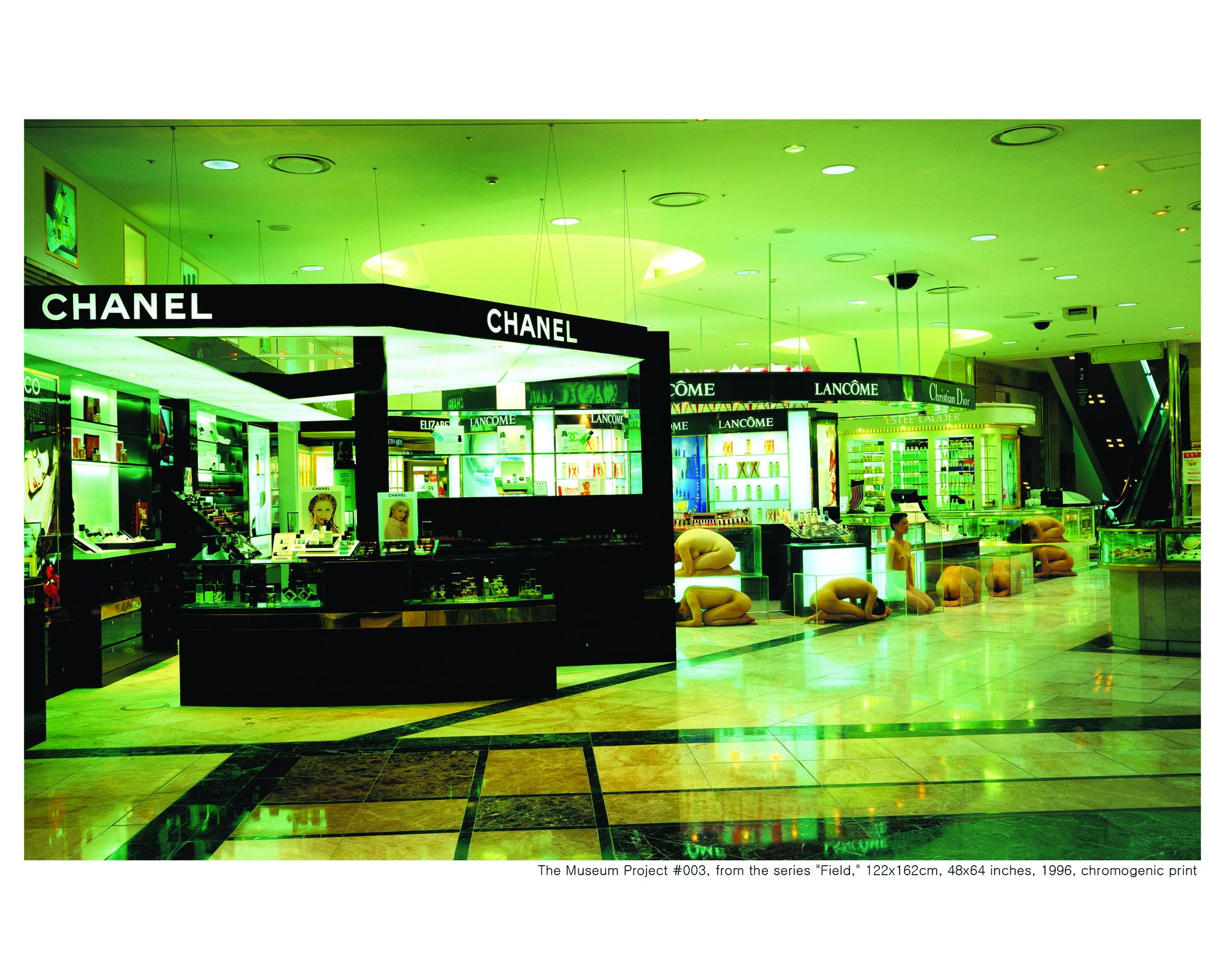
III
The quiet icon of globalisation is the container. Stoic, static and stationed at various ports from Rotterdam to Singapore to Shanghai, the container symbolises the discipline of trade, its impenetrable nature and its containment of consumer fetish. The containers—20 to 40 footers—do not move. They are moved. Prone to abuse, mistrust and piracy, the containers that form a main physical bulk of economic trade for many countries have, at an ontological level, a toughness akin to a human body. The human body as a site of inscription is not new. As a site of divinity and as site of self, the body is marked by instability and indeterminate set of meanings embroiled in a Kantian free-play with authorial narratives that stake claim to power. What than are the inscriptive codes of the globalised world on the body? The containers may provide an answer.
The cultural correlation between the container and the human body are concerns of Korean artist Atta Kim’s grand MUSEUM PROJECT undertaking. Shifting away from a globalised abstraction, Kim’s work resurrect representation through photography, in the Series of Fields, where he presents naked human (Asian/Korean) bodies—trapped, captured, confined, showcased, exhibited, controlled, moved, transported, caricatured—in acrylic boxes. The size of the boxes are uniform and do not allow for much movement. The acrylic boxes are contemporaneous coffins that gain legitimacy by seeking similarity to fetuses found in beakers at science research labs. The bodies are silenced by their nakedness and lack of identity. The boxes of bodies reverberate of museum and anthropological collections that are constantly waiting, waiting to be moved, identified and freed. The transparent boxes are a metaphor for the transparent and invisible control over the human.
Kim suggests several possibilities of freedom. In the #001 Series of Field, Kim presents the alienated containers abandoned on a deserted road. A potentially busy road encounters abandoned boxes of bodies, strategically placed on the road to be run over. An accident leading to freedom is the only possibility here. It reminds one of the trafficking of human refugees left to the mercy of the globalisation’s alter ego: piracy. Yet another freedom is proposed in #003 Series of Field, where boxes of naked bodies are placed at the cosmetic section of a departmental store. Awaiting to be unpacked, freedom for these bodies is through social veneering, that is through cosmetics, to become something other than the freed self. Yet another freedom is starkly crisis-ridden. In #019 Series of Field, nine upright boxes face the ocean. Awaiting to leave for a new identity elsewhere, or were they left behind as rejects, or are they ship-wrecked treasured on an island trapped within the confines of their prejudices, beliefs and value systems? Kim’s work does have far reaching consequences.
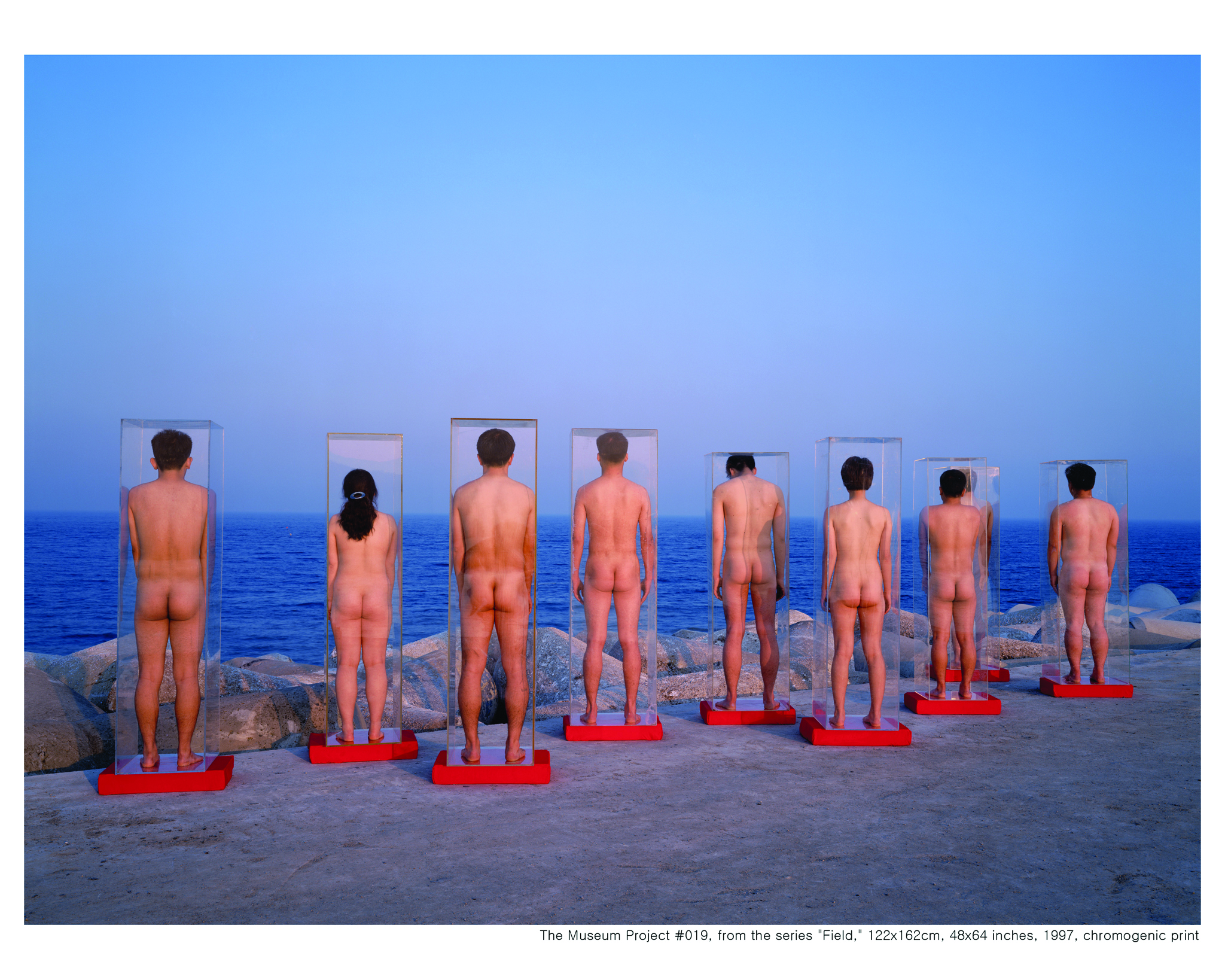
In Kim’s works the naked body is central and devoid of inscription and serve to become a manifesto for dead and moving bodies. In actual fact the viewer imposes the inscription. Clothing and nudity have worn themselves out of current practice. Nakedness references itself to the body politic, as the contested terrain for ideas unlike nudity, which still references itself with the body physical. The body today has been removed of its grandiose divinity, linen virginality and quiet sacredness and in place is nexus for value exchange of the commodity culture. Through the fetishisation of a commodity culture, nakedness, in the global world, is nothing more than a cultural veneer that cloaks the horror of assimilation and sameness. Kim’s work emphasises a melange of assimilation and representation. Is the body involved or mute to this writing of globalisation? Is it a writing of enslavement, empowerment, docility, rebellion or virtuosity? This uncertainty could be resolved if we in part accept phenomenologist Maurice Merleau-Ponty’s belief that “experience discloses beneath objective space, in which the body eventually find its place, a primitive spatiality of which experience is merely the outer covering and which merges within the body’s very being. To be the body, is to be tied to a certain world, as we have seen; our body is not primarily in space, it is of it” (1996: 148).
IV
The state of the visual art in the current international practice is nebulous, as the stream of globalisation has overflowed. Rocks in the stream take the shape of economic volatility; tributaries manifest themselves in terrorist activities to stake their right to exist. Caught between a venerated internationalist mode of practice and a jaded traditionalist mode of practice, which has been commodified further as the exotic for mass consumption, contemporary art has become the very structuralist and essentialist principle that is fought against. New visions are needed; a dramatic incident is needed to spur a new awareness. Artists are seeking to return to the habitat, exercising a right to justify a located-ness in the global while the stoic container of the global is still in control.
The original version was published in Site + Sight: Travelling Cultures. Editor. Binghui Huangfu. Earl Lu Gallery: Singapore, 2002 (ISBN 981-04-6706-0). Published with permission from LASALLE College of the Arts. It has been re-edited for this publication by the author. Image from the Collection of Institute of Contemporary Art Singapore, LASALLE published with permission.
Images courtesy of the artist Atta Kim.
References
Baudrillard, Jean. “The Ecstasy of Communication” in The Anti-Aesthetics: Essays on Postmodern Culture. Ed. Hal Foster. Seattle: Bay Press, 1983.
BBC News. “Creed’s Minimal Approach to Art”. 9 Dec 2001.
BBC News. “Creed Lights Up Turner Prize”. 10 Dec 2001.
Berman, Marshall. All that Solid Melts Into Air: The Experience of Modernity. New York: Penguin Books, 1982.
Calvino, Italo. Invisible Cities. New York: Harcourt Books, 1974.
Danto, Arthur C. The Body/Body Problems: Selected Essays. Berkeley: University of California Press, 1999.
Elliot, T.S. “The Love Song of J. Alfred Prufrock” in The Waste Land and Other Poems. New York: Penguin Books, 1998.
Fer, Briony. On Abstract Art. New Haven: Yale University Press, 1997.
Fukuyama, Francis. Trust: The Social Virtues and the Creation of Prosperity. New York: Penguin, 1995.
The Economist. “Freeports: Uber-Warehouses for the Ultra-Rich”. 23 November 2013.
Urry, John. “Global Flows and Global Citizenship” in Democracy, Citizenship and the Global City. Ed. Engin F. Isin. New York: Routledge, 2000.
Merleau-Ponty, Maurice. Phenomenology of Perception. Trans. Colin Smith. New York: Routledge, 1996.
Essays
Art in the Age of Containers?
Whenever I think of containers I always think of the man I killed in Shanghai. A hundred containers filled with art stacked up on a quayside. I visited Copenhagen in 1996 when it was the European capital of culture. In one exhibition, Art across Oceans: Container 96, ninety-six containers were arranged on a quayside, stacked three high, linked by metal stairs and bridges to maker a “global village”. Each container was given over to an artist from another harbour city to make or display a work in: Beverly Semmes filled hers with a gigantic dress; Richard Torchia made his into a camera obscura, but the one I remember best was that by the Cuban artist Kcho: inside his container was a big wooden box and that was filled with water, and floating on that water was a small, neat dinghy or rowboat. Of course, at one level I knew that his work referenced the many ways Cubans who wished to escape Cuba for a richer life in Florida tried to cross the ninety miles of sea between. (In another exhibition in town, he showed Infinite Column No.5, a work made with inner tyres from trucks and rope, the sort of flotation device the truly desperate had used to get to the land of the free.) But on a more general level the work was profoundly paradoxical: a boat that floated but could go nowhere. Containers are like that too: built to be infinitely transportable, yet incapable of any volition. They are inert.
As a one-time librarian I recognize that a container is like an empty bookshelf: a taxonomic device awaiting taxonomy. But when the library is filled we can see the taxonomy clearly: here is fiction, there is marine biology, there is the history of Singapore. But we can never know the taxonomy of the containers, what is in each, how the types of products are arranged or dispersed—that can only be known by the shipping companies.
Containers nag at me like a bad conscience. Like white plastic shopping bags blowing down the street in the wind they are ubiquitous; like those bags containers are devoid of advertising or any ostensible statement save of ownership: Maersk, Cold Storage, Textainer, Fairprice, Hapag-Lloyd.
Containers made convenient prisons in Lebanon or Afghanistan, and used as such were sometimes left closed until in the oppressive heat all inside had suffocated to death, or else shot inside, the metal walls peppered and punctured by the bullets of machine gun. Inside, in the final silence, brilliantly, sharp shafts of summer sunlight traverse the inner darkness. Containers do not speak of this: they do not speak; they mean nothing. They are solely passive, awaiting use.
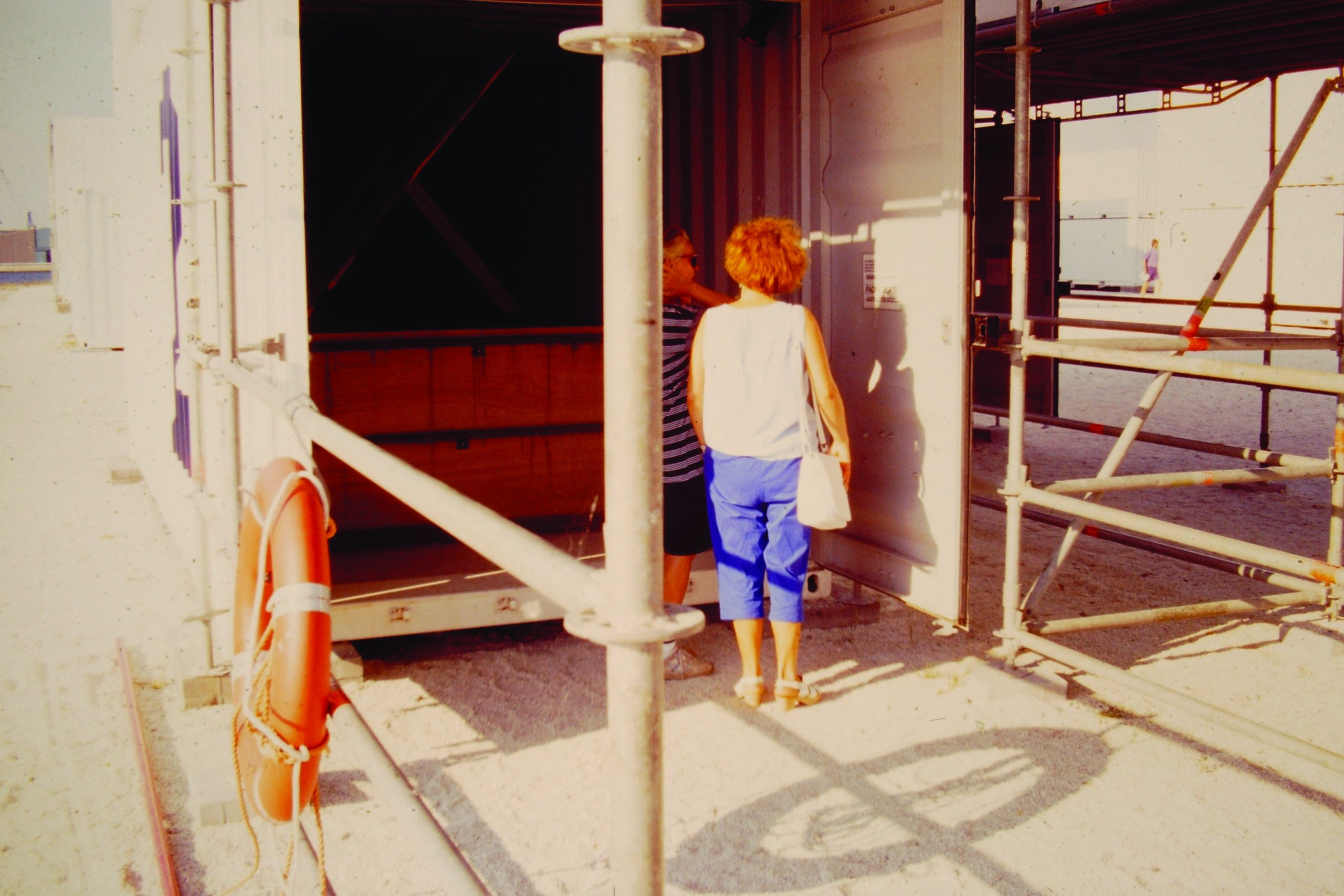
KCHO, in Container ‘96, Copenhagen.
In 2005, I went to the Art Basel Miami fair and there amongst all the glitz and ostentatious display of wealth one artist—Kader Attia, a Frenchman of Algerian descent—had been given a container to put art in outside the exhibition hall. He had made a sweatshop shop, filling it as tightly as he could with migrant workers with sowing machines working hard, long hours though unusually, on this occasion for decent wages. He made his point.
Containers were not meant to cause evil: they were invented and developed to tidy up international transport and make the world more efficient—ergo better. They are a convenience that is there to be used. Of course, apart from their phenomenal convenience, they can be used to morally good purpose: When in 1987 Kaspar König was made director of the famous art school in Frankfurt (Städelschule) he insisted that also, for he always curated, he be given an exhibition space but that, in a protest against the museum mania then so gripping West Germany that every city had to have a slick, posh, hyper-modern art museum with a more architecturally radical (and hence more expensive) building than other cities, it would cost less to build than the annual budget for exhibitions. (I doubt, in comparison, that the annual budget for exhibitions at the new National Gallery of Singapore will be a fraction of the cost of the architecture). The architect (female by his choice) constructed a simple top lit box behind the façade of a bombed out library and added for office and storeroom a container on either side. Containers can be used in a poetic, kooky or trendy way: last night I passed by a groovy bar and events venue in Gangnam’s bizarrely called Platoon Kunsthalle—it was made with containers. Shigeru Ban likewise made an elegant gallery for the second Singapore Biennale with containers.
Of course containers are not evil things, they intend no harm, in fact they have no intention or opinion at all: they are passive, ubiquitous and available. Nevertheless they mean many things.
Above all else, perhaps they mean the end of the sailor and at a cultural level the end of the sea. As a child in England like others of my generation, I dreamed of becoming a sailor and travelling the world. Sailors then wore neat uniform with peaked caps and a boy could still aspire to become a sailor and have an exciting life on the ocean waves, a life of adventure, a life of exploration. (Even, we hoped, as we became teenagers, a life with a girl in every port.) But containerisation meant the end of sailors. When Captain Cook sailed these seas, “discovering” Australia in the process, his ship weighed all of 388 tons and needed 71 sailors to keep her moving. 240 years later a large container ship weighs 150 times that, or 450 times when loaded, requires a crew of only 13. It also means the end of dockers, the people who unload ships — like sailors an archetypally male profession. Sea travel is managed now in landlocked offices, on laptops. There is even talk of fully automating ships and doing away entirely with sailors. This bureaucratisation of the sea is typified by Rotterdam and Singapore. Once houses and streets clustered around the port, now the Rotterdam or London docks are far away from the city centre—the Singapore docks soon will be, too. Think of how rarely one seas the sea in Singapore! Nothing save Jumbo seafood restaurant on the East coast seems to actually face the sea.
We English were a nation of sailors, but now are merely a nation of yachtsmen—though one should add yachting, provides a wonderfully physical sensation—scudding across the sea, in a boat so small that you can skim the water with your hand and appreciate the curvature of this world.
At a conference for the first Liverpool Biennale in 1998 Allan Sekula, who was known for his profoundly unromantic photographs of container ships sailing from port to port, talked of how the sea had become uncanny, something repressed, the image still there but no longer experienced as a real thing. His meditations were set off firstly by the Winslow Homer painting Lost on the Grand Banks bought by Microsoft Chairman Bill Gates for more than $30 million – expensive because it was the last major seascape by Homer still in private hands rather than a museum; and secondly, by the recent defeat of the dock workers in Liverpool who had opposed containerisation but after a long and painful labour dispute had all lost their jobs and been replaced by a few technicians with machines to move the containers around instead. “The sea,” Sekula said, “had become uncanny”—it was there in the imagination as a romantic or scary thing—think of movies such as John Carpenter’s The Fog or The Perfect Storm or, squirming at the thought of it, Pirates of the Caribbean. But we didn’t experience it for real any more.
Sea travel is to plane travel as walking is to commute by MRT1—something experiential in space and time against something disengaged and a denial of time. Of course plane flight is real enough, especially when you hit turbulence, but you are no longer anchored, your view of the world is scarcely more real then looking at the world on google earth. Plane travel in comparison to sea travel is like “beam me up Scottie!”
Sea travel is smelly—salt air, oil and fish freshly landed on the quayside. A poetry of departures and arrivals. On a boat one feels the wind in one’s hair, the boat swaying under one’s feet to the lurching rhythms of the waves. One watches the port grow small on the horizon and above the wake gulls call and wheel, waiting for scraps to be thrown.
Sailors were workers, air-hostesses are comforters, their job is to feed you stodgy food you do not need and keep you passive. Being a sailor not so long ago was a mythical sexy vocation —travel then was still romantic and a little dangerous.
All my memories of sea travel are from before the 1980s. A ship taking us to holiday in Jersey and a boat following it out of Portsmouth harbour filled with striking sailors shouting abuse and carrying banners saying “SCABS”. There are not enough sailors to mount a decent strike anymore.
Roaming the ship, watching your home port grow small on the horizon, watching the landscape become one of nothing but boat, water, horizon and sky and in so being becoming aware as never before of how vast and varied both sky and sea with its constant, unrepeating, flux of waves are.
Leaving Plymouth in a force 8 gale: the boat leaning into black, turbulent seas; the passengers bolting their food before running to hide in their cabins. The ship appeared deserted save for my infant daughter and myself, building palaces with Duplo in the play area.
It seems so long ago and presumably most reading this have no equivalent experience: the cruise ships of today are moving dormitories too big to be affected by the waves they move through. You are enclosed in them as in a hotel or in the MRT.
The Twenty-First century is supposed to be one of communication and culture, but it is one where efficiency necessarily rules. A friend of mine who spent his life working in the container industry told me that his firm used to have containers made in Thailand or Indonesia. “We met lovely people, such hospitality, but we could never be sure we would get the containers delivered on time. Now we get them all made in China: we don’t meet such nice people or have such an pleasant time when we go there but we can be sure that the containers will always be delivered on time.”

Sophie Calle. Voir Le Mer. (Room 2, No.5), 2011.
Six years ago I came to live here in what was then the largest port in the world – though now surpassed by Shanghai—but in this city where the docks are so central to the economy I have been on a boat only twice—for a weekend in a resort in Bintan2 and back. Boats are for the very rich (luxury cruises) and the very poor (desperate refugees)—or for containers.
We, as artists and writers, have to reinvent the sea—that is to say rethink what it is now and can be. Nostalgia is pleasant in a melancholy sort of way, but not much use. It is a matter of reconnecting contemporary life and imagination with the communal memory of the preceding ten thousand years when sailing was so common, important and resonant a type of experience.
In a project, Voir le Mer (See the Sea), filmed in 2010 and exhibited during the 2011 Istanbul Biennale, the French artist Sophie Calle took people in Istanbul who had never seen the sea to the seaside and filmed their reactions. (Istanbul is, of course, a port. Anyone who lives there and hasn’t seen the sea must be very poor, buried in the outlying slums). The exhibition consisted of ten videos, each of a person seen from behind looking at the sea. They all eventually turn and stare at the camera. Some seem moved: one old man wipes a tear from his eyes. But generally we are looking at faces. We hear no words. We cannot tell what they are thinking: it is beyond communication. We assume, but do not know, that they feel awe? Or are moved by the beauty of the sea.

Sophie Calle. Voir Le Mer. (View of Bophorus), 2011.
We were, at the same time as viewers, asked to participate in a parallel experience. The museum it was shown in overlooks the Bosphorus—that narrow strip of sea that separates Europe from Asia. A curtain is pulled back in the exhibition rooms: a chair is provided and speakers relay the sound of the sea to that area.
This may all sound a little sentimental, but Calle offset it by in the last room having a group of five children seeing the sea for the first time. They fidget and pinch each other. Obviously they have been told to behave properly. Eventually they have all turned around and are told that it is over. But the camera keeps on running, filming them jumping around in the water, splashing each other and laughing.
And the man I killed in Shanghai? Well not really, or at least not directly, but I bear some responsibility. Some years I had ordered a desk to be made in China—it was cheaper to have it made there and shipped than be made in England—but when it arrived it was broken. The shipper apologized: the container had dropped from the crane in Shanghai. Yes, several other things had been broken – and the man under the container had died, crushed.
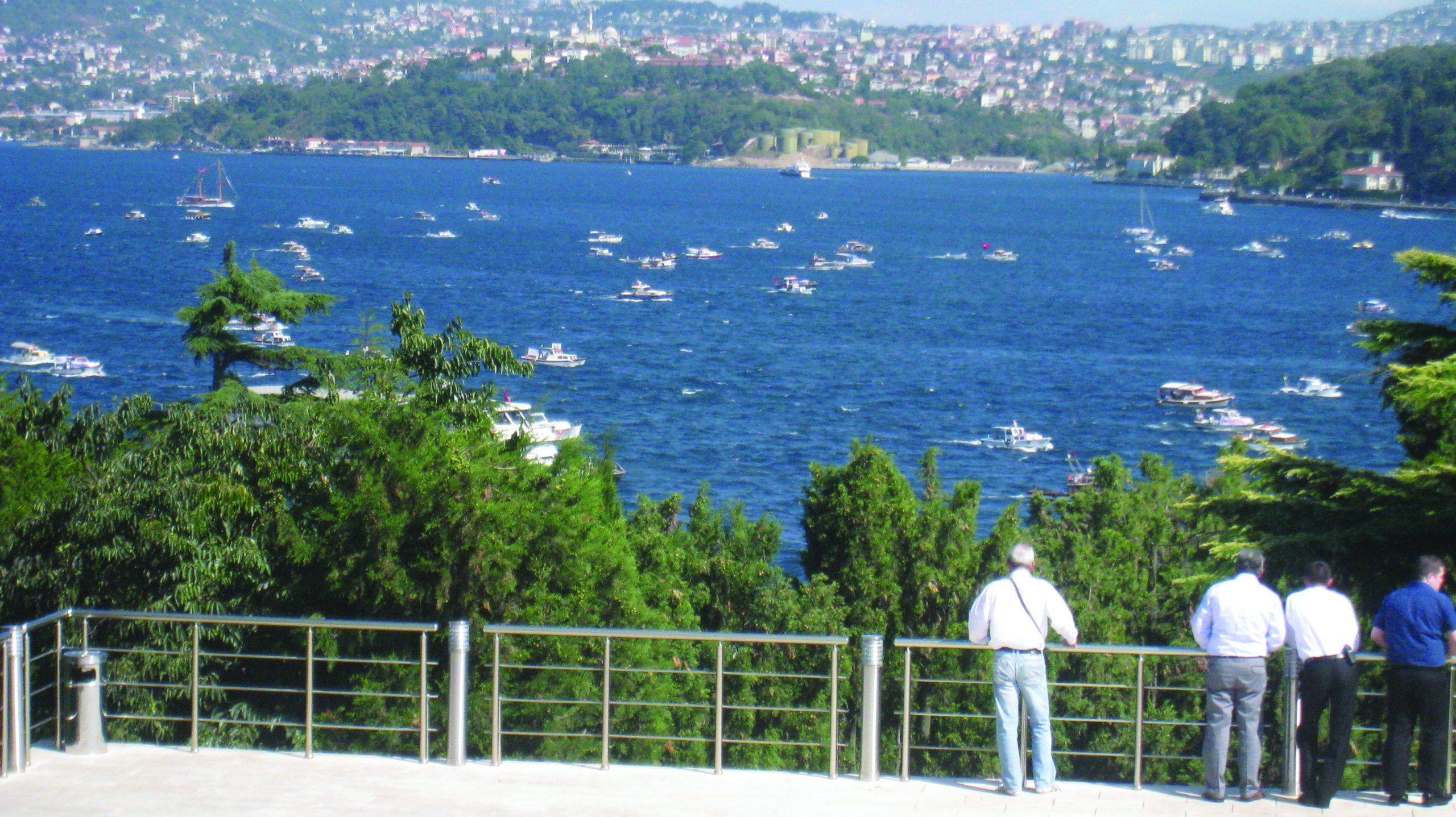
Sophie Calle. Voir Le Mer. (View of Bophorus. For some inexplicable reason, all the boats were going one way that day), 2011.
Images courtesy of the author.
Footnotes
1 MRT is Singapore’s Mass Rapid Transit system of public transport.
2 Bintan is part of the Riau islands, Indonesian archipelago, and south of Singapore, about 50 minutes away by boat.
Essays
ON-ZONE Translated by David Williams
Merhan Karimi Nasseri, an Iranian better known as Sir Alfred, lived at Charles de Gaulle Airport from 1998 until 2006, and for much of this time was a kind of tourist attraction. Steven Spielberg’s 2004 film The Terminal was in part inspired by Nasseri’s life story. In contrast to Tom Hanks’ character in the film, Alfred spent most of his time reading. “It’s like a day at the library,” he said.
1.
A few years ago at Bucharest Airport I spotted a sign saying Zona fumatore, which simply means a smoking area, just it sounds way better in Romanian. You see all kinds of zones on your travels: free zones (zona franca), no-go zones, duty-free zones, you name it. West Germans used to call East Germany die Zone, by which they meant the Soviet Zone. There are time zones, erogenous zones, even Andrei Tarkovsky’s Stalker revolves around a zone. There’s a weight-loss diet called ‘The Zone’, and then you’ve also got zoning, in the sense of urban planning. In sci-fi, a zone is usually some sort of dystopia. Hearing the word ‘zone’, our first association is a clearly defined space, our second, their evanescence. Zones can be erected and dissembled like tents, ephemeral. Last but not least, there’s a form of literary life we might call the out of nation zone, best abbreviated as the ON-zone. I know a person who lives in that zone. That person is me.
I write in the language of a small country. I left that small country twenty years ago in an effort to preserve my right to a literary voice, to defend my writings from the constraints of political, national, ethnic, gender, and other ideological projections. Although true, the explanation rings a little phoney, like a line from an intellectual soap opera. Parenthetically, male literary history is full of such lines, but with men being ‘geniuses’, ‘rebels’, ‘renegades’, ‘visionaries’, intellectual and moral bastions etc., when it comes to intellectual–autobiographical kitsch, they get free passes. People only turn up their noses when it escapes a woman’s lips. Even hip memes like ‘words without borders’ and ‘literature without borders’ ring pretty phoney, too. The important point here is that having crossed the border, I found myself literally in an out-of-nation zone, the implications of which I only figured out much later.
It could be said that I didn’t actually leave my country, but rather, that splitting into six smaller ones, my country, Yugoslavia, left me. My mother tongue was the only baggage I took with me, the only souvenir my country bequeathed me. My spoken language in everyday situations was easy to switch but I was too old for changing my literary language. In a second language I could have written books with a vocabulary of about five hundred words, which is about how many words million-shipping bestsellers have. Unfortunately, my ambitions lay elsewhere. I don’t have any romantic illusions about the irreplaceability of one’s mother tongue, nor have I ever understood the coinage’s etymology. Perhaps this is because my mother was Bulgarian, and Bulgarian her mother tongue. She spoke flawless Croatian though, better than many Croats. On the off chance I did ever have any romantic yearnings, they were destroyed irrevocably almost two decades ago, when Croatian libraries were euphorically purged of non-Croatian books, meaning books by Serbian writers, Croatian ‘traitors’, books by ‘commies’ and ‘Yugoslavs’, books printed in Cyrillic. Mouths buttoned tight, my fellow writers bore witness to a practice that may have been short-lived, but was no less terrifying for it. The orders for the library cleansings came from the Croatian Ministry of Culture. Indeed, if I ever harboured any linguistic romanticism, it was destroyed forever the day Bosnian Serbs set their mortars on the National Library in Sarajevo. Radovan Karadžić, a Sarajevo psychiatrist and poet—a ‘colleague’—led the mission of destruction. Writers ought not forget these things. I haven’t. Which is why I repeat them obsessively. For the majority of writers, a mother tongue and national literature are natural homes, for an “unadjusted” minority, they’re zones of trauma. For such writers, the translation of their work into foreign languages is a kind of refugee shelter. And so translation is for me. In the euphoria of the Croatian ‘bibliocide’, my books also ended up on the scrap heap.
After several years of academic and literary wandering, I set up camp in a small and convivial European country. Both my former and my present literary milieu consider me a ‘foreigner’, each for their own reasons of course. And they’re not far wrong: I am a ‘foreigner’, and I have my reasons. The ON-zone is an unusual place to voluntarily live one’s literary life. Life in the zone is pretty lonely, yet with the suspect joy of a failed suicide, I live with the consequences of a choice that was my own. I write in a language that has split into three—Croatian, Serbian, and Bosnian—but in spite of concerted efforts to will it apart, remains the same language. It’s the language in which war criminals have pled their innocence at the Hague Tribunal for the past twenty years. At some point, the tribunals’ tortured translators came up with an appropriate acronym: BCS (Bosnian-Croatian-Serbian). Understandably, the peoples reduced and retarded by their bloody divorce can’t stand the fact that their language is now just an acronym. So the Croats call it Croatian, the Bosnians Bosnian, the Serbs Serbian, even the Montenegrins have come up with an original name: they call it Montenegrin.
What sane person would want a literary marriage with an evidently traumatised literary personality like me? No one. Maybe the odd translator. Translators keep me alive in literary life. Our marriage is a match between two paupers, our symbolic capital on the stock market of world literature entirely negligible. My admiration for translators is immense, even when they translate the names Ilf and Petrov as the names of Siberian cities. Translators are mostly humble folk. Almost invisible on the literary map, they live quiet lives in the author’s shadow. My empathy with translators stems, at least in part, from my own position on the literary map; I often feel like I’m invisible too. However, translating, even from a small language, is still considered a profession. But writing in a small language, from a literary ‘out-of-nation’ zone, now that is not a profession—that is a diagnosis.
The platitude about literature knowing no borders isn’t one to be believed. Only literatures written in major languages enjoy passport-free travel. Writerly representatives of major literatures travel without papers, a major literature their invisible lettre de noblesse. Writers estranged or self-estranged, exiled or self-exiled from their maternal literatures, they tend to travel on dubious passports. A literary customs officer can, at any time, escort them from the literary train under absolutely any pretext. The estranged or self-estranged female writer is such a rare species she’s barely worth mentioning.
All these reasons help explain my internal neurosis: as an ON–zone writer I always feel obliged to explain my complicated literary passport to an imagined customs officer. And as is always the case when you get into a conversation with a customs officer on unequal footing, ironic multiplications of misunderstandings soon follow. What does it matter, you might say, whether someone is a Croatian, Belgian, or American writer? “Literature knows no borders,” you retort. But it does matter: the difference lies in the reception of the author’s position; it’s in the way an imagined customs officer flicks through one’s passport. And although it would never cross our minds to self-designate so, we readers—we are those customs officers!
Every text is inseparable from its author, and vice versa; it’s just that different authors get different treatment. The difference is whether a text travels together with a male or female author, whether the author belongs to a major or minor literature, writes in a major or minor language; whether a text accompanies a famous or anonymous author, whether the author is young or old, Mongolian or English, Surinamese or Italian, an Arab woman or an American man, a homosexual or a heterosexual... All of these things alter the meaning of a text, help or hinder its circulation.
Let’s imagine for a moment that someone sends me and a fellow writer—let’s call him Dexter—to the North Pole to each write an essay about our trip. Let’s also imagine a coincidence: Dexter and I return from our trip with exactly the same text. Dexter’s position doesn’t require translation, it’s a universal one—Dexter is a representative of Anglo-American letters, the dominant literature of our time. My position will be translated as Balkan, post-Yugoslav, Croatian, and, of course, female. All told, a particular and specific one. My description of the white expanse will be quickly imbued with projected, i.e. invented, content. Customs officers will ask Dexter whether in the white expanse he encountered the metaphysical; astounded that I don’t live at ‘home’, they’ll ask me why I live in Amsterdam, how it is that I, of all people, got sent to the North Pole, and while they’re at it, they’ll inquire how I feel about the development of Croatian eco-feminism. Not bothering to read his work first, they’ll maintain that Dexter is a great writer, and me, not bothering to read my work first either, they’ll declare a kind of literary tourist guide—to the Balkan region, of course; where else?
To be fair, how my text about the North Pole will be received in my former literary community is also a question worth asking. As my encounter with the metaphysical? God no. Croats will ask me how the Croatian diaspora is getting on up there, how I—a Croatian woman—managed to cope in the frozen north, and whether I plunged a Croatian flag into the ice. Actually, in all likelihood my text won’t even be published. With appropriate fanfare they’ll publish Dexter’s. It’ll be called “How a great American writer warmed us to the North Pole.”
That literature knows no borders is just a platitude. But it’s one we need to believe in. Both originals and their translations exist in literature. The life of a translation is inseparable from the relatively stable life of its original, yet the life of a translation is often much more interesting and dramatic. Translations—poor, good, mangled, congenial—have rich lives. A reader’s energy is interwoven in this life; in it are the mass of books that expand, enlighten, and entertain us, that ‘save our lives’; the books whose pages are imbued with our own experiences, our lives, convictions, the times in which we live, all kinds of things.
Many things can be deduced from a translation; and let us not forget, readers are also translators. The Wizard of Oz, for example, was my favourite children’s book. Much later I found out that the book had traveled from the Russian to Yugoslavia and the rest of the East European world, and that it wasn’t written by a certain A. Volkov (who had ‘adapted’ it), but by the American writer Frank L. Baum. The first time I went to Moscow (way back in 1975) I couldn’t shake the feeling that I had turned up in a monochrome Oz, and that I, like Toto, just needed pull to the curtain to reveal a deceit masked by the special effects of totalitarianism. Baum’s innocent arrow pierced the heart of a totalitarian regime in a way the arrows of Soviet dissident literature never could.
Every translation is a miracle of communication, a game of Chinese Whispers, where the word at the start of the chain is inseparable from that which exits the mouth of whomever is at the end. Every translation is not only a multiplication of misunderstandings, but also a multiplication of meanings. Our lungs full, we need to give wind to the journey of texts, to keep a watch out for the eccentrics who send messages in bottles, and the equally eccentric who search for bottles carrying messages; we need to participate in the orgy of communication, even when it seems to those of us sending messages that communication is buried by the din, and thus senseless. Because somewhere on a distant shore a recipient awaits our message. To paraphrase Borges, he or she exists to misunderstand it and transform it into something else.
2.
According to data from the International Organisation for Migration, the number of migrants has increased from 150 million in 2000 to an estimated 214 million today, meaning that migrants make up 3.1 percent of the world’s population. Migrant numbers vary drastically from country to country: in Qatar, 87 per cent of the population are migrants; in the UAE, 70 per cent; Jordan, 46 per cent; in Singapore, 41 per cent. As a percentage, Nigeria, Romania, India, and Indonesia have the lowest numbers of migrants. Women make up 49 percent of the migrant population. Among the migrant population, 27.5 million are categorised as displaced persons, and 15.4 million as refugees. If all migrants were settled in a single state, it would be the fifth most populous in the world, after China, India, the US, and Indonesia, but ahead of Brazil. It’s a fair assumption that in this imagined migrant state, there would be at least a negligible percentage of writers, half of whom would be women.
Writers who have either chosen to live in the ON-zone, or been forced to seek its shelter, need more oxygen than that provided by translations into foreign languages alone. For a full-blooded literary life, such writers need, inter alia, an imaginary library—a context in which their work might be located. Because more often than not, such work floats free in a kind of limbo. The construction of a context—of a literary and theoretical platform, a theoretical raft that might accommodate the dislocated and de-territorialised; the transnational and a-national; cross-cultural and transcultural writers; cosmopolitans, neo-nomads, and literary vagabonds; those who write in ‘adopted’ languages, in newly-acquired languages, in multiple languages, in mother tongues in non-maternal habitats; all those who have voluntarily undergone the process of dispatriation1—much work on the construction of such a context remains.
In Writing Outside the Nation,2 some ten years ago Azade Seyhan attempted to construct a theoretical framework for interpreting literary works written in exile (those of the Turkish diaspora in Germany, for example), works condemned to invisibility within both the cultural context of a writer’s host country (although written in German) and that of his or her abandoned homeland. This theoretical framework was transnational literature. In the intervening years, several new books have appeared,3 and the literary practice of transnational literature has become increasingly rich and diverse. There are ever more young authors writing in the languages of their host countries: some emigrated with their parents, and speak their mother tongue barely or not at all; others (for cultural and pragmatic, or literary and aesthetic reasons) have consciously exchanged their mother tongues for the language of their hosts. Some write in the language of their host countries while retaining the mental blueprint of their mother tongue, giving rise to surprising linguistic melanges; others create defamiliarising effects by mixing the vocabulary of two or sometimes multiple languages. Changes are taking place not only within individual texts, but also in their reception. The phenomenon of literary distancing is one I myself have experienced. Although I still write in the same language, I can’t seem to follow contemporary Serbian, Croatian, and Bosnian literature with the ease I once did. I get hung up on things local readers wouldn’t bat an eyelid at. I sense the undertones and nuances differently to how they do, and it makes me wonder about the ‘chemical reaction’ that takes place inside the recipient of a text (in this case, me) when cultural habitat, language, and addressee have all changed. My relationship towards the canonic literary values of the ‘region’ has also changed. Texts I once embraced wholeheartedly now seem laughably weak. My own literary modus changed in the very moment I was invited to write a column for a Dutch newspaper. That was in 1992. I was temporarily in America, war raged in my ‘homeland’, and the addressee of my columns was—a Dutch reader.
I don’t know whether it’s harder to articulate the ON-zone or to live it. Cultural mediators rarely take into account contemporary cultural practice, in which, at least in Europe, ‘direct producers’ co-locate with a sizable cultural bureaucracy—from national institutions and ministries of culture, to European cultural institutions and cultural managers, to the manifold NGOs active in the sector. The cultural bureaucracy is primarily engaged in the protection and promotion of national cultures, in enabling cultural exchange. The bureaucracy writes and adheres to policy that suits its own ends, creating its own cultural platforms, and rarely seeking the opinion of ‘direct producers’. Let’s be frank with each other, in the cultural food chain, ‘direct producers’ have become completely irrelevant. What’s important is that cultural stuff happens, and that it is managed: publishers are important, not writers; galleries and curators are important, not artists; literary festivals are important (events that prove something is happening), not the writers who participate.
Almost every European host country treats its transnational writers the same way it treats its emigrants. The civilised European milieu builds its emigrants residential neighborhoods, here and there making an effort to adapt the urban architecture to the hypothetical tastes of future residents, discrete ‘orientalisation’ a favourite. Many stand in line to offer a warm welcome. Designers such as the Dutch Cindy van den Bremen, for example, design their new Muslim countrywomen modern hijabs—so they’ve got something to wear when they play soccer, tennis, or take a dip at the pool.
The hosts do all kinds of things that they’re ever so proud of, it is never occurring to them that maybe they do so not to pull emigrants out of the ghetto, but rather to subtly keep them there, in the ghetto of their identities and cultures, whatever either might mean to them; to draw an invisible line between us and them, and thus render many social spheres inaccessible. It is for this very same reason that the publishing industry loves ‘exotic’ authors, so long as supply and demand are balanced. Many such authors fall over themselves to ingratiate themselves with publishers—what else can they do? And anyway, why wouldn’t they?
Does transnational literature have its readers? And if it does, who are they? Publishers have long since pandered to the hypothetical tastes of the majority of consumers, and the majority’s tastes will inevitably reject many books as being culturally incomprehensible. If the trend of ‘cultural comprehensibility’—the standardisation of literary taste—continues (and there’s no reason why it won’t), then every conversation about transnational literature is but idle chatter about a literary utopia. And anyway, how do we establish what is authentic, and what a product of market compromise? Our literary tastes, the tastes of literary consumers, have in time also become standardised, self-adjusting to the products offered by the culture industry. Let’s not forget: the mass culture industry takes great care in rearing its consumers. In this respect, transculturality has also been transformed into a commercial trump card. In and of itself, the term bears a positive inflection, but its incorporation in a literary work needn’t be any guarantee of literary quality, which is how it is increasingly deployed in the literary marketplace. Today that marketplace offers a rich vein of such books, almost all well-regarded, and their authors, protected by voguish theoretical terms—hybridity, transnationality, transculturality, postcolonialism, ethnic and gender identities—take out the moral and aesthetic sweepstakes. Here, literary kitsch is shaded by a smoke screen of ostensible political correctness, heady cocktails mixing East and West, Amsterdam Sufis and American housewives, Saharan Bedouins and Austrian feminists, the burqa and Prada, the turban and Armani.
And where are my readers? Who’s going to support me and my little homespun enterprise? In the neoliberal system, of which literature is certainly part and parcel, my shop is doomed to close. And what happens then (as I noted at the beginning) with my right to defend my texts from the constraints of political, national, ethnic, and other ideological projections? My freedom has been eaten by democracy—that’s not actually a bad way to put it. There are, in any case, any number of parks in which I can offer speeches to the birds. What is the quality of a freedom where newspapers are slowly disappearing because they’re not able, so the claim goes, to make a profit; when departments for many literatures are closing, because there aren’t any students (i.e. no profit!); when publishers unceremoniously dump their unprofitable writers, irrespective of whether those writers have won major international awards; when the Greeks have to flog the family silver (one of Apollo’s temples in Athens is rumoured to be going under the hammer); when the Dutch are fine about closing one of the oldest departments for astrophysics in the world (in Utrecht), because it turns out that studying the sun is—unprofitable.
“Things are just a whisker better for you, because like it or not, at least you’ve got a kind of marketing angle. But me, I’m completely invisible, even within my own national literature,” a Dutch writer friend of mine kvetches. And I mumble to myself, Christ, my brand really is a goodie—being “a Croatian writer who lives in Amsterdam” is just the sexiest thing ever. But I understand what my Amsterdam acquaintance is going on about. And really, how does one decide between two professional humiliations—between humiliating invisibility in one’s ‘own’ literary milieu, and humiliating visibility in a ‘foreign’ one? The latter visibility inevitably based on details such as the incongruence between one’s place of birth and one’s place of residence, the colour of one’s skin, or an abandoned homeland that has just suffered a coup d’état. My Dutch acquaintance isn’t far from the truth. Within the context of contemporary Dutch literature, or any other literature, where there is no longer any context; where there is no longer literature; where it is no longer of any importance whatsoever whether anyone reads a book so long as they’re buying them; where it is no longer of any importance whatsoever what people read, as long as they’re reading; where the author is forced into the role of salesperson, promoter, and interpreter of his or her own work; only in such a deeply anti-literary and anti- intellectual context, I am forced to feel lucky to be noticed as a “Croatian writer who lives in Amsterdam,” and what’s more, to be envied for it.
By now it should be obvious, the little pothole I overlooked when I abandoned my ‘national’ literature is the sinkhole of the market. Times have certainly changed since I exited the ‘national’ zone and entered my ON-zone. What was then a gesture of resistance is today barely understood by anyone. (Today, at least in Europe, recidivist nationalisms and neo-fascisms are dismissed as temporary, isolated phenomena.) Of course, not all changes are immediately apparent: the cultural landscape remains the same, we’re still surrounded by the things that were once and are still evidence of our raison d’être. We’re still surrounded by bookshops, although in recent years we’ve noticed that the selection of books has petrified, that the same books by the same authors stand displayed in the same spots for years on end, as if bookshops are but a front, camouflage for a parallel purpose. The officer in charge has done everything he should have, just forgotten to periodically swap the selection of books, make things look convincing. Libraries are still around too, although there are less of them: some shut with tears and a wail, others with a slam, and then there are those that refuse to go down without a fight, and so people organise petitions. Literary theorists, critics, the professoriate, readers, they’re all still here; sure, there aren’t many of them, but still enough to make being a writer somewhat sensical. Publishers, editors, agents, they’re all still in the room, though more and more often it occurs to us that they’re not the same people anymore. It’s as if no one really knows whether they’re dead, or if it’s us who’re dead, just no one’s gotten around to telling us. We’ve missed the boat on heaps of stuff. It’s like we’ve turned up at a party, invitation safely in hand, but for some reason it’s the dress code all wrong.
Literary life in the ON-zone seems to have lost any real sense. The ethical imperatives that once drove writers, intellectuals, and artists to ‘dispatriation’ have in the meantime lost their value in the marketplace of ideas. The most frequent reasons for artistic and intellectual protest—fascism, nationalism, xenophobia, religious fundamentalism, political dictatorship, human rights violations, and the like—have been perverted by the voraciousness of the market, stripped of any ideological impetus and imbued with marketing clout, pathologising even the most untainted ‘struggle for freedom’, and transforming it into a struggle for commercial prestige.4
For this reason it’s completely irrelevant whether tomorrow I leave my ON-zone and return ‘home’, whether I set up shop somewhere else, or whether I stay where I am. For the first time I can see that my zone is just a ragged tent erected between the giant tower blocks of a new corporate culture. Although my books and the recognition they have received serve to confirm my professional status, they offer me no protection from the feeling that I’ve lost my ‘profession’, not to mention my right to a ‘profession’. I’m not alone, there are many like me. Many of us, without having noticed, have become homeless: for a quick buck, others, more powerful, have set the wrecking ball on our house.
Let’s horse around for a moment—let’s take the global success of E.L. James’s 50 Shades of Grey seriously (you can’t not take those millions of copies sold seriously!), and baldly assert that the novel is the symbolic crown of today’s corporate culture. And if we read the novel as exemplary of corporate culture—financial power as the only currency; the anonymous commutability of the surrounding class of ‘oppressed’ chauffeurs, secretaries and cooks who serve Christian and Anastasia; sado-masochism as the organising principle of interpersonal relations in all domains, including sex; brutality, vulgarity, violence, materialism; people being either masters or slaves— there’s no chance of us missing a particular detail. At one point Christian gives Anastasia an ‘independent’ (naturally!) publishing house as a little present. And thus, in this symbolic setting, my literary fate (and the fates of many of my brothers and sisters of the pen) depends entirely on the symbolic pairing of Anastasia and Christian. In this kind of setting, indentured by the principle of publish or perish, I belong to the servant class and can only count on employment as Anatasia and Christian’s shoe-shine girl. And so it is my spit that softens their shoes, my tongue that licks them clean, my hair that makes them gleam.
Lamenting the death of the golden era of critical theory, Terry Eagleton memorably observes: “It seemed that God was not a structuralist.” But it seems that God was not a writer either, certainly not a serious one. He slapped his bestseller together in seven days. And this all gets me thinking—if I’ve already bet my lot in life on literary values and lost—maybe I should bet my few remaining chips on their future. Because who knows, perhaps tomorrow, on my every flight of fancy, a translucent book, letters shimmering like plankton, will appear in the air before me; a liquid book into which I’ll dive as if into a welcoming sea, surfacing with texts translucent and alive like a shoal of sardines. Perhaps tomorrow books will appear whose letters will converge in the air like swarms of gnats, with every stroke of my finger a coherent cluster of words forming. It’s not so bad, I think, and imagine how in the very heart of defeat a new text is being born.
Footnotes
1 “By dispatriation I mean the process of distancing oneself more from one’s own native or primary culture then from one’s own national identity, even if, as we have seen, in a many cases the two tend to coincide.” Arianna Dagnino, “Transnational Writers and Transcultural Literature in the Age of Global Modernity,” Transnational Literature, 4.2 (May 2012).
2 Princeton, NJ: Princeton University Press, 2001.
3 In addition to Seyhan’s book, worth recommending are the edited collection Transnationalism and Resistance: Experience and Experiment in Women’s Writing, edited by Adele Parker and Stephenie Young (Rodopi, 2013), and the collections, The Creolization of Theory (Duke UP, 2011), and Minor Transnationalism (Duke UP, 2005), edited by Françoise Lionnet, and Shu-mei Shih respectively.
4 In May 2013, the nationalist Croatian Democratic Union (HDZ) launched its election campaign wearing a new ‘party’ dress. In place of the usual checkerboard coat of arms, gingerbread hearts, circle dances, and similar down-home kitsch, these Croatian rednecks came out with minimalist posters bearing Jean Paul Sartre’s “It is right to rebel!” slogan— poor old Sartre the ideological plume of Croatian conservatives!
Essays
Since Singapore gained independence in 1965, its economic, social and educational headways have stood out on the world stage, worthy of study by politicians, economists, sociologies, and educators alike. Yet its national and cultural identity is often called to question. Given its diverse immigrant historical cultural hinterlands far and wide, this young nation’s population composite is unsurprisingly inhomogeneous and mixed. Different artists have dealt with the situated complexities of identity and culture through different art forms and distinct styles.
Artist-photographer John Clang’s solo exhibition is one such interjection in this on-going discourse, bringing photographic representation and facet of Singaporean families to the spotlight. The ‘Family’ is widely accepted as the basic building block of the community, society and nation and is a theme Singaporeans are concerned about.
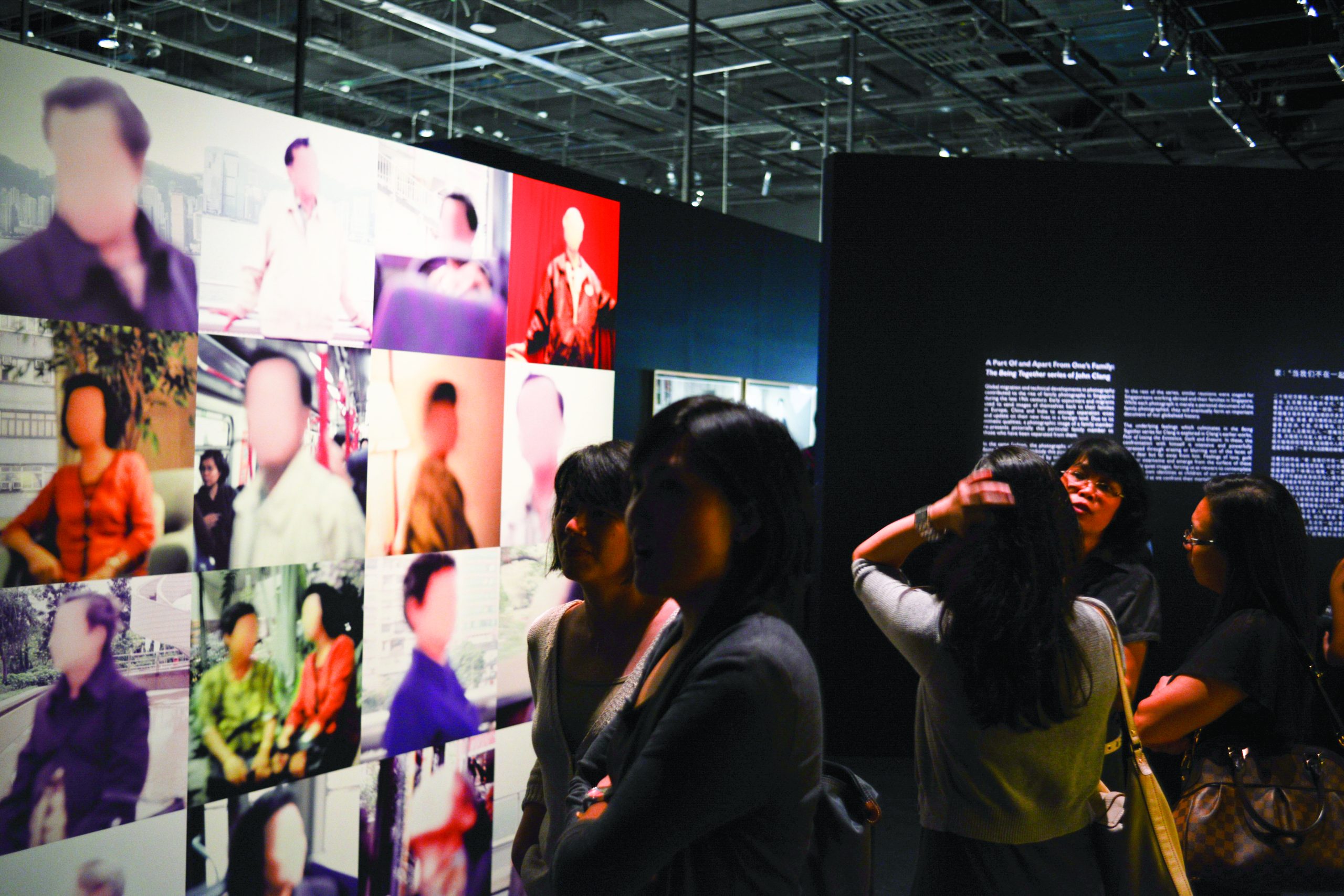
Being Together: Family & Portraits (2010), a grand solo exhibition by John Clang can be appreciated in two ways: first, as a lucid exposition on Singaporean identity and family relationships in the context of globalisation; second, as a loaded and engaging de-construct of the family portraiture genre in the light of burgeoning demand for image-making tools in a media hungry society. The photography style of Clang is unmistakable.
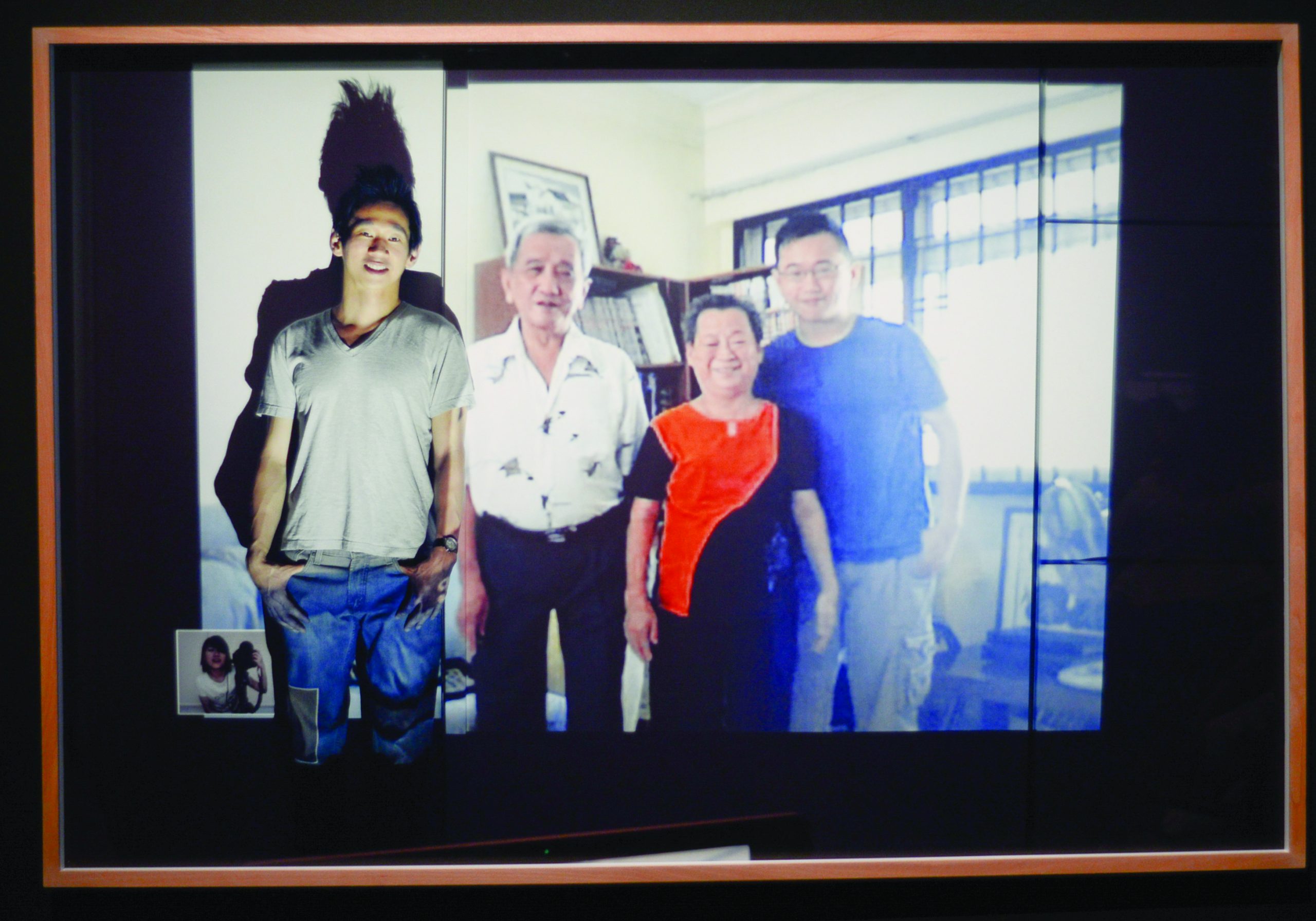
Being Together (Family), 2010, Fine art archival print, 40 X 60 inches
It is raw, divulging and compelling for a second look.
The five series in the exhibition are sentimental on many levels. Named Being Together, The Moment, Fear of Losing the Existence, Guilt and Erasurem are clearly portraitures of Singaporeans. As the curator for this exhibition Szan Tan aptly summarised: “Clang emphasizes the profound ordinariness of a family portrait for each depicted moment is ultimately to unite and not to idealize, glorify or celebrate, unlike traditional studio portraits… The simultaneous feeling of being part of and yet physically apart from one’s family is precisely what Clang had hoped to achieve.”
A tiny scribbled Confucius text on the wall suggests the personal significance of Clang’s reunion portraiture technique. The text, written in Mandarin1, loosely implies and translates as “If travel is a must, there must be a reason”. This refers to the personal responsibilities the artist has towards his own parents, and his temporary relocation overseas is a justified endeavour. The quote is an emblem of filial piety, a strongly held core value in Asian culture, as well as implying the concern parents may have when their children travel. From this text, we can feel the personal mission of Clang’s portrait series, as a means of connecting with his own parents and brother based in Singapore while he worked in New York. In this exhibition, he merely extended his photographic methodology to bring other people separated by distance and time zones together.
Being Together is the most extensive series out of five in the solo exhibition. It combines the warm, fuzzy, feeling we have towards taking family portraits with our fascination with communication technology. The photographs in this series show a family member and immediate kin standing or seated in a darkened room, against a projected Skype image of his or her family. From the title of each photograph, we know one party is abroad and the other lives in Singapore. Why the family members are separated by distance is not immediately known. From the homely furnishing, the viewer might infer rewarding circumstances as pull factors: for work, study, or extensive sojourning. The viewer might be able to tell the social status of the sitters from the objects and furniture in the photograph and projected image. Likewise, the body language of the sitters might well reflect their thoughts, feelings, and kinship ties to other people in the image.
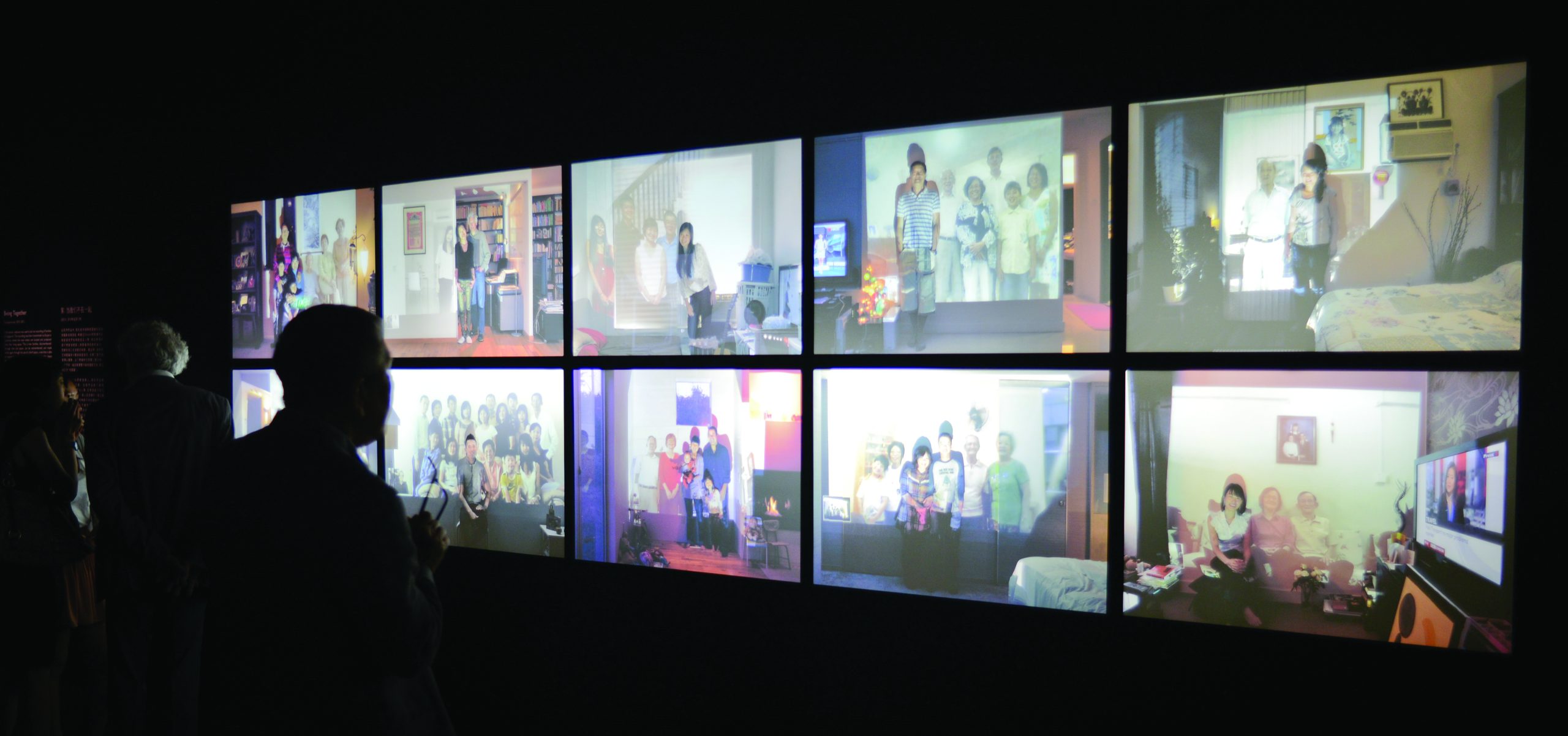
The habit and venture of taking family portraits is not unfamiliar to a Singapore audience. It can be an ordinary and casual snapshot against a perfectly banal scene, or an elaborate constructed studio photograph. Most Singapore households may have one hanging or displayed in the living room, bedroom, or communal place at home. Photographic portraits depicting newlyweds, children, family members or friends are common. Anecdotally, If there was a hierarchy for portraits, the family portrait might rank highly because it is displayed more so than other photographs. Quite simply, family portraits express family ties, close relationships, personal histories, and treasured stories about one’s family and their lives. If one wanted to be cynical then these family photographs portray how the families want to be seen—happy, idealized.
The images by Clang in this series are unsettling in three ways. First, the shadow cast by the figure nearest to the photographer disrupts the image, bringing attention to a suggested ruptured distance between the people in the photographs. Second, the blurriness of the figures, what is sharper, clearer or nearer to the photographer, implies a visual hierarchy. The (distant) background becomes a wispy connection with the foreground, marking the separation starkly. The image (and photographer) becomes a witness to a forlorn attempt to reunite family members in a virtual space. Third, it reveals our assumption of and value for a typical family structure in Singapore: parents with children or best with grandchildren.
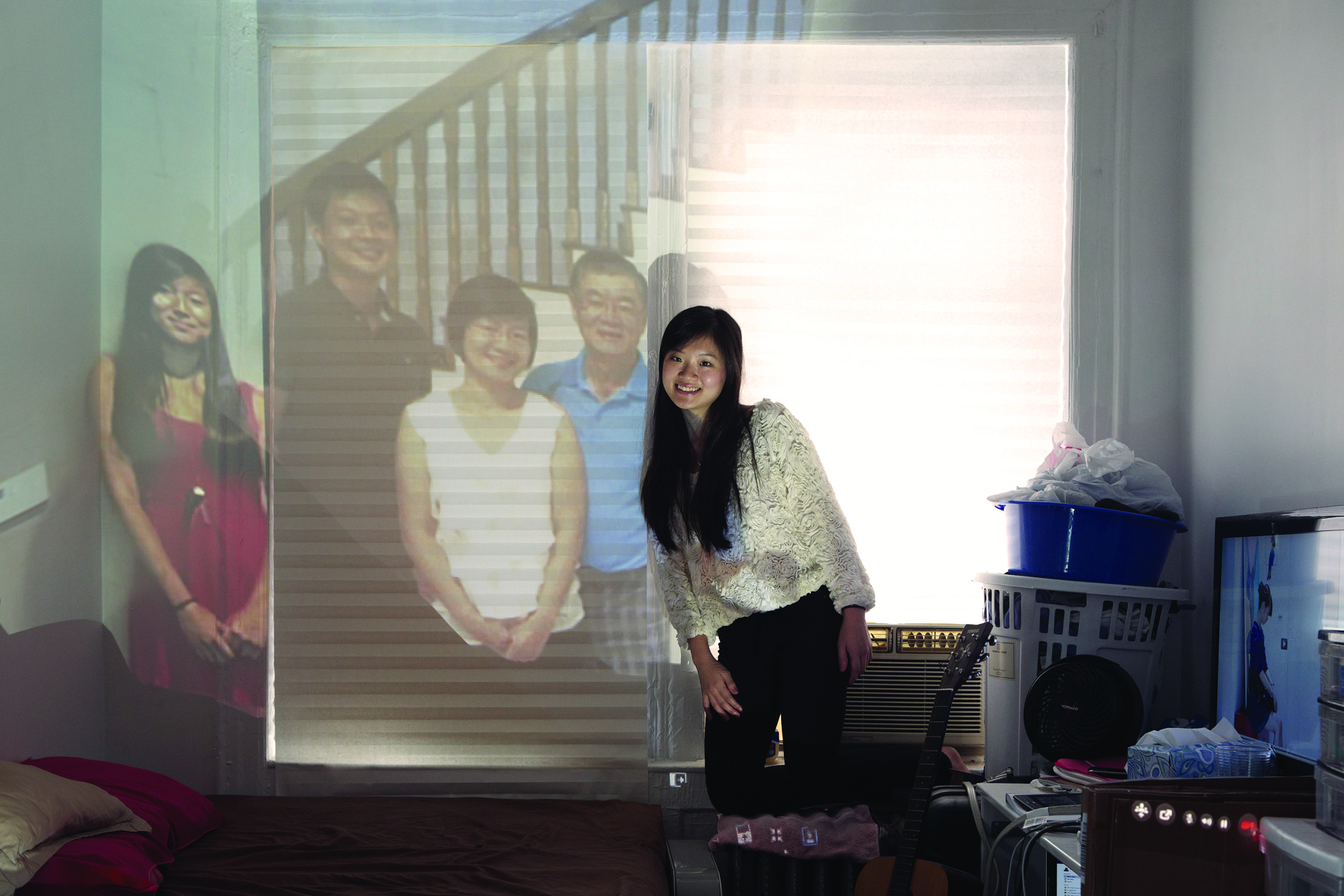
Being Together - Toh Family (New York, Los Angeles, Yio Chu Kang), 2012.
The photographs in this series plausibly represent family reunions for many Singaporeans in the near future. As Singapore embraces globalization, just as how its immigrant forefathers had, it would be soon be easy to find relatives working at some point in time in another part of the world. How exotic those locations depend on their appetite for adventure, opportunities or dire circumstances. These reunions are as real as they are, enabled by Internet video conferencing technology. If we want to, we can be emotionally connected to a person talking on the other end of a telephone call despite the distance. Conversely, the advent of smart phones might well have crippled our face-to-face communication skills, or introduced a poor excuse not to hold conversations with love ones sitting next to each other. Thus one could argue that the artist’s use of Skype in this photographic series is an acknowledgement of the evolving family nucleus2 in Singapore and their dependence on Internet-based communication technology to converse. If Singaporeans want to keep a particular standard and way of living evident in the photographs, they might have to travel, sojourn or relocate with their family or venture out alone. The Internet would be an important communication conduit to stay connected. The Internet is the port of call wherever we are.
The family is also the subject matter in The Moment series. Accordingly to Clang, this series explores a moment of family members being photographed together. He was interested in revealing the underlying ease or tension within “family hierarchies, gendered roles and inter-generational relationships”. Each triptych reveals a different family dynamic. In this series, each family is photographed from different viewpoints, like a “time-spliced” montage. The edges of the triptych photographs cruelly crop the sitters, resulting in an uneasy triptych picture. If photographs capture a certain truth about its subject, this presentation is more telling about the sitters. As a series, the concept of an idealized happy family is called to question. The individuality of the sitters might be revealed or concealed by their poses and body language: Is that a genuine smile or a deliberate wry one? Are the hands open and receptive, or tensed and clenched? Is the awkward cropping omitting something in order for our imaginations to fill in?
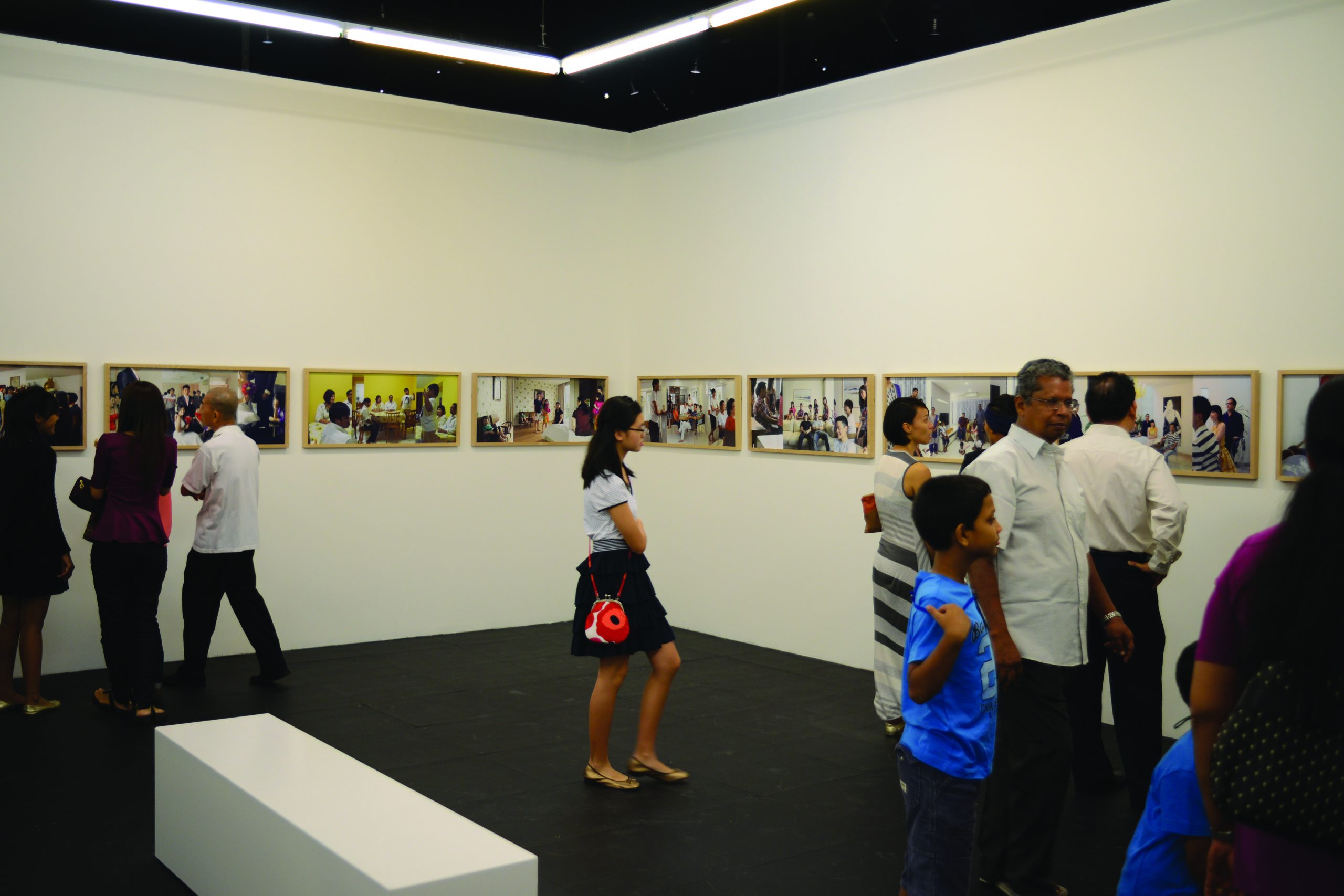
Assuming photographs can be read like texts, Clang’s photographic gesture and methodologies in both Being Together and Moment Series might be perceived as a deconstruction of the idea of a family. The family is often considered the most basic and universal construct in a society. The idea of the family can be considered important from cultural, moral, economical, religious and sociological perspectives. Any changes to these perspectives and values would change how we view the importance of a family as a way of life. According to the Singapore Department of Statistics, there are six household living arrangements3 that are quite telling of Singapore’s evolving family nucleus and living arrangements. Household living arrangements have evolved over the years in tandem with changes in the population’s life style, age structure as well as marriage and family formation preferences. The number of couple-based households with children declined from 66 per cent in 1990 to 56 per cent in 2010; correspondingly, couple-based households without children increased from 8.4 per cent to 14 per cent in 2010 while living alone households increased from 5.2 per cent to 12 per cent in 2010. These figures are consistent with population consensus figures on Singapore’s falling birth rate and increasing number of Singaporeans who chose to remain unmarried. By dissecting and fragmenting an image, we we might begin to see this as symbolising a fragmenting family structure.
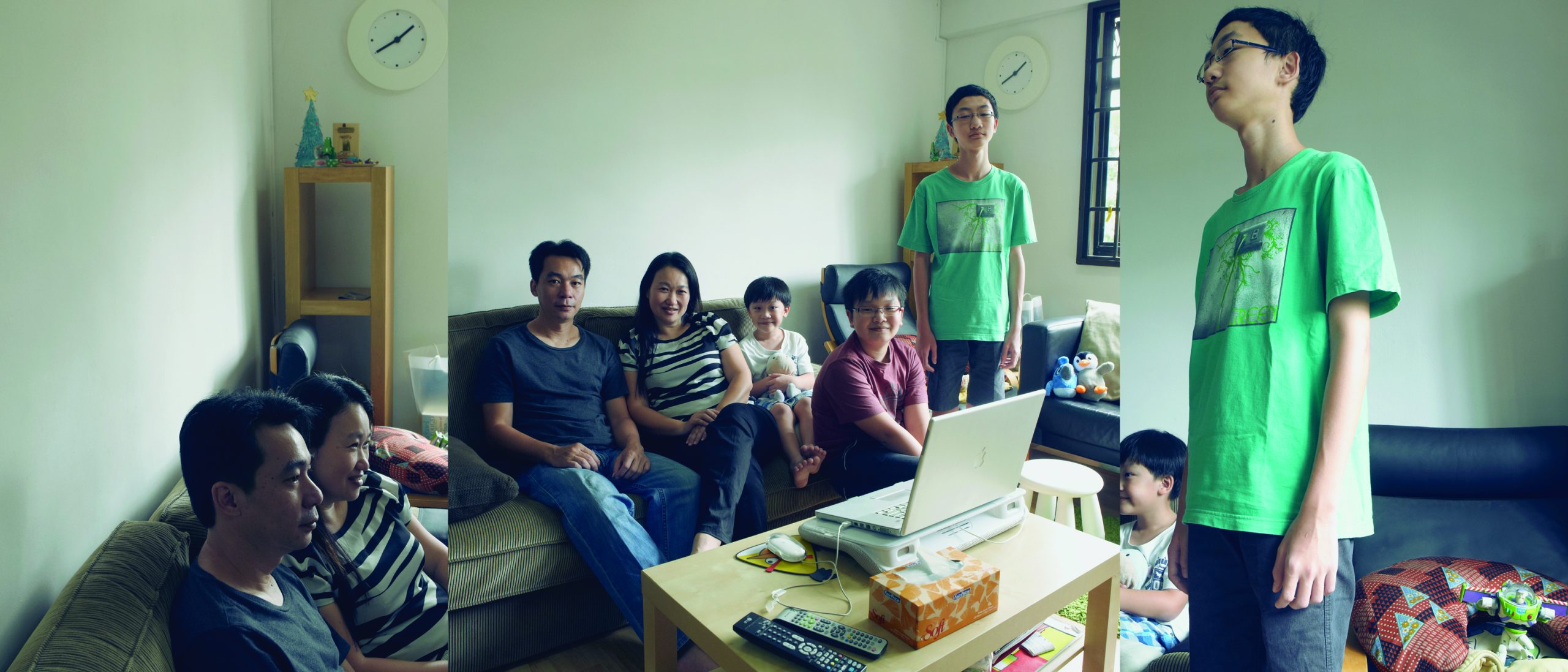
The Moment, 2011-2012. Courtesy of the artist John Clang.
According to Susan Sontag, “picture taking has been interpreted in two entirely different ways: either as a lucid and precise act of knowing, or conscious intelligence, or as a pre-intellectual, intuitive mode of encounter”. To Sontag, a photograph is often taken as an ordained and determined truth yet it is capable of becoming a site to unearth something one might not yet know. Clang’s photographs would be befitting to illustrate this concept, presenting images of Singaporean families for public scrutiny, thereby showing an outward representative Singaporean Identity. These families, like strangers we pass when we commute, are familiar yet atypical. A Singaporean might feel they know them from the objects and interior spaces portrayed. However, an informed viewer/reader will understand that photographs are mediated subjective constructs, and like poems, they elicit multiple interpretations; we create different personal meaning and significance for Clang’s series related to families. Yet identities are not constructed skin deep. We sometimes talk about personal identities, cultural identities or national identities. Identities, I would argue, are influenced by several factors that photographs are unable to represent fully and holistically: language, religion, class, education, professional, politics, values, beliefs, attitudes and deep-rooted culture. So we should hesitate to conclude that Being Together is illustrative of the Singaporean Identity.
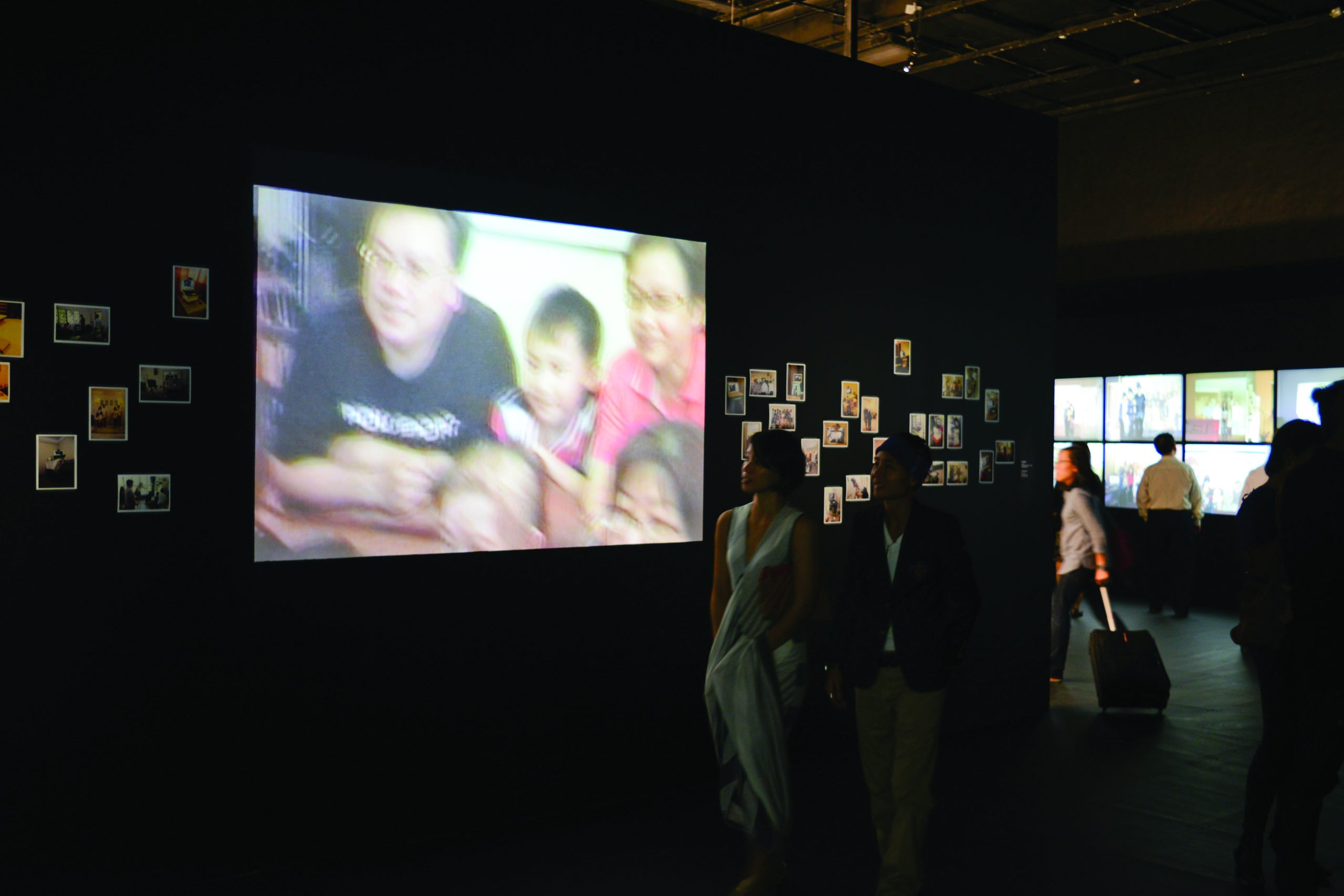
Clang’s methodologies could also be perceived as a deconstruction of photography as a visual language in its own right. The five series tackle and break the surface of an image. The time-honoured “rule of thirds” in photography, proportion, exactitude and texture of photographs are called to question. In some instances, the moving image is used to convey the process of taking a photograph, blurring the lines between preparation, the moment and the presentation of a ‘final’ image. In Being Together and The Moment, the compressed physical space in a photographic image is examined. In Being Together, the foreground and background exists in different time zones and locations and image is constructed from a physical presence and an image. In The Moment, the viewer has access to middle ground from the side, seeing things that would be traditionally blocked by the figures nearer the conventional picture plane. In contrast, Clang’s methodology in The Moment could be regarded as an antithesis to Henri Cartier-Bresson’s concept of decisive moment—which suggests how precise composition embodies the event being captured through photography. As an antithesis, one can imagine that every moment and instance is as precious as the next, and little intuition is needed to depress the shutter. In the Fear of Losing Existence, Guilt and Erasure Series, the identities of persons depicted in a photograph are deliberately concealed, criticizing both the editing and veracity of a photographic image. In Fear of Losing Existence, the faces are ominously blurred out rejecting representation. Likewise, in Erasure, the figures are reduced to pencil-like drawings, questioning the function and strength of photographs as surrogate for our memories. In Guilt, the faced are blanked out by correction fluid and scribbled with a handwritten text written over the dried white patch and as a repentant repeated text. This handwritten text adds more emotional charge than the original direct image.
As a tribute to the history of Family studios, three large backdrops were set up outside the exhibition gallery inviting visitors to take photographs with them. An image of a plain Housing Development Board window is cleverly included to link this exhibition to what most Singaporeans are familiar with, celebrating the everyday and notions of ordinariness. It might even encourage families to take their next family portrait by their own window. Next to this are two other backdrops forming two scenes from the old Raffles Museum and once popular theme park Haw Par Villa. Here, visiting tourists might take a candid photograph of themselves against the backdrop of Haw Par Villa’s past, like a back in time photographic souvenir of an unusual perspective of Singapore. For Singaporeans, the significance of doing so might be different. The difference will depend on how much we know about the places depicted by the backdrops, the people we take the photograph with, the meanings we attach to them, and how we might display them.
The affiliation to Singapore and the strength of the artist’s resistance to photographic norms has a role to play in fuelling the appeal of Clang’s work. Being Together has gathered significant media attention on the Internet. As mentioned in the introduction, Singapore is a fascinating country for different reasons and people are genuinely interested in its unique contexts. He has fully harnessed his knowledge of fashion photography and rejected its aesthetics. His works are probably as much a critique about the consumption of digital images and how they are made, as they are about families and portraiture. Each series often explore and exploit a particular conceptual and technical aspect of photography before he moves on. To some extent, his work is about dislocating what photography means to him (and the viewer), taking the subject out of context to make something familiar, unfamiliar. In doing so, he creates new meaning for the object (of representation) or subject, as well as the juxtaposed context. For example, Being Together is as much about being apart, and a subtle commentary of globalization and migration. Through photographing numerous families reunited through Skype, no means an easy feat, viewers might be able to reflect on their relationship to their families and contemplate about life, aging, happiness and regrets. All things considered, the photographic series by Clang are visually original, endearing and thought provoking if we look beyond the surface.
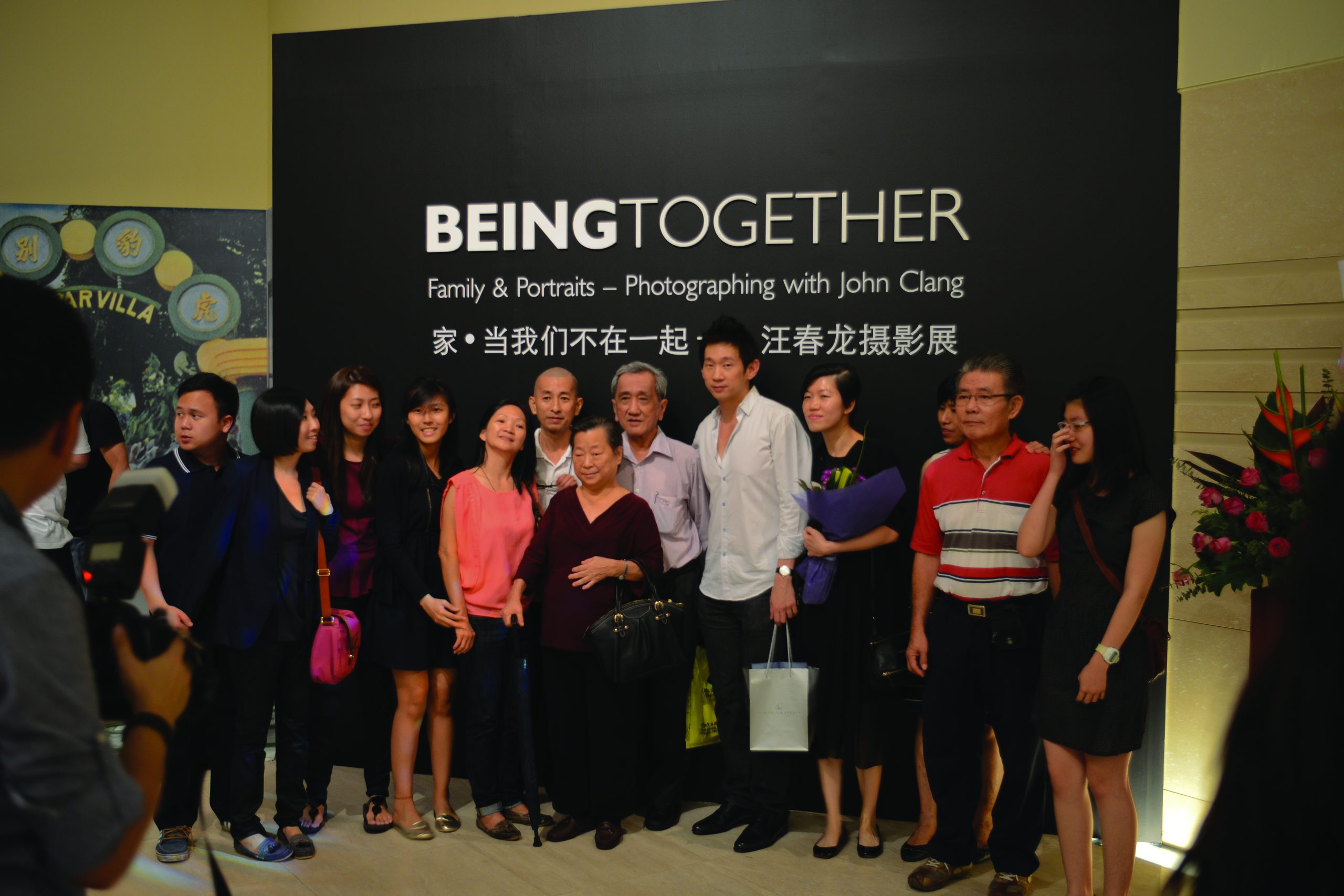
Except where stated, images courtesy of Lim Kok Boon.
Footnotes
1 孔子曰:父母在,不远游,游必有方(《论语里仁》)
2 According to Singapore’s Department of Statistics, a family nucleus in a household can be formed by (1) a married couple without children; (2) a married couple with never-married child(ren); or(3) one parent with never-married child(ren). A household can have one family nucleus, multiple family nuclei or none. Each nucleus comprises one or more generations.
13 Anderson, Imagined Communities, p. 11.
3 The six household living arrangements are: couple-based (with or without children), Lone Parent, (One person or Ever-married person) Living Alone, Other Households with Family Nucleus, Other Households without Family Nucleus.
References
Clang, J. (2013). Being together by John Clang. Singapore: Do Not Design.
Thangavelu, S. (2010). Making the Most of Globalisation. The Straits Times, Review, p. A26.
Koh, W.L. & Lee, Z.Y. (2014). Household Living Arrangement in Singapore, 1990-2010, Statistics Singapore Newsletter, Mar 2014 (ISSN: 0218-6810) Singapore Department of Statistics. Accessed 1 May 2014 from http://www.singstat.gov.sg/Publications/publications_and_papers/households_and_housing/ssnmar14-pg1-6.pdf
Susan Sontag (1977). On Photography, London: Penguin, p. 116.
Essays
He Zhiyuan
For most Singaporeans, the history of the island-state begins in 1819 with the arrival of Sir Thomas Stamford Raffles, who established it as a trading port for the East India Company. But you chose to begin your artistic career in 2003 with Utama – Every Name in History is I, an installation of paintings and a film about Sang Nila Utama—the neglected and forgotten pre-colonial founder of Singapore. Was this beginning at the pre-colonial beginnings of your country a deliberate choice?
Ho Tzu Nyen
There is a story about Raffles that I really like. In 1823, while living in his newly constructed bungalow on Bukit Larangan in Singapore, Raffles suffered from a bout of tropical fever. In the throes of his delirium, he received a vision or perhaps a visitation by the Malay kings who had come to this island some 500-600 years before him. It should be said that Bukit Larangan, in Malay, means the Forbidden Hill—so named because it was the sacred burial grounds of the ancient Malay ruling dynasty. Upon waking up, and still depressed, Raffles wrote to his friend William Mardsen, saying that the tombs of the Malay Kings are close at hand; and that if it is his fate to die here in Singapore, he shall take his place amongst these. Just as he has walked in their footsteps in the ‘founding’ of Singapore, he now dreams of following them to their graves.
Raffles was a child of the Romantic Age, which was the great age of dreams of origins and originality. And perhaps this romantic predisposition made him particularly sensitive to a form of haunting—a haunting by one’s predecessor, a feeling that one owes a debt to a precursor that can never be discharged, because the debtor is a phantom, a ghost-father. Ghost-fathers come in a multiplicity of guises and names. But to tell a story, one has to begin somewhere, and I chose to begin with Sang Nila Utama, the first king of the Malays, the one who was said to have given Singapore its name.
Utama was believed to have arrived on the island between the 13th and 14th centuries when he spotted a lion along the shores of the island, and thus gave Singapore its name. In Sanskrit, ‘Singa’ means lion, while ‘pore’ is derived from the word ‘pura’, or city. This founding was described in a most spectacular fashion in the The first edited text of the Sejarah Melayu, or the Malay Annals, was edited by Abdullah bin Abdulkadir Munshi (1796-1854; usually referred to as Munshi Abdullah) and published in Singapore in about 1831, though there have been disagreements over the actual publication date.']Malay Annals:1 ‘And they all beheld a strange animal. It seemed to move with great speed; it had a red body and a black head; its breast was white; it was strong and active in build, and in size was rather bigger than a he-goat. When it saw the party, it moved away and then disappeared. And Sri Tri Buana (another name for Utama) inquired of all those who were with him, “What beast is that?” But no one knew. Then said Demang Lebar Daun, “Your Highness, I have heard it said that in ancient times it was a lion that had that appearance. I think that what we saw must have been a lion”.’
But lions have never been a part of Singapore’s eco-system. To begin at the beginning is always to begin with fiction, and as fiction.
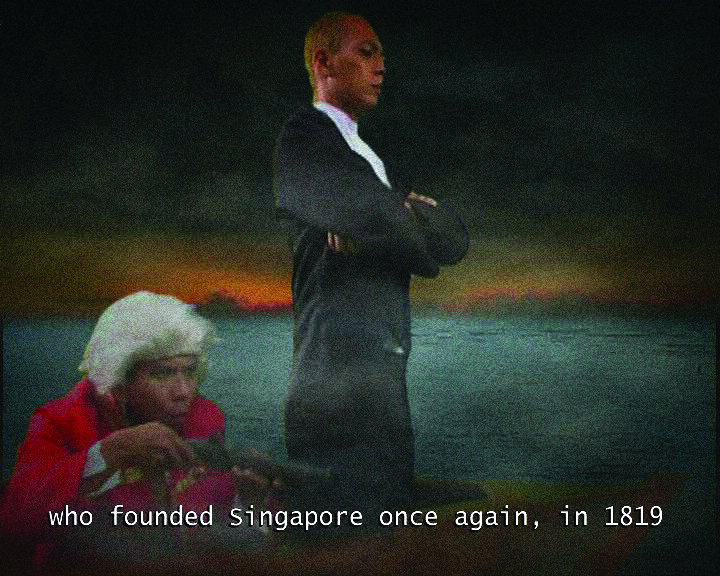
Raffles on his voyage of discovery. Still from video component of
Utama – Every Name in History is I (2003), DV, 23 min.
He Zhiyuan
This passage from the Malay Annals reminds me of the primal scene as it has been staged in psychoanalytic discourses – the moment where a child encounters a re- enactment of his or her own origin, which Freud dramatised as a traumatic witnessing of parental intercourse—an experience marked by sexual agitation and violence and which can only be recollected by the child in a disguised form.
He Zhiyuan
Freud was one of the greatest poets of originary myths. And the agitation and violence that you mentioned saturates the scene of this encounter with the ‘lion’. It is embodied by the great speed and monstrous appearance of the chimera. To contain this trauma, the chimera must be domesticated by being given a name. And in turn, this process of naming opens up to a process of wish fulfilment. We must understand the phantasmic projection of the lion as a manifestation of the desire to establish a new dynasty founded upon the legitimizing authority of the ‘singasana’ or the ‘lion throne’, a major symbol of Malay and Indonesian royalty. From the absence at the heart of origins, theatre emerges—theatre as simultaneously concealment and the projection of power.
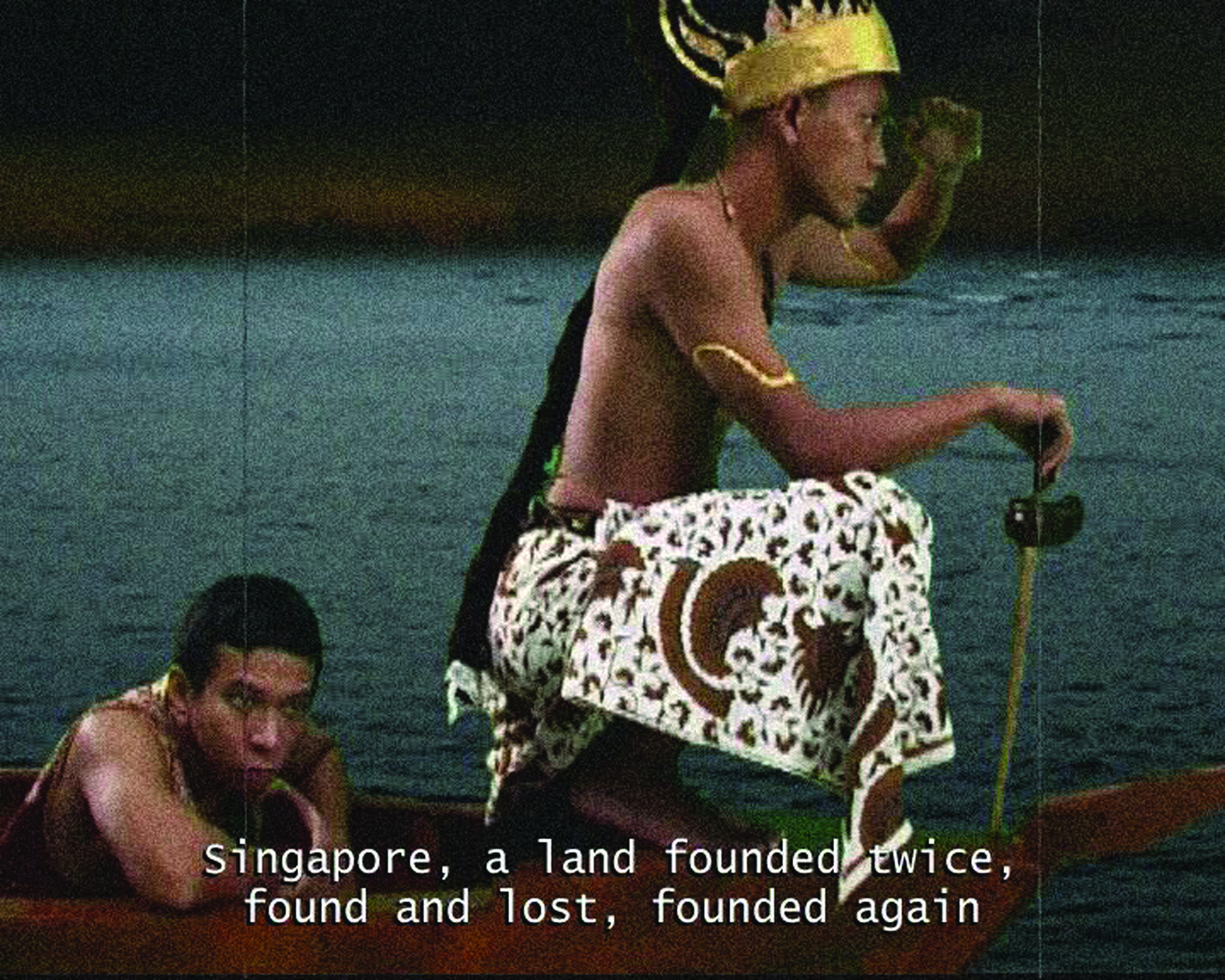
Utama on his voyage of discovery. Still from video component of
Utama – Every Name in History is I (2003), DV, 23 min.
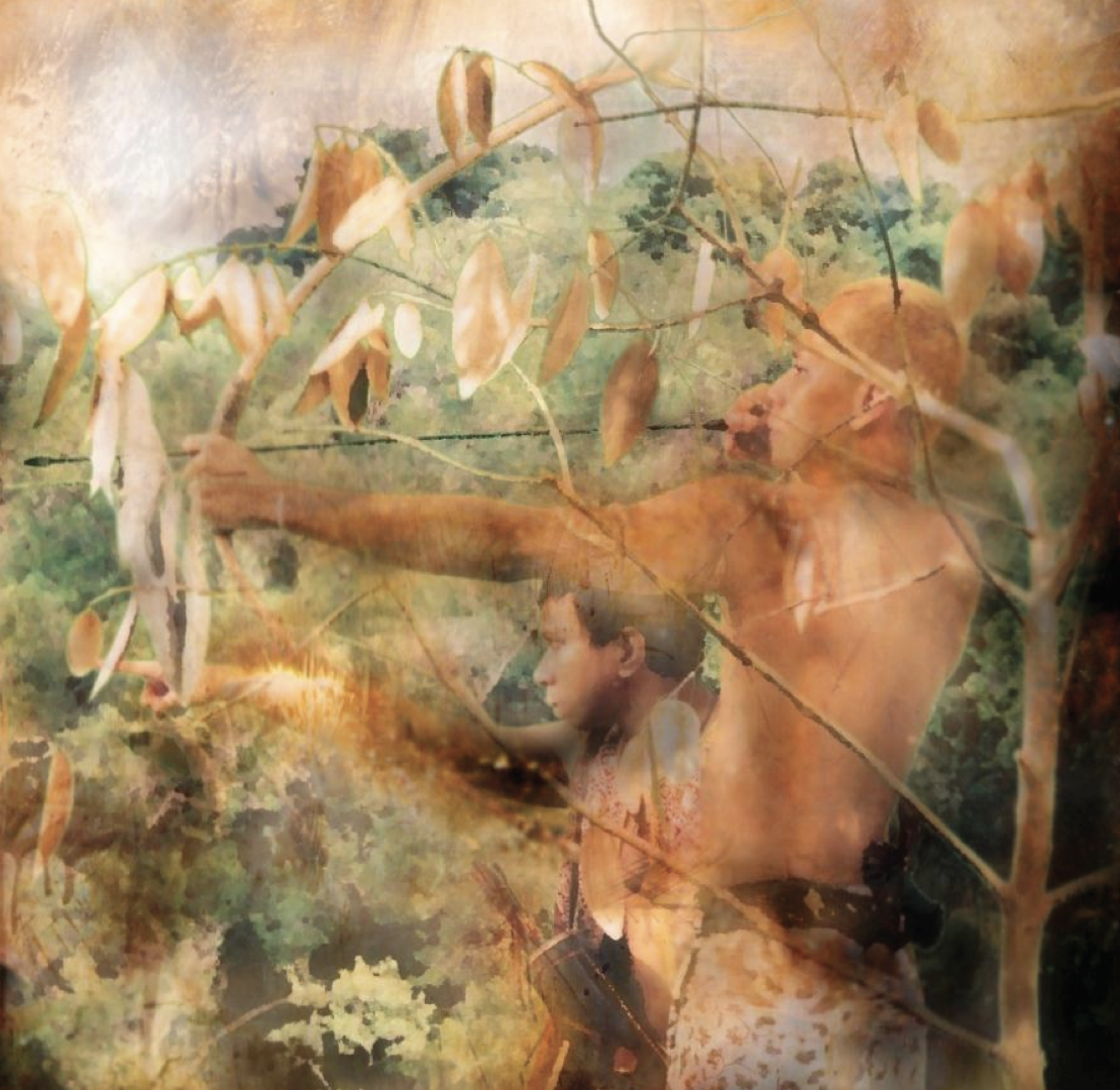
Utama at the Hunt for the Lion of Singapore
Painting from Utama – Every Name in History is I (2003), acrylic and ink on canvas
First published in http://www.performanceparadigm.net/wp-content/uploads/2012/08/stage-fright-and-various-failures-actual-final.pdf
Images courtesy of the author.
Footnotes
1 [Editor’s note:] The first edited text of the Sejarah Melayu, or the Malay Annals, was edited by Abdullah bin Abdulkadir Munshi (1796-1854; usually referred to as Munshi Abdullah) and published in Singapore in about 1831, though there have been disagreements over the actual publication date.
Essays
A Temporary Port of Call: Our Routes ⇆ Right Now in Bangkok
Thailand has been one of the world’s top tourist destinations for many years and Thai food now ranging now among the world’s favorite cuisines. Thai dance and theatre, however, have had little exposure on the world stage and their entries in encyclopedias are usually shorter than those on dance and theatre in such neighbouring countries as Cambodia and Indonesia. Within Southeast Asia as a whole, a foreigner’s experience of its performing arts, either from festivals in Europe and the US or in a certain Southeast Asian country, is mostly limited to traditional forms and stories. This contrasts with how Southeast Asian dance and theatre artists have studied and adapted both traditional and modern forms and stories from Europe and the US for several decades now.
Meanwhile, Singapore has been regarded as the region’s most prominent port of call as it is situated right in the middle of the trade route between the Indian and Pacific Oceans. As is popularly observed, Bangkok might instead have earned this status, were a canal dug at the narrowest point of the Indochina peninsula, the 44-kilometre Kra Isthmus. This applies not only for trade but in recent years for dance and theatre as well. Thanks to the much larger financial resource than those of its neighbouring countries, for many audiences Singapore is the region’s only destination to watch international tours of major dance and theatre productions from Europe and the US such as BAM, The Old Vic and Neal Street’s “The Bridge Project” and “Sylvie Guillem—6,000 Miles Away”, the latter co-produced by the Esplanade—Theatres on the Bay. Besides, often seen in many performing arts venues in Singapore are European and American producers who attend performances from neighbouring countries, which have been commissioned or supported by Singaporean producers. That is to say, Singapore has also become a gateway—if not a gatekeeper—for Southeast Asian dance and theatre.
Our Roots ⇆ Right Now: The Research Forum and Festival of Thai/ASEAN Contemporary Theatre
From 19 to 28 January, 2013, the Department of Dramatic Arts at Chulalongkorn University, Thailand’s first tertiary academic institution to offer bachelor’s and master’s degrees in western theatre, organised the inaugural event Our Roots⇆ Right Now. Billed as “the research forum and festival of Thai/ASEAN contemporary theatre”, it also included masterclasses, discussions and performances by mostly classically trained dance artists from seven Southeast Asian nations in addition to China and India as the ASEAN Economic Community (AEC), upcoming on January 1, 2015, wants to retain its close connection to these two countries outside the region.
Project director Dangkamon Na Pombejra, who chairs the department, explains that Our Roots⇆ Right Now is divided into four interconnected components: “Research”, “Revue”, Appreciation” and “Evaluation”. “Research” comprises “presentations of academic papers by various guests of honour, and research and creative works from the “Our Roots Right Now: Ramayana project”, which has been substantially supported by the Thailand Research Fund.”
“Revue” comprises “diverse contemporary performances developed from Thai/ASEAN cultural roots”. The curtain rose every evening at the Sodsai Pantoomkomol Centre for Dramatic Arts—the 16 meter by 25 meter by 10 meter black box theatre on campus—and one ticket is for a triple-bill. The program changed every two days. “Appreciation” includes “post-performance discussions, exchanges of experiences among artists, and workshop sessions.” “Evaluation” comprises “roundtable sessions that analyse and sum up the key insights and knowledge gained from the program.” These last three components were fully supported by the host university’s ASEAN budget.
Dangkamon Na Pombejra further said he hoped that “the diverse research presentations, performances, workshops, and assessments of contemporary Asian dance and theatre in this unique event will enable all artists, educators, and anyone interested in the arts to exchange information and experiences about creating dynamic and compelling contemporary performances.” Moreover, “by bridging original cultural roots with current lifestyles, arts, ethical themes, contemporary Thai and ASEAN dance and theatre will further develop their intellectual, aesthetic and social reaches.”
The ten-day forum and festival held 33 dance and theatre performances, 13 masterclasses, 27 academic paper presentations, and roundtable discussion sessions. Festival curators and producers from Austria, China, Korea and Singapore also visited this temporary port of call. It is noteworthy than the forum received more attention than the Bangkok Theatre Festival, the annual showcase of contemporary Thai theatre, which has been held every November by the Bangkok Theatre Network since 2002.
Overall, the forum and festival showed diverse examples of how artists in the region are working with traditional sources, in terms of both style and content. Attendance at the academic forum on the first two days was low, possibly due to English being the working language. Notably, the term ICHpa (Intangible Cultural Heritage in performing arts) was rarely mentioned in the presentations and in the discussions—perhaps an alarming sign for future research into this field. A good sign was that the performances, which made use of the more universal language of physical movement, were well attended. Many audience members at the Sodsai Pantoomkomol Centre for Dramatic Arts stayed after the triple-bill performance late in the evening to share their opinions with the artists. Unfortunately, like a great many first ASEAN-related cultural events taking place in Thailand recently in preparation for the AEC unification, the future of Our Roots⇆ Right Now remains unclear.
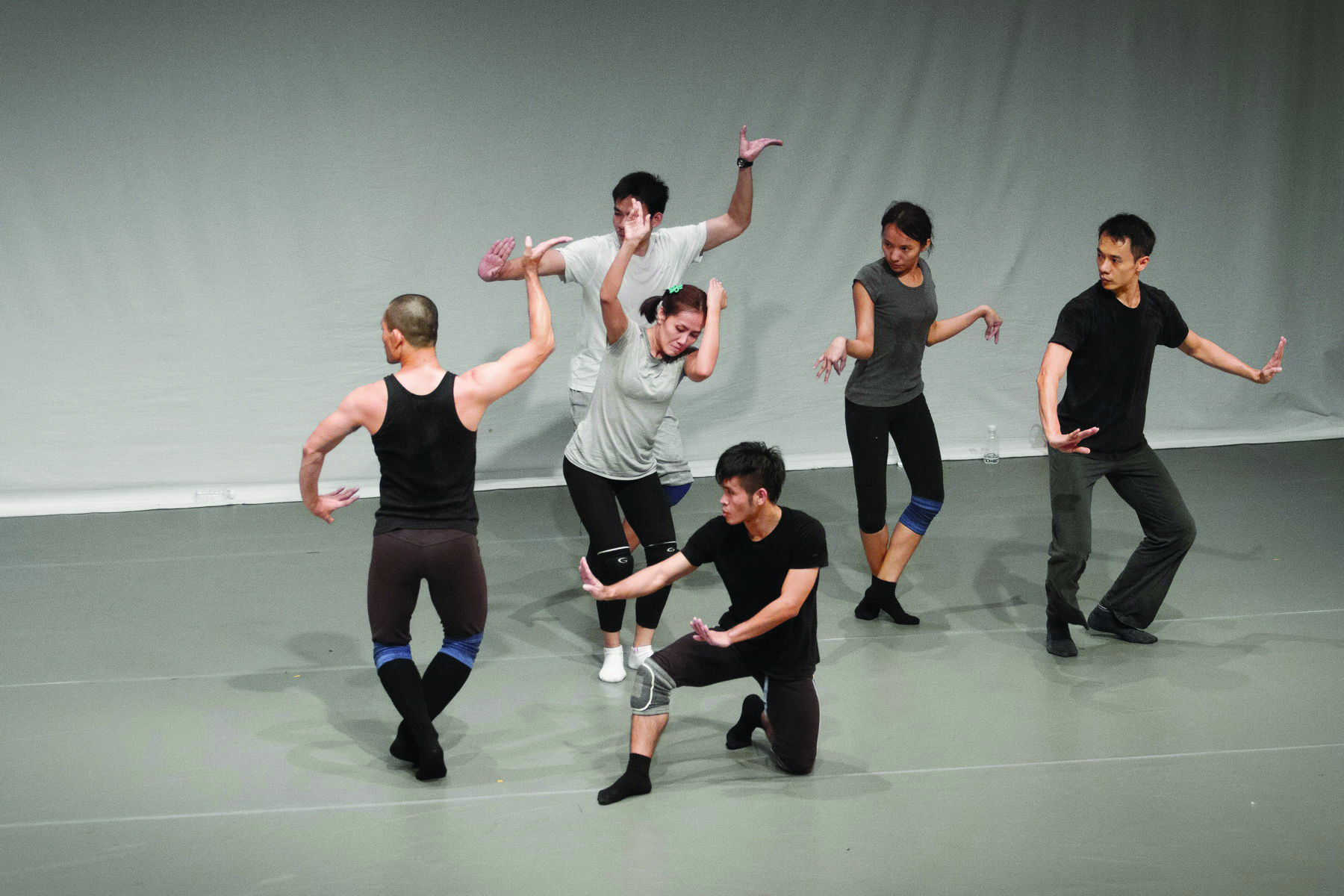
Representative Performances
Three performances seen at this temporary port of call are selected here for further discussion:
- Pichet Klunchun Dance Company’s Tam Kai
Renowned dancer and choreographer Pichet Klunchun, the most frequently travelled Thai performing artist in recent years, was honoured with a “Silpathorn Award in Performing Arts” by the Ministry of Culture’s Office of Contemporary Arts and Culture in 2006. In Europe and America, he is usually referred to as a Khon (classical masked dance theatre) performer, rather the opposite to what the Thai audience would do.
In the Thailand premiere of Pichet Klunchun Dance Company’s Tam Kai, Phra Lo, the hero in Thai literature Lilit Phra Lo was lured by a magically beautiful cock to travel to another city where he fell in love with two princesses, which finally led to their tragic doom. Klunchun had a different message here.
The seven dancers walked on to stage, each with his or her own tumbler of water. They queued at the upstage left corner and one by one moved in his/her individual style diagonally towards the downstage right corner. While some were slightly inspired by the one in front of him/her in the queue, others simply ignored it. For the next half hour, the audience witnessed a myriad of movements, generally diverse, thoroughly pleasant and frequently hilarious, from each individual dancer. One brought his tumbler to centre stage, took a sip of water: that was his dance.
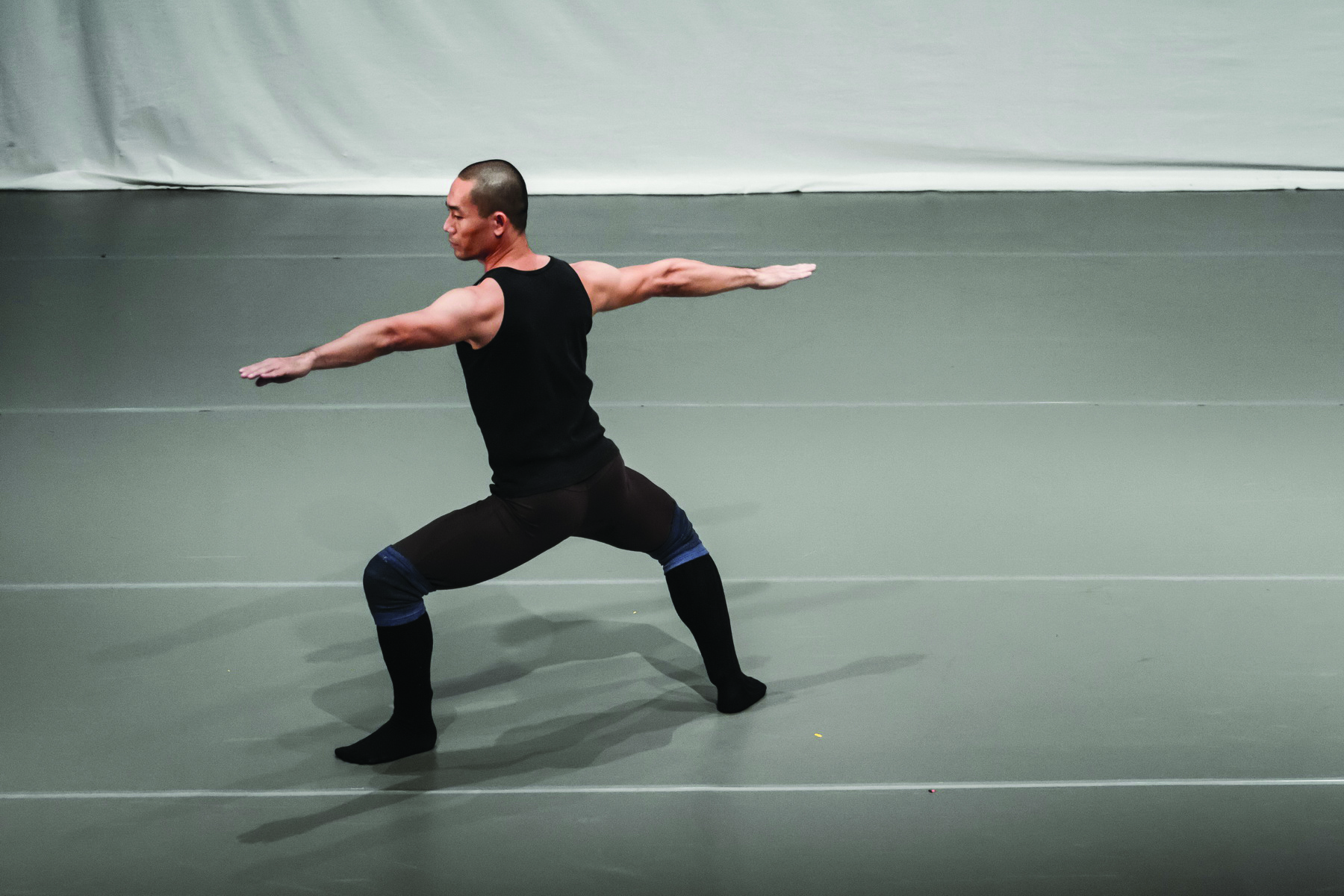
Afterwards, the dance movements shifted to classical Thai and the dancers performed the episode by the book, notwithstanding the rubber cock. A few “patrons” walked down from their seats in the stands. One gave Klunchun a large Thai garland to which many bank notes were attached; another took a “selfie” of the two of them with her smartphone and instantly uploaded it to her Facebook.
In Tam Kai, Klunchun, thus, was cheekily questioning whether contemporary Thai audiences are being lured by the beauty of our classical dance, thereby forgetting that there’s much more to it than just gorgeous movements. Another question was whether the rigidity of dance traditions is restricting the individual dancer in a contemporary art world filled with creative freedom. He also emphasised that Thailand’s contemporary dance is not only about the relationship between the past and the present, but also the here and the elsewhere, as we have opened our arms to foreign influences throughout our history.
Subsequently, Tam Kai was staged in eight cities in the Netherlands in October 2013. In February 2014, Klunchun also applied his production concept to recreate the work with workshop participants in Osaka. A contemporary dance work based on tradition, Tam Kai is still in the company’s repertory and its next ports of call are likely to be announced soon.

- Daniel Kok’s Q&A
Singaporean performance artist Daniel Kok made his Thailand debut with Q&A, a conceptual dance work that was commissioned by the Singapore Arts Festival in 2009, and later seen in Edinburgh, Lisbon, Hong Kong, Berlin and Vienna.
Kok, adorned in a striking red fur dress, first danced to a seven-minute excerpt from Puccini’s Madama Butterfly. He then changed into a white shirt, a tie, a business jacket and a pair of eyeglasses and still in his black underpants, pushed out a supermarket shopping cart from backstage and spoke to us through a microphone. With the help of a Powerpoint presentation on the screen and note cards in his hand, he explained that before arriving, he had conducted an online survey with his potential audience members, most of whom were present. In the survey, he had asked how they wanted him to perform his contemporary dance, covering topics like narratives, subject matter, general movement, aspects of dance, music and sound elements. Having analysed the survey results, he performed Madama Butterfly, incorporating the audience’s suggestions as best as he could, because he wanted his performance to be, in his word, “desirable”.
He then conducted a live survey with a fewer number of topics and adjusted his performance accordingly for his last dance. In the first evening, for example, the audience voted for pop and rock music, and accordingly he danced to Meatloaf’s “I’d Do Anything for Love (But I Won’t Do That)”; a day later, the audience voted for “traditional Thai music”, and so a Mo Lam (Northeastern Thai folk) song was being played. The audience on both evenings voted for “a mystery man” costume, and two stagehands wrapped yellow and black tape over parts of his limbs and body. His movements, however, largely remained the same notwithstanding the change in music. And that is one of the issues he wanted to discuss with the audience: “artists’ intentions” versus “audience’ expectations” in contemporary arts.
At one moment during the discussion monologue, Kok said that he would rather have his audience think about this performance after we left the theatre, than just expecting to enjoy it.
Q&A was staged as part of the evening’s quadruple bill that also included Bach Cello Suites and Ferocious Compassion by Cambodia’s Amrita Performing Arts and Chiang Mai-based dancer and choreographer Waewdao Sirisook’s Fauwn Leb/Identity, developed from the traditional northern Thai long-nailed dance. When the three artists shared the stage at the post-show Q&A, the audience witnessed just how diverse contemporary Southeast Asia is. An audience member asked Kok, who evidently does not have any training in traditional dance, to relate his performance to the theme of the festival Our Roots⇆Right Now. Kok replied that, despite being of Chinese descent, it was MTV music videos that inspired him to dance and noted that for him “contemporary” is everything that is happening here and now.
That triggered another observation. Contemporary performances from our region that are visiting ports of call for audiences from all around the world are mostly based on traditions, even though they are not purely traditional works any more. Yet, what most of us are watching more on our home soils are contemporary performances that are not based on traditions but deal with contemporary issues and are presented in modern styles.
Following Bangkok, the ports of call for Q&A were the Tokyo Performing Arts Market (Yokohama, February 2013), B:OM Festival (Seoul, March 2013), In Transit Festival (Berlin, August 2013) and Platforma Festival (Moscow, June 2014).
- Tanzconnexions’ Fire, Fire, Fire
Fire, Fire, Fire: Contemporary Southeast Asian Choreography featured three different versions of “Sita’s Trial by Fire”, an episode of Ramayana by three of the region’s leading choreographers: Sophiline Cheam Shapiro, Eko Supriyanto and Pichet Klunchun, and their companies, Khmer Arts, Solo Dance Studio and Pichet Klunchun Dance Company from Cambodia, Indonesia and Thailand respectively. The production was the final result of a two-year project fully funded by the Goethe Institut’s Tanzconnexions project and was seen in Phnom Penh before traveling to Our Roots⇆Right Now , and Jakarta and Solo afterwards.
In Bangkok, the full-house audience witnessed our multi-faceted Southeast Asia through three 20-minute dance pieces performed continuously without an intermission. Shapiro’s work was more literary—not just because of the Khmer lyrics with English surtitles—than the other two and did not venture as far from the tradition. It is reasonable to assume that this was the reason why it was the opener of the triple bill.
Klunchun played with the image of fire, and his company members’ movements looked like those of western modern dance yet also showed traces and the philosophy of classical Thai roots. It seemed that he was also trying to disappoint some audience members by not giving them what they wanted—the exotic images of Thailand. The most choreographically riveting of the three, Supriyanto worked on the notion of confrontation and showed how various traditions have been blended and processed into a unique contemporary dance vocabulary.
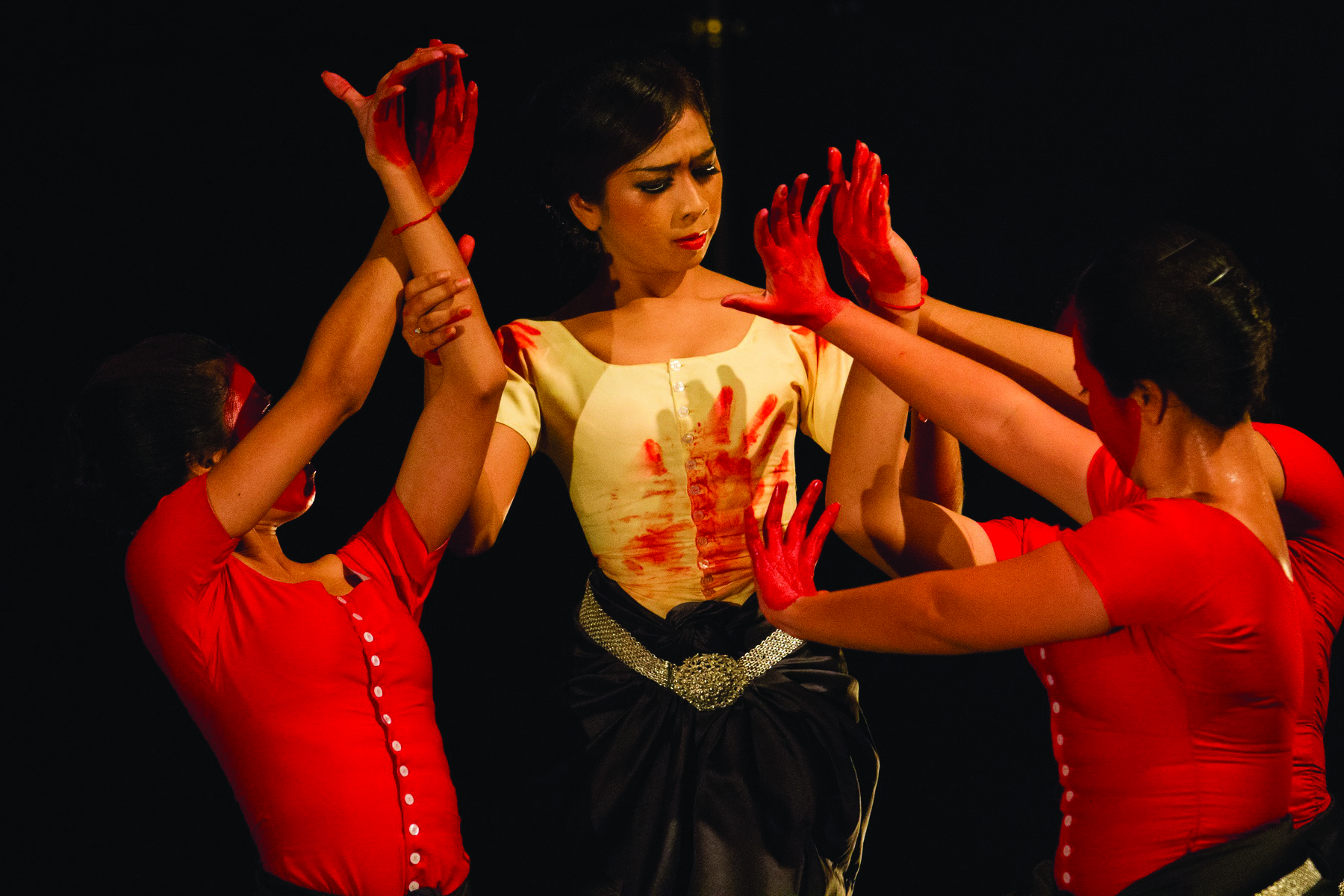
At the post-show discussion, which lasted as long as the performance itself, the three choreographers were joined onstage by Hong Kong’s experimental art pioneer and internationally revered theatre director, Danny Yung. Shapiro explained the development of this unique project over the past three years, saying that a production had not originally been planned, only a sharing of knowledge and ideas among the members of the three companies through workshops.
Curious about the collaboration, Yung asked why each choreographer did not try working with the dancers of the other two companies and why the show did not feature a fourth part—one they could have had created together. They did not give a direct answer, and the audience is left to assume that the reason is either they did not have enough time or that the dancers were still confined to their training and artistic director, or master. In any case, such a collaboration could perhaps be the next phase of development, once they become reacquainted with one another.
Klunchun reminded the audience that the three troupes are not representative of their countries, but in fact are, in his words, “trouble makers”, because of what they are doing to their dance and theatre traditions. He also noted that the differences in their three choreographic pieces show how time has progressed differently in each country, and that this also causes the modern features of the performances to vary, at least to a certain extent.

Nonetheless, this project serves as a possible model for the development of contemporary dance in the region although it is evident that we still have a long way to go.
There were no other ports of call for Fire, Fire, Fire. The scale of the production, with the total number of 30 cast and crew members from three countries, probably outweighed its artistic merits.
Conclusion
In contrast to the images of Southeast Asia being represented by touristic posters highlighting ancient sites and traditional cultures as well as the representative tradition-based performing art works that are being presented in festivals, which are perhaps more luring to European and American tastes, the aforementioned three performances in Our Roots⇆Right Now are not simply presenting exotic images. Instead, they show more complex, and realistic, images of contemporary Southeast Asia, with the relationships between and among “traditional” and “modern”; “local”, “foreign”, and “global”; as well as “intercultural” and “intra-cultural”.
Nevertheless, we should never forget the fact that tradition-based performance from this region travel farther, more frequently and conveniently. On the other hand, a number of contemporary dance and theatre performances by Southeast Asian artists, which are not based on their respective country’s traditions, but rather on western ones, were not part of this international platform. In other words, they had not filled any container at this temporary port of call.
For example, Thailand’s physical theatre company B-Floor staged their work Flu-O-Less-Sense in Tokyo; and Oxygen and Taste of Curry in New York City, without any support from Thailand’s Ministry of Culture. Also, it is doubtful that Democrazy Theatre Studio’s highly acclaimed production of Ionesco’s The Chairs in 2012 can find the next port of call by any invitation of a foreign producer, despite their being honoured with the highest prize by the Thailand center of the International Association of Theatre Critics.
As a citizen of a culinary heaven, I would like to conclude with a food metaphor. When my European and American friends ask me for a tip on how to find a good Thai restaurant overseas, my answer is, first, they should try to avoid the ones with such names that would be automatically associated with traditional Thailand as “Siam”, “Elephant” or “Sukhothai”—for example, my favourite authentic Thai restaurant in Michigan is simply called “Thai Thai”. My next tip is that they should look for ones without touristic posters, Thai musical instruments, Buddha images and waitresses in traditional Thai costumes—my best experience in overseas Thai restaurants have been in ones with no table cloths and waitresses in T-shirts and jeans. My last tip is to ensure that the majority of the patrons at the restaurant are themselves Asians.
Images courtesy of Sodsai Pantoomkomol Centre for Dramatic Arts.
Interviews
Initial discussions around International Arts Festivals refer to the Festivals as ‘ports of call’ - points of cultural import and export. Australian composer Jonathan Mills is completing his last term as Artistic Director of the Edinburgh Festival as Singapore theatre director Ong Keng Sen begins his first with the Singapore Festival. Jonathan Mills converses with theatre director and educator Aubrey Mellor about his sources and processes.
Jonathan Mills
In 2004, Ong Keng Sen and I started to think deeply about how Australia and Singapore related to each other. How our histories collided and how those stories might have actually formed a basis of artistic collaboration of a kind of sharing of memory and of empathy that can build us an alternative to ‘those’ history, because that’s what art offers. I also think it is important when thinking about the 50th anniversary of modern Singapore in 2015, to acknowledge one of the things I learnt first of all from Keng Sen in that process of collaboration. We look at Singapore as, I think quite rightly, a very successful multi-cultural society. And indeed it is. It is also as much a place that people arrive in, as they leave from. So much more, Singapore is the result of diaspora, rather than that there is a diaspora. Therefore the ever-present phenomenon of Singaporean ethos is stories from somewhere else finding root and finding locus in Singapore itself. Stories of migration, stories of migration that may be near or far, and stories of shared histories.
And this, I was reminded of, most powerfully on my very first visit to Singapore, when I travelled there with my father, and I was confronted as a ten-year old boy with a growing and very modern metropolis. What my father was able to do was excavate beneath that surface for me. Why is Orchard Road, Orchard Road? You wouldn’t know it today. You know it by its name, not by its powerful vegetation or association. It was a road of orchards, simple as that. So, everywhere one goes in Singapore now, there is a danger - unless you have a guide like Keng Sen or like my father, of forgetting where you really are, and of not understanding of what that history comprises. And I think that would be a great shame. Singapore has developed in remarkable ways, many of them economic, and many of them in terms of the economic prosperity of its citizens; it would be a great shame if that was the cost or at the expense of the broader sense of its history.
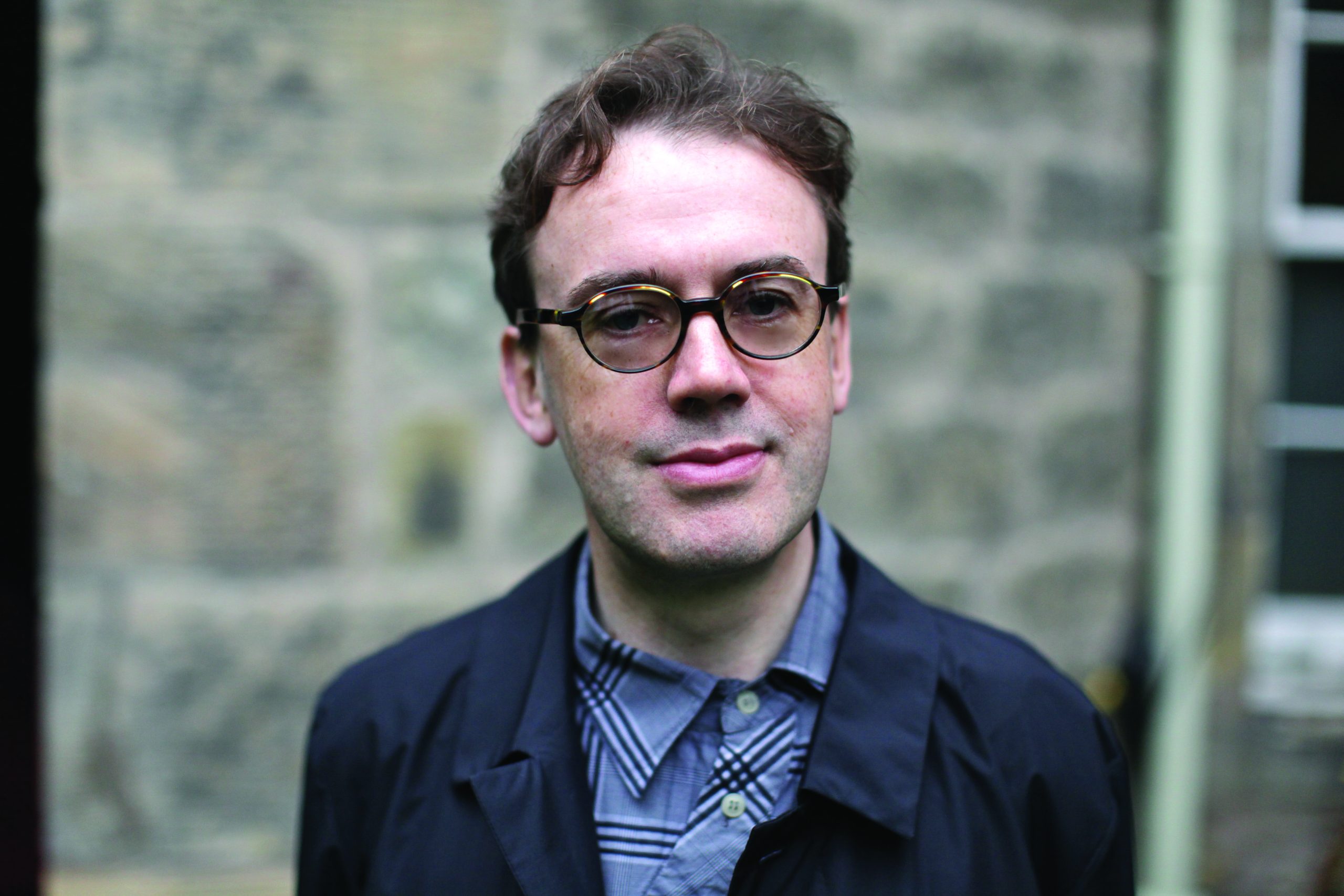
Jonathan Mills: photo by Seamus McGarvey
So when you start to think about the 50th anniversary of the founding of Singapore, my mind immediately casts itself back to those moments I spent in my father’s company where he was able to gently guide me around the Singapore he knew and relate it quite physically to the Singapore that we saw. I have to say it was a powerful experience because every time when I go back to Singapore, I remember that moment, that journey that I took with my father.
Aubrey Mellor
Your work suggests an interest in rescuing something that could be forgotten; and you have often talked of the power and fragility of memories. Your first acclaimed opera, The Ghost Wife (1999), recalls loneliness and violence in the Australian bush, a painful period that Australia seems to be forgetting. Singapore also tends to avoid the painful stories from the past and needs to be reminded of specifics. When we are caught up only in the contemporary we lose our roots—our emotional source—often the source of the things one doesn’t quite understand about oneself.
Jonathan Mills
My father was born in 1910 and therefore he was quite old when I was born. My grandfather was born in 1874. When I add my father’s memories of his father to my memories of my father and my own memories, I have a very different priority. I acknowledge that Australia has changed; it was always a very urban place, but its mythos came from places that were not always urban. The density of a European city is not the experience that one has of Australia. One has the experience of Australia as cities that keep rolling out endlessly - and where there is no end to its suburbia. There is a different sense of space. I wonder where are all the people? And I wonder because I am so prolifically attenuated as geographies that of course there are millions of people in each of those (Australian) cities and they are big bustling metropolises now. They don’t quite have that same density as a European City like Paris or London or Berlin. So I think even in our most urban and our most concentrated experience, the notion of what Australia might mean, to me represents something fundamentally different in terms of scale and in terms of geography and in terms of atmosphere, in terms of light, of sound and of the sheer size and scale of the place.
Aubrey Mellor
Singapore can’t keep spreading out, so it now goes upward, and is rapidly approaching the density of European cities. But issues of size, ethnicity, light, sound and scale are foremost in the minds of Singapore leaders and artists.
Jonathan Mills
The work that I’ve made, in some way, it’s always attempted to be a geography of imagination. That’s what I would say is underpinning of all the work that I’m interested in: it’s imagination and geography converging. Now, geography and imagination can be a psychological space. It can be a physical space. I am not making a judgement about where it is located. I’m saying that my particular interest in the imaginative process is necessarily mediated by geography. It is necessarily influenced by space itself. And I am always exploring and looking for those projects that will reflect in some way that notion of geography of imagination. Whether it is a woman in that perverse way, in that complex and seemingly contradictory way, in which a woman is trapped in the middle of nowhere, in endless space - especially in the European context - in the middle of vast open spaces, a woman would choose to lock herself into a tiny little hut. This simultaneous acrophobia and claustrophobia that you would experience in Barbara Baynton’s The Chosen Vessel, that Dorothy Porter so beautifully evoked in the libretto of The Ghost Wife.
Or a geography of memory (Mills’ second opera, Eternity Man, 2003) in terms of Arthur Stace, that nocturnal vagabond who, having been saved by virtue of stumbling into the Baptist church in Palmer Street in East Sydney. Not because he wanted to ‘get’ God or wanted to listen to the word of God, or because he was particularly having a religious epiphany, but because he needed something other than methylated spirits to drink, and some nourishment. He was promised that if he went to the service and listened to the sermon, there would be tea and cake served afterwards. And so, he goes into that Baptist tabernacle and he emerges out of it with a zeal—he was almost illiterate—and he had this zeal! Let’s remember that this is a man who did all of this, fifty, seventy a hundred years before Banksy — and he goes and writes the word ‘Eternity’ all over the pavement. What I imagined, and what Dorothy imagined, was in the quiet hours of the night, this man who would go and surreptitiously write this word as a kind of tribute to the city he loved, as a reminder to it citizens of something broader and bigger than themselves. That was his kingdom. In the evening, he was the monarch of all he surveyed, and he fell across the vagabonds of the night, the woman of the night, the prostitutes and the drug dealers and people having illicit sex and all sorts of people who were the murderers and the shysters. And we know very well that Sydney has that dark underbelly, but how amazing that this man was not discovered for fifty or sixty years. He went undiscovered and everyone was speculating who the Eternity man or the person who wrote this might be, a bit like Banksy. A person actually never met or discovered. And so, again, a geography of imagination.
And in the decision to write an opera from Murray Bail’s novel, Eucalyptus, again it is consistent, I believe, with this idea that there is a geography to our imagination, not just the psychology. And so it is in that forest of eucalyptus trees, that a young girl’s fantasy starts to blossom, and it is in that paradise that her father creates for her - he doesn’t really want her to leave. His motivation is not so much keeping her in prison there but to find a companion worthy of her in her kingdom, in her domain. But he misses the point entirely, of course. He misses the point that she will only stay there, only really feel comfortable there, if she’s able to grow, if it’s able to be her idea, her history, her mnemonic. Not his mnemonic. And, in a way, it’s at the point that the story, I think, in Murray Bail’s novel is most powerful: where he starts to beautifully suggest to us the ways in which we tell each other stories. The ways in which we learnt fact or fiction, and that how wonderful is it that the person who is the walking encyclopaedia doesn’t claim the heart of this young woman, but somebody who goes to the trouble of telling her some stories. Some of them are about trees, some of them are not. They all start in that general geography of imagination and they get her thinking. So we’ve got in a sense a narrative, a fairy story that tells us some very beautiful and subtle point about the difference between how we know and how we embody knowledge. And knowledge is not about facts; it’s about an embodiment of our whole selves.
Aubrey Mellor
You take a long time to just gestate these ideas? - because they come from somewhere quite deep.
Jonathan Mills
I work slowly, and I certainly have a long time to think about Eucalyptus, because I’ve been working in Edinburgh festival for the last eight years. And so, it’s not been wasted. Every time I see a work, every time I experience a piece of music or a piece of theatre, or a piece of dance, I am constantly thinking about it as an artist. Now is the time to leave the Edinburgh festival; I enjoyed every moment of it, most of them anyway, and what I will do is I will throw myself into working on an opera. I’ve been working with a librettist, because Dorothy Porter sadly died - on any case, I think she probably she wouldn’t wanted to adapt the work of a living writer like Murray Bail. Murray was clear he was not the person to write this libretto - I think he was right: he’s not a dramatic person. So we have a collaboration in the last two years with the rather marvellous Australian playwright who has lived in London since the early 1970s called Meredith Oakes. Meredith was a student of Peter Sculthorpe at Sydney University, so her first study was music. She reads music; she is a person highly literate in music. And yet she is Australian, because I did need somebody in this opera who understood. There are many opera projects where you wouldn’t need somebody who understands the atmosphere and the physical presence of something like a eucalyptus tree - its smell, its colours and its effect of the landscape. But Eucalyptus absolutely depends on somebody who has experienced those things, and can write about them from a deep knowledge and familiarity. So I was very lucky to find in London, somebody who is highly experienced librettist and a person who is very simpatico in evoking, and very familiar with that geography.
Aubrey Mellor
The actual moment of choice, when you feel that a particular subject is going to be something you will begin work on, was that spontaneous from reading the book?
Jonathan Mills
It was certainly from reading the book but of course you never quite know, Aubrey, whether it can be done. The moment I knew it could be done was when I had a very early draft from Meredith: the structure and the clarity she brought to the adaptation suggested a very clear dramatic form to me. So it was from our work together, which is happened in the last couple of the years that I realised that this could be done.
Aubrey Mellor
I believe one’s work often comes from long dormant, personal, unresolved issues. And they’re triggered by exposure to an often-contrasted element or person. The most unexpected person you meet - and suddenly these issues come up, and you want to create from that particular point of view. You being the son of a World War II survivor, I having had uncles killed in Malaya and New Guinea, what triggered Sandakan Threnody?
Jonathan Mills
Yes. I am the son of a survivor of the prisoners of the war accounts of North Borneo and Singapore. And I wrote a piece commemorating my father’s association with Malaysia, Singapore and with Borneo as a prisoner of war. I did it, as I judged—and I was accurate, in the last possible moment I could before that generation of Australians was to leave us. So I was rather good in my timing and lucky in a sense. My father was an optimist and even though he saw many terrible things happen during the Second World War, he never ceased to be optimistic. So the framework through which I see this is rather different from that of others. I know for example, there are a lot of people who experienced the nightmares, the psychological scars that their fathers bore as a result of these experiences. I have to say I didn’t. My father didn’t particularly bear those scars; and to the extent that he was an optimist, he went to Japan for his honeymoon. He went to Japan for his honeymoon partly because he wanted to find out what was it like—because he was a very practical person. He also wanted to make sure that, before he continued to think about Japan or not think about it at all, he had some first-hand experience of Japan itself—not of a handful of Japanese military people. So I saw it from a slightly different perspective in most people and my father encouraged me to go to Japan. Such long-dormant issues gave me encouragement to think about what one could do in practical terms for the survivors of that theatre of war, but most particularly for the survivors of Sandakan.

Images of Sandakan Threnody (2004), conceived and directed by ONG Keng Sen.
Photos courtesy of TheatreWorks (S) Ltd.
The actual trigger was, I think, around 1994-1995: the then Prime Minister Paul Keating opened what was the become the first of several Sandakan Memorials, at Ku-Ring-Gai Chase National Park on the border of Ku-Ring-Gai Chase National Park in Sydney. He opened this as Prime Minister but he stayed and he talked to all of us as families who were associated with that theatre of war, as an equal, as a person who had lost his uncle in Sandakan. Keating stayed well after the cameras had gone, well after all of the media attention had vanished. He stayed and sat with a group of old men, sitting in a rather beautiful part of the Australian bush and talking to them about their experiences and listening; and desperately listening to learn about what it was like in order, if you like, to fulfil his own family’s story and to understand what had happened to his mother’s brother. He was very humble, he was very simple, he was very dignified, and he gave me the idea, actually, that this story needed to be commemorated, needed to be thought about. And as a university student I had studied a number of contemporary pieces and the title of one that came to my mind as I was thinking about what form this piece should take and it was Threnody for the Victims of Hiroshima. But in fact, the word that struck me was ‘threnody’, comes from the Greek word thrēnōidiā or thrēnos which means a lament, an ode of grieving. And as I undertook some research into this, I realised that because life was so grim and suffering and hardship was so widespread, in Ancient Greek, in many ancient civilisations and in many ancient societies, there was no such thing as private grief. All grief had to be public. Society would be kind of basket case if you didn’t have that rule. You had to grieve, you had to do it there immediately; you had to do it very intensely, very physically. Then you had to move on. And it seemed to me that one of the things that we hadn’t done was that. We’d done in fact the opposite. We had a society denied our grief. We had governments that determined the facts were too horrific to be shared and therefore they were suppressed. After the war we wanted to trade with Japan; there is no argument about that, and there should be no confusion between the notion of trading and the notion of commemoration and grieving. You can do the two things; it all converges into something called the collective memory, if you like. So, I was determined that what I would try and do was do something with a public act, a public act of grieving. It wasn’t a grieving or an accusation against the Japanese. It was long past that. It was grieving for our people. It was a grieving of those who died in unmarked graves, whose deeds needed to be reimagined for a moment. It was a moment also to share with those who could bear witness to it. Who could in fact still remember, either the march or Sandakan, before they were removed, as many were, to Kuching in late 1944. So it was certainly in terms of writing Sandakan Threnody, it was a piece very personal; it was a piece very public as well. I happened to have a conversation, as I was writing it, as I was conceiving it, with Ong Keng Sen, the director of Theatreworks, Singapore. We discussed, the conversation flowed; and as we discussed this idea, we realised that, actually, the three places that were essential to this evocation: one was Singapore, because it was as a result of the fall of Singapore, that military debacle where everyone thought that the invasion would come from the sea and in fact it came down to the Malaysian Peninsula. My father was a surgeon stationed at what they imagined to be behind the enemy line, only to find himself right on the front line, to quickly to be evacuated to Singapore itself. So there was a very quick change of direction and catching up of military apparatus and scheduling and understanding that led to all these people being in Singapore itself. And then they were farmed out, as we know, to places like North Borneo, to Burma, some to Japan itself. So if one is thinking about the three territories or the symbolic territories in which this particular drama plays out, one is certainly Australia; one is certainly Singapore itself and another is Borneo, and the jungles of Borneo.
So when I wrote the piece, I kept in touch with Ong Keng Sen and we made a little proposal that my music, my threnody will form a basis of another version of the piece where he would use contemporary footage, his trademark style of documentary drama, and he would bring these various elements of Singapore, Japan, and Australia and Borneo all in a convergence, which is what he did. So in effect, the one piece that I wrote had in fact three outcomes. It was a regular feature, and it won the Prix-Italia for ABC radio; it was an orchestral piece for choir, orchestra and solo tenor — the texts of which are drawn from a number of sources, psalm one hundred and thirty, the first three verses: De profundis clamavi at te, Domine “out of the depths do I cried unto thee O Lord”; then another poem, an epilogue of the poem by Anna Akhmatova from Requiem, the epilogue of which was translated by Sasha Sudakov, the Australian poet-translator who was, as you would probably remember, completely bilingual in Russian and English, coming to Australia at the age of four or five, having been born in Russia. And a poem by Randolph Stow called Sleep from his series, Outrider. Let me find the texts of the poems; I actually have them here and I’ll read them to you. The epilogue from Requiem, as translated by Sasha, goes like this, “I have learned how faces fall, how terror can escape from lowered eyes, how suffering can etch cruel pages of cuniform-like marks upon the cheeks. I know how dark or ash-blond strands of hair can suddenly turn white. I have learned to recognise the fading smiles upon submissive lips. The trembling fear inside a hollow laugh.”
The reason I chose to set that was that, in his rather matter of fact way, my father described the secret signs that anyone who has been tortured, or anyone who has been incarcerated, has for anyone else. If you haven’t been tortured, you really don’t understand the psychological dynamic of it. But if you have, you recognise the fallen face, the lowered eyes, the cuniform-like marks upon the cheeks, the fading smile upon submissive lips, the trembling fear inside the hollow laugh; you’re masking that experience, but it’s there for another who has actually been there.
In the third piece that I set — this is in three movements representing I guess three marches that were undertaken - and in the middle movement which is very much about the marches, which has the text, verses one to three of psalm one hundred and thirty, as I’ve said, the great De profundis “out of the depths do I cry unto thee O Lord”. The last movement is a setting of Sleep by Randolph Stow from his collection, Outrider. And again, you could find it, but I’ll read you the words that are most powerful to me. Halfway through the poem he says, “sleep; who are silence; make me a hollow stone filled with white glowing ash, and wind, and darkness.” And there is another verse, he says: “sleep, you are the month that will raise my pastures, you are my fire break, my homestead has not fallen.” This is a poem about a bushfire, a poem about the redemptive quality of fire, and it all it symbolises regrowth and rebirth and new beginnings, regeneration. It is also a very strange lullaby. The lullaby that says, “If only I could sleep, I could fight the fire. If only I wasn’t so exhausted, I could actually continue,” and for me, that was in fact the sentiment that I most imagined these people were thinking about as they trudged the two hundred and sixty kilometres from Sandakan on the north-east coast of Borneo into Ranau, on those death marches between January and June 1945 of which, as we know, there were only six, all Australian, who survived. My father of course was moved to Kuching earlier and did not go on the march itself. What I imagined was in their last days they were thinking about something quintessentially Australian; and that poem Sleep is both a lullaby and an evocation, a very particular evocation, of a place that would have been so communally, so mutually appreciated by all of those troops—and another kind of landscape to the one that they were in.
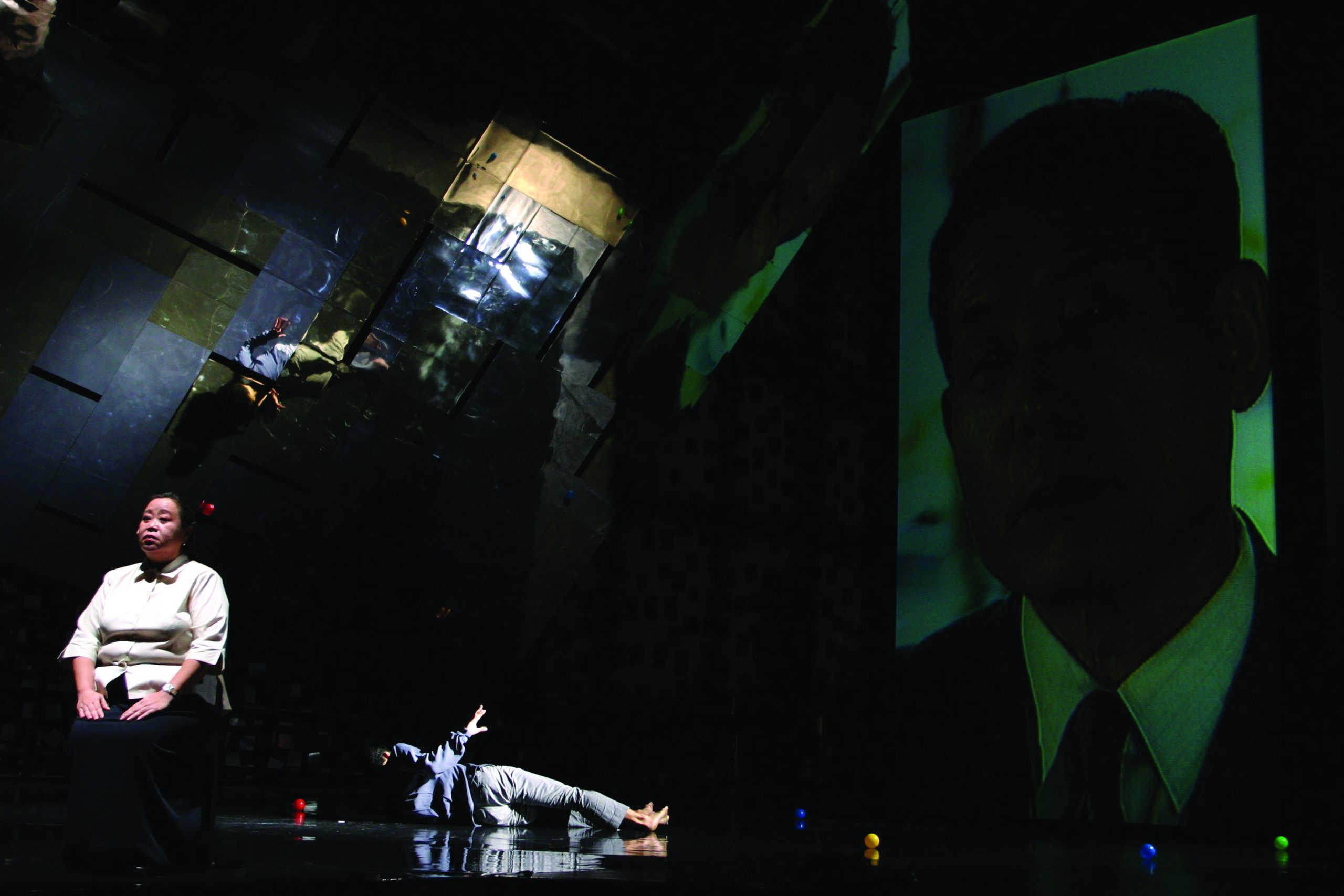
Images of Sandakan Threnody (2004), conceived and directed by ONG Keng Sen.
Photos courtesy of TheatreWorks (S) Ltd.
So, on every level I was thinking about in this piece: a set of relationships. What Ong Keng Sen then did was he took those relationships, those poems and that musical set of ideas and he transformed them into something that was very, very vivid; very much focusing on the particular, almost shamanistic belief systems, the animistic belief systems that one would find in places like Borneo and Malaysia. The very still and intense art forms, transformations and stories that intertwined between the Australian troops and their Japanese captors and that landscape.
Aubrey Mellor
Memory and landscape echo in all your work, and I notice you continually put horror and beauty together - very specifically in Sandakan Threnody - but what about influences – imports from elsewhere? You’ve been said to be influenced by Michael Tippett and by Benjamin Britten, or that people can hear Britten in your music; I can’t particularly, though I was thinking about Sculthorpe’s Port Essington music, with your Sandakan material. Conscious or unconscious, when you come to express yourself artistically, what of the actual music itself, is there a source?
Jonathan Mills
There are probably many. What I would say is that I start, again, from a very physical space. Music does not have subjunctive mood. It’s not a conditional tense. It exists in a very different dimension and for me, what that means is starting from very physical processes. Rhythms, I’ll give you an example. The second movement of Sandakan Threnody is structured very clearly in three parts. For me, it was the idea of the three marches that happened, and trying to make connection between them. Between a march that was very much about the physical location, the jungle, and the march that was very much martial, a march itself, very militaristic, and a march that was almost broken, that was no longer a march, it was march of ghosts, or it was a march of exhaustion, therefore it was more a chorale. But still, with the kind of forward pushing motion.
So in experimenting with ideas of how these rhythms will be generated, I spelt the word, the phrase, De profundis clamavi ad te, Domine, just that, that first sentence in the psalm one hundred and thirty. And I spelt it as a morse code rhythm. And I’ll just go to the score, because it’s been awhile since I did it. (Illustrating an example of the rhythm). Okay, and it goes on. That was the place I started from, something quite literal, something quite physical. Thinking about free-associates; I sketch a huge amount, then I start to think about my ideas, and then fragments start to coalesce and I have no idea what will be. I mean, there are others to tell me what the influences are, Britten, Tippett—not so much in Sandakan. Certainly the last movement is very Brittenesque, but that’s for me that kind of throwback and could be almost Michael Berkeley’s father, Lennox Berkeley, the composer—I mean, English Pastorale in one sense. And Tippett perhaps, but actually the first movement is nothing like those composers. If anything, the opening motif is inspired by the idea of Gagaku, the Japanese court music of the fourteenth-century. Where you have kind of the shocking sound that hovers in the air with some other things sort of pulsing beneath it.
Aubrey Mellor
Yes, the sho in particular, the reed mouth organ, wails like the proverbial banshee.
Jonathan Mills
Yes. It is a stylised version that is not Gagaku, and it is certainly not in the way that Peter Sculthorpe’s music or Richard Mills’ music deliberately references Gagaku. It is more of the kind of spatialisation of chords and texture that are held, rather than any specific detail.
Aubrey Mellor
It is interesting to hear you talk of Asian influences. Because I feel a Noh-like distillation in your work. You distil a wide range into statements of essence, but then you flare with theatrically that you can’t resist. I am very interested that the artist is very pure in you; like Oto Shoga, very Noh-like. But I love that you have what I would call a Kabuki-streak of theatricality. Could you finish with a statement about theatre?
Well, it is something I have experienced a lot of, something I have a feel for, and something I am interested in as a musician because I believe it is a way beyond the rather repetitious and almost arid, experience of music for its own sake. Don’t get me wrong: I adore people like Beethoven. But, the legacy of Beethoven was to be of such an extraordinary artist that he was able to take his own art—in ways that Mozart and Bach, and most people didn’t, even Stravinsky didn’t—into a realm of the absolute. Few artists do that. I feel that if you’re not that kind of artist, or if you’re not the kind of artist that Beethoven was at the time he was that kind of artist—so he’s not only a product of his unique mind, he’s a product of his unique times—then, actually you need to ask some serious questions about the nature of instrumental writing and how it relates to the world in which we find ourselves. Whether it is for the greater glory of God, like Messiaen or Bach provided their inspiration for, or whether it is in the service of something theatrical, like I am proposing, whether it is the entertainment of a masque, or it’s an accompaniment to a kind of mythos or a story. I think that music has lost something when it is continually insisting that it’s a pure art form and its only relationships are itself. I think that it gets very wearing, and tiring and it decontextualizes itself eventually.
I am looking forward very much to being able to stop being a festival director and start being an artist, if not full-time but most of the time. And the first project that I would be focusing on from September this year will be a return to theatre, Eucalyptus, my new opera.
Aubrey Mellor
Your operas are often called Chamber Operas, or Music Theatre, forms I particularly admire as most suited to future theatre-making, especially in Australia and Singapore. Remember Benjamin Britten’s Noh-like works, Curlew River and The Burning Fiery Furnace?
Jonathan Mills
Burning Fiery Furnace and The Prodigal Son.
Aubrey Mellor
Wonderful small-scale operas, models for what we could possibly look at here in Singapore. Sandakan Threnody is remembered with deep respect here and we look forward to more Jonathan Mills’ operas in Singapore. You would be warmly welcomed back to this major port — and, as you have said, after its colonial fall, it stands even stronger.

Arthur Stace writing his message, Eternity, Sydney, 3 July 1963.
Photo by Trevor Dallen/ Fairfax Syndication.
Interviews
Documentary photography and video have played a significant role in the evolution of global contemporary art, opening a new dimension of artistic engagement with social and political change, and producing an aesthetic genre highly relevant to our age of media and communication. Differing from traditional journalistic photography and film, documentary works negotiate the moving boundaries between reality and imagination, reportage and critique.They also provide a new space in which contemporary art can reconnect with real life, serving as a site of resistance to the hegemony of established powers. At a time when “Occupy Wall Street!” is a rallying cry against the domination of neoliberal capitalism, the work of artists such as Allan Sekula and Bruno Serralongue has become especially relevant.
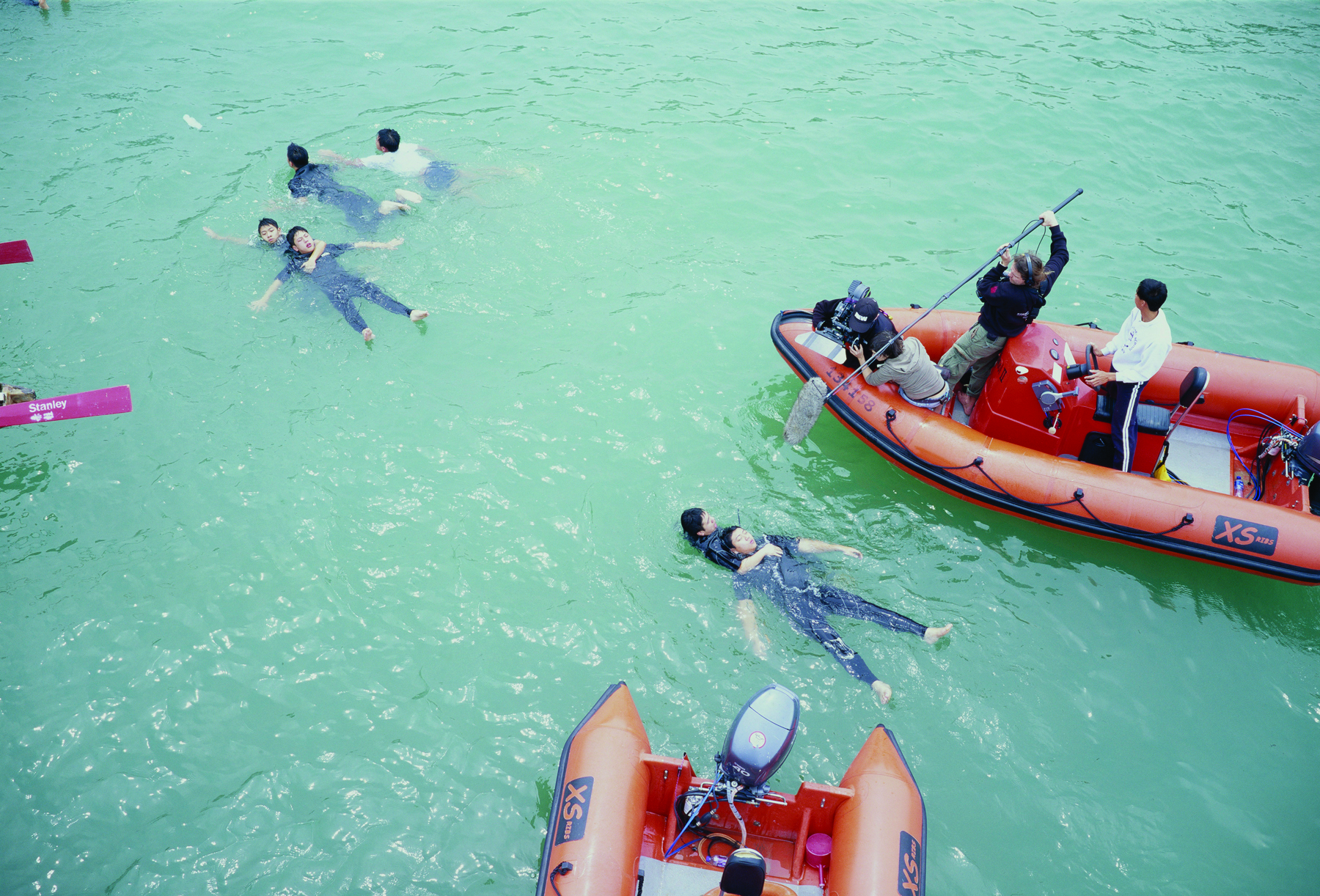
ALLAN SEKULA, Life Saving Drill, Hong Kong, 2009. Both production stills from
The Forgotten Space, 2010. Co-directed by Allan Sekula and Noël Burch. Dimen-
sions variable. Courtesy the Estate of the artist and DocEye Films, Amsterdam.
Hou Hanru
We are in a key moment again of rethinking the relationship between what we do and history, as pointed out by Alain Badiou in his latest book, Le Réveil de l’Histoire (2011). We are trying to answer the challenging question of the historical significance of the current revolutions around the world, from Arab countries to Europe to Wall Street. Bruno’s work has to do with the production of space, since he documents the process of making new nations like Kosovo and South Sudan.

ALLAN SEKULA, Hamburg Landfall, 2009. Courtesy the Estate of Allan Sekula.
Hou Hanru
However, they are not really nation-states. They are nations without economy, without cultural identity, or with only a certain kind of cultural identity. This is more about drawing a territory rather than building a social structure. Allan has a similar understanding in terms of what territory means and what is happening in the forgotten territory that he shows in his film The Forgotten Space (2010). As artists, how do you document this process? The work is not simply about describing it in a super-realistic manner. In fact, it deals with the perspective of history. How do you understand your roles in such a complicated relation to current events and the historical perspective?
Bruno Serralongue
We could look at the examples of South Sudan and Kosovo, two nations built from the outside; they are United Nations nations, products of the United States and the European Union. They tried to make a country following those same rules for organizing its border and turning the population into new citizens. In addition, the emigrants are expected to come home. It’s the same for Kosovo, because Kosovo is a country without economies. All of the economies are outside its border. With the European Union, it feels that if we stabilize the country with the military and we try to implement a kind of economic growth, people will come back soon, maybe in five or six years. But I think it will never work like this.
Hou Hanru
It is also an interesting question of belonging and how history actually reorganizes the sense of belonging. For example, we can compare it with the case of Palestine and the right of return; it has been one of the key reasons for the conflict in the region. In terms of the ocean, people are sailing on boats that use the flag of convenience, as you have pointed out in your work, Allan. The ships all belong to multinational companies and the crews are coming from different countries.
Allan Sekula
Global maritime regimes are full of contradictions. The doctrine of freedom of the seas dates back to the early 17th century. The Portuguese and the Dutch were in conflict over the seas around what is now Indonesia and New Guinea. The Portuguese were trying to claim proprietary rights to sea routes approaching trading ports and the Dutch were arguing that the sea is an open highway for all parties. They were the original free-traders. That established one of the key principles of maritime law: the open sea is beyond sovereignty. This allows sovereignty to creep back into the picture in myriad ways, many of them duplicitous, most semi-fictional or notional. For example, Greek shipowners register their vessels in Panama or Liberia and thus avoid Greek taxes altogether, which has no small impact on the health of the Greek economy. Today the United States is the dominant naval power in the world, by a long stretch. It claims to be the guarantor of freedom of the seas. This has no legal basis whatsoever, and in fact the principle is selectively applied: the US Navy has no interest in taking the leading role in the campaign against Somali pirates. But when it is geo-strategically useful to try to build a coalition of smaller south Asian states over threatened Chinese encroachment in the South China Sea, the doctrine is given full voice. The ironies of this situation are multiple; not least is the fact that Chinese recycling of its dollar surplus into US Treasury notes keeps the deficit-funded US Navy afloat. No Hollywood director wants to make a film in which an American carrier battle group attacks Chinese cargo ships carrying toys and toasters to the Wal-Marts of American suburbia, but that is one absurdity of the scenario being imagined.
Hou Hanru
As an artist, how did you decide to be involved with this situation? You started working very early with the question of global economy.
Allan Serralongue
I started doing more and more work about global economic questions in the early ’80s. My work was always about economic questions; without simplifying too much, I would say all my work since the early ’70s—certainly since Aerospace Folktales (1973) — has been about the demise of the postwar economic boom. My earliest works date from roughly the year 1971 — when Nixon withdrew the dollar from gold convertibility, ending the Bretton Woods Agreement that had governed the postwar international currency system, and opening the door to greater international financial speculation and to an increasingly fictional and volatile role for the dollar as the standard of international exchange. The cold war antagonism between the Soviet bloc and the United States and its allies fueled a military-Keynesian prosperity that benefited California enormously, making the University of California, for example, one of the world’s exemplary public universities. I was a product of that system, but by the time I finished as a student the sense of prosperity was already crumbling.
Hou Hanru
As Bruno has said, there’s a difference between a journalist and an artist when facing the same events, the same news in the newspaper. My question is at which moment can one actually say one is an artist? And is this distinction really important?
Bruno Serralongue
I often don’t tell people I’m an artist. I’ll say I’m a photographer, a filmmaker, or a writer. In the Anglo-Saxon world, people often regard artists as charlatans. Maybe this is less true in France, as there is still a strong artisanal culture in France and a respect for artists. But that’s a side point. The main point is that I don’t want to judge journalism by the standard product of the apparatus, which is degraded with the decline of print journalism but which is also opening up with the rise of Internet-based communications. With journalists the sense of form is secondary. But with artists, those questions are primary, and so we can alter the standard relations of image and text.

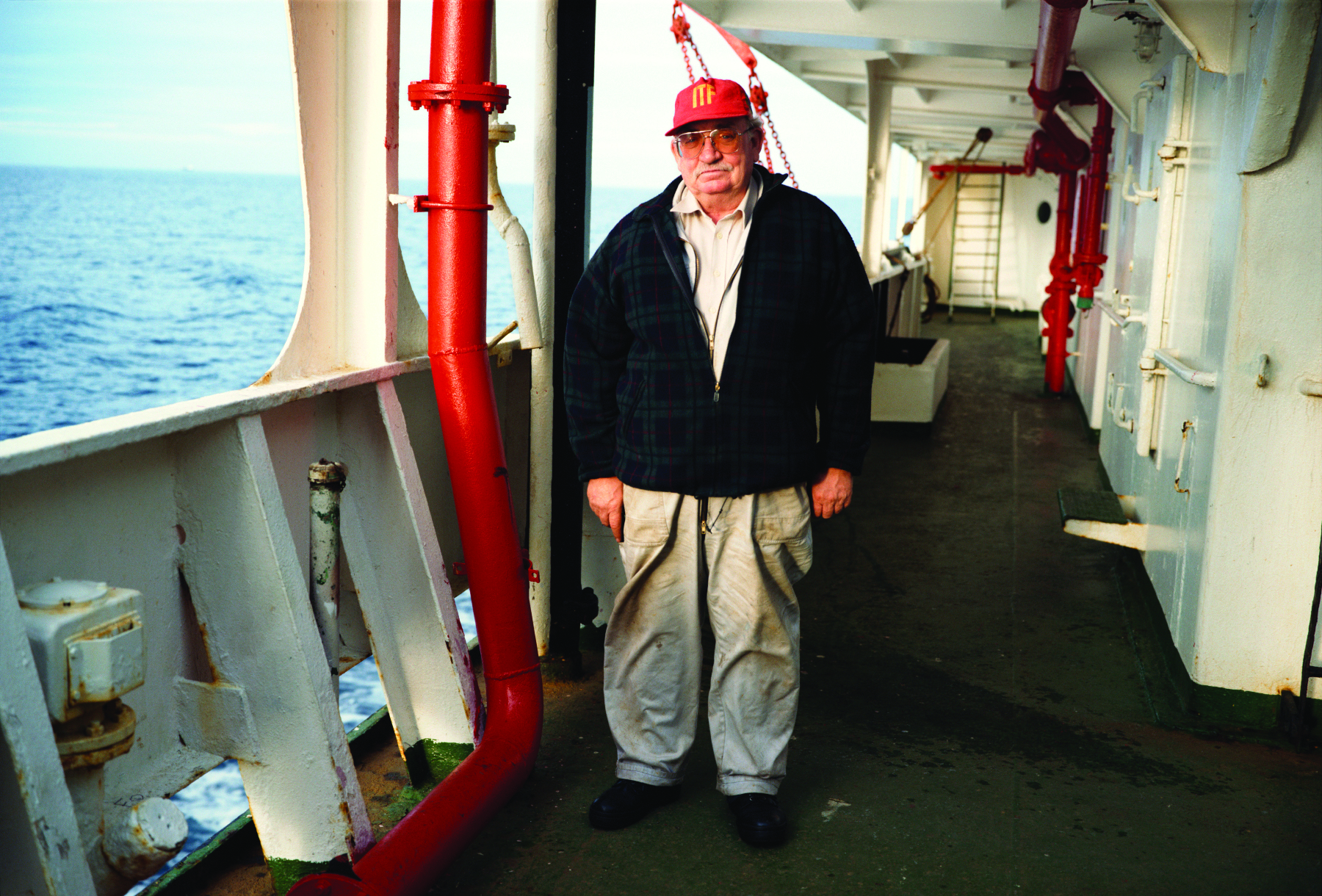
Images: ALLAN SEKULA, Crew, pilot, and Russian girlfriend (Novorossisk) 1-10
from Ship of Fools, 1999-2010.Chromogenic print, 102 x 150 cm (each). Courtesy
the Estate of the artist and Christopher Grimes Gallery, Santa Monica.
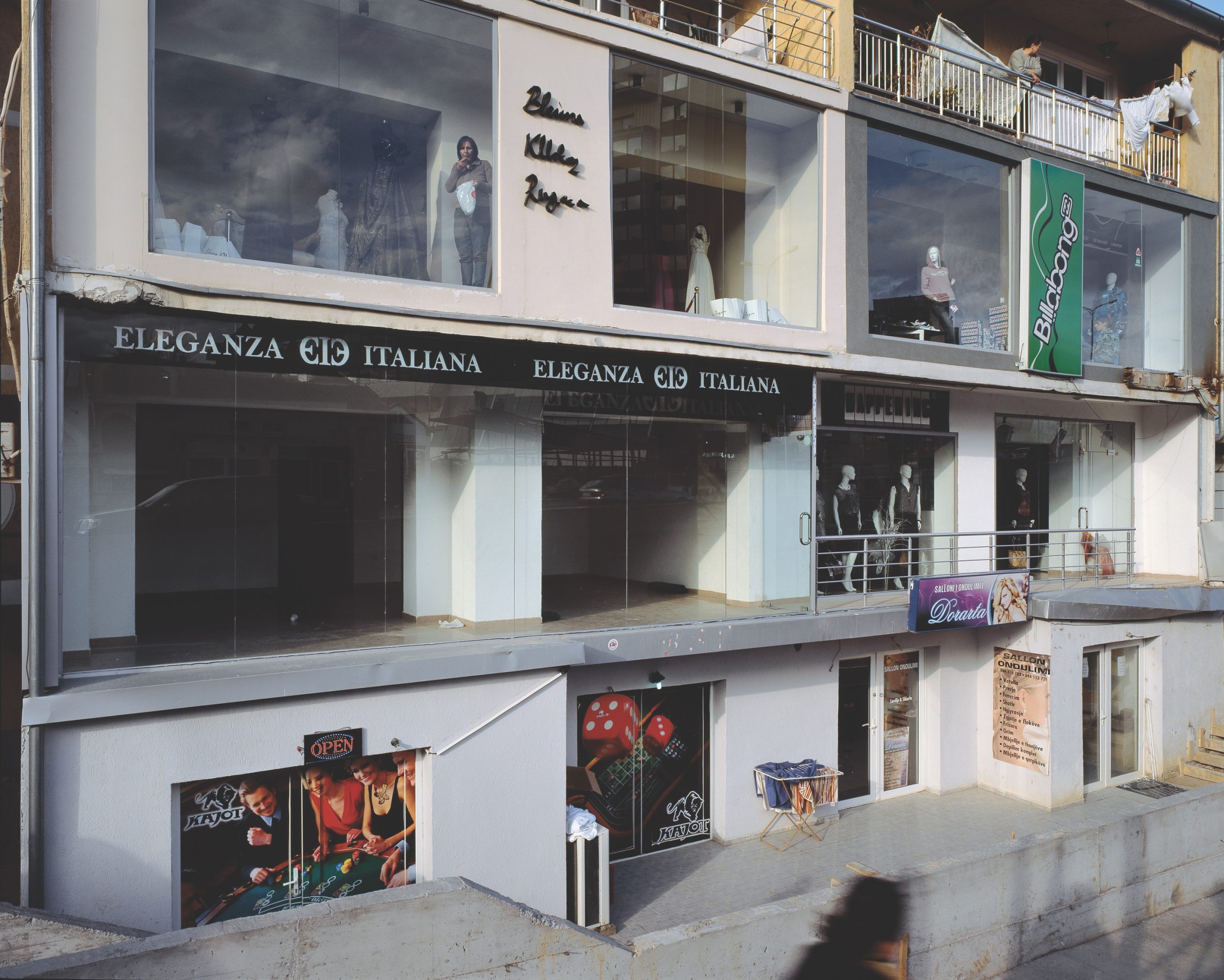
Bruno Serralongue, Devantures, centre ville de Pristina, Kosovo, November 8, 2010, 2010. Ilfochrome on
aluminum, 125 x 156 cm. Courtesy Albert Baronian, Brussels.
Bruno Serralongue
Yes, to be anti-photojournalism is not to be against journalism; it is trying to find a new way of speaking of the same subject but following a different method. Maybe because you follow a different method, you can give different information on the subject.
Hou Hanru
Yes, that might change the essential aspect of your position.
Allan Sekula
I remember during the 2000 Democratic Convention, in Los Angeles, there was a lot of heavy stuff with the police on the streets. It was one year after Seattle, so they were really trying to control the situation. There was a very funny demonstration one night on Santa Monica Pier where a bunch of rightwing Democrats held a fundraising party. They had maybe five different police departments there to keep the protesters away. I was photographing it with fast, pushed film and trying to work with the crazy mixed light of the nighttime pier. It was great because you had these police horses on the pier and there was horseshit everywhere and all these women coming to the party with high heels were walking through the horseshit. That was the most fascinating thing about it. But there were maybe five or six kids who looked like Black Bloc anarchists with masks on. Of course, all these journalists were just on top of them, waiting for some gesture of violence. I was busy photographing the high heels and the horseshit and trying to get the light right. In the middle of this, I bumped into Gilles Peress from Magnum, who was also uninterested in the Black Bloc kids, and he said, “Oh, you don’t have a flash. I can’t afford not to have a flash.” At that point, I think he was doing a series for Vanity Fair, and he knew he would get one page, and it was better to get the one good image than to miss it.
Bruno Serralongue
We know that press photographers have maybe one page in a magazine. It’s one photo, maximum two. So they are always chasing the most spectacular image. And for us, we work more in a sequence or série. It is totally different.
So it’s the narrative that involves more contextual information and also that creates a space or distance of suspicion or suspense, or even critique, in that sense.
Allan Sekula
But someone like Gilles, who is working at an intelligent level, is also able, with certain bodies of his work, in his books for example, to develop that same kind of context that we are talking about. The history of modernism is the history of a certain snobbish way of looking down at realism, and realism is what marks you as a “mere” journalist. But we know all too well that there is poetic play within realist language. With documentary photography we should be open to a variety of different visual styles that can be emulated or appropriated within a broader or bigger context to make complex works.
Hou Hanru
And do you think that exhibitions somehow serve as a kind of articulation, an intensified moment to display all these different kinds of forms? Yesterday, Bruno was talking about exhibition as a place where a difference from journalism emerges.
Bruno Serralongue
It is not only a place to display a photo in the room. It is about how you perceive it, how the spectator looks at an image. Looking at an image on the wall is totally different from how you look at it in the press, a newspaper, or a magazine. I definitely think the exhibition space is very important to understand the work in a specific way.
Hou Hanru
In the process of photographing and filming, do you have much interaction with the subject, the workers on the boat in Allan’s case and the people surrounding the events in Bruno’s case?
Allan Sekula
Without those people you don’t have an image. Without some interaction with them and some way of communicating, you don’t have the image. The image is always the outcome of relations between subjects: even a depopulated landscape is intersubjective. It strikes me in my portraits of the crew of the ship that the friendliness and the way they project themselves to me has something to do with the fact that I got to know them all over the weeks of being on the ship. I would not have gotten the same openness and edge of humor. What does it mean that I am calling this The Ship of Fools? Are these people fools? There is a longstanding joke among seafarers that you have to be a fool to go to sea. And there is a specific literary lineage here: Sebastian Brant’s book, Das Narrenschiff [The Ship of Fools (1494)], influenced Erasmus when he wrote his famous text dedicated to Thomas More, In Praise of Folly. (1509). And the role of folly in human creativity and critical resistance to dogma and doctrinal frozenness is very important. The projects that seem most quixotic are often pregnant with the future. They are in on the joke, and that spirit is something I wanted to get.
Bruno Serralongue
For me as well. This relation is crucial. It’s probably the biggest difference between the way I work and how a photojournalist works. I arrive somewhere, like in Kosovo or in South Sudan, and I don’t know exactly what I can photograph because I don’t have a special permit. When a photojournalist arrives somewhere, he knows what he wants to photograph more or less. I am more open. So the relations with people I meet are extremely important. It gives me different possibilities to explore the subject.
This conversation was first published on Flash Art International 288, January-February 2013. © Flash Art International 2013
The article and images are reproduced here with the kind permission of the Estate of Allan Sekula, Hou Hanru, and Bruno Serralongue.
Interviews
In this interview, artist and writer Ho Rui An speaks to June Yap, curator of No Country: Contemporary Art for South and Southeast Asia, a travelling exhibition which premiered in 2013 at the Solomon R. Guggenheim Museum, New York, as part of the Guggenheim UBS MAP Global Art Initiative and ran at the Centre for Contemporary Art, Singapore, from 10 May to 20 July 2014.
Ho Rui An
The title of the exhibition, No Country, invokes notions of transnationalism. Given that this is a regional show, specifically a show about South and Southeast Asia, to what extent does the exhibition propose looking at the region as a way of escaping the parochialism and essentialism that the national framework has too often been accused of?
June Yap
The regional scope of South and Southeast Asia was prescribed before I came into the project. It wasn’t something I had come up with. Here, we tend to think of South and Southeast Asia as two regional entities instead of one. But culturally speaking, these two have been related throughout history, if you think about how Hinduism traversed the entire region as an example. That the two entities were construed as one region allowed me to think about culture beyond the geopolitics of the nation-state. Living in this region, we have to acknowledge the influence of the entities around us.
But at the same time, regionalism itself is problematic because it sets up these binaries of say, East and West, especially if you were to read this as a project by the Guggenheim, based in New York, looking towards South and Southeast Asia as if there was no prior connection. The fact is that on a day-to-day basis, the ways in which we live our lives is extremely globalised. Even transnationalism as a concept doesn’t quite reflect this because it still assumes the nation to be that natural entity, which we know is not entirely the case, it being a condition that was established in the region only within the past century.
Ho Rui An
Interestingly, not long before you did the Guggenheim show, you were curating Singapore’s National Pavilion at Venice, which despite its contemporary inflections, still very much takes the nation as the basic unit by which we understand ourselves and the rest of the world. Looking back at that experience, what relevance do you think the nation as a geopolitical entity still holds for contemporary curating?
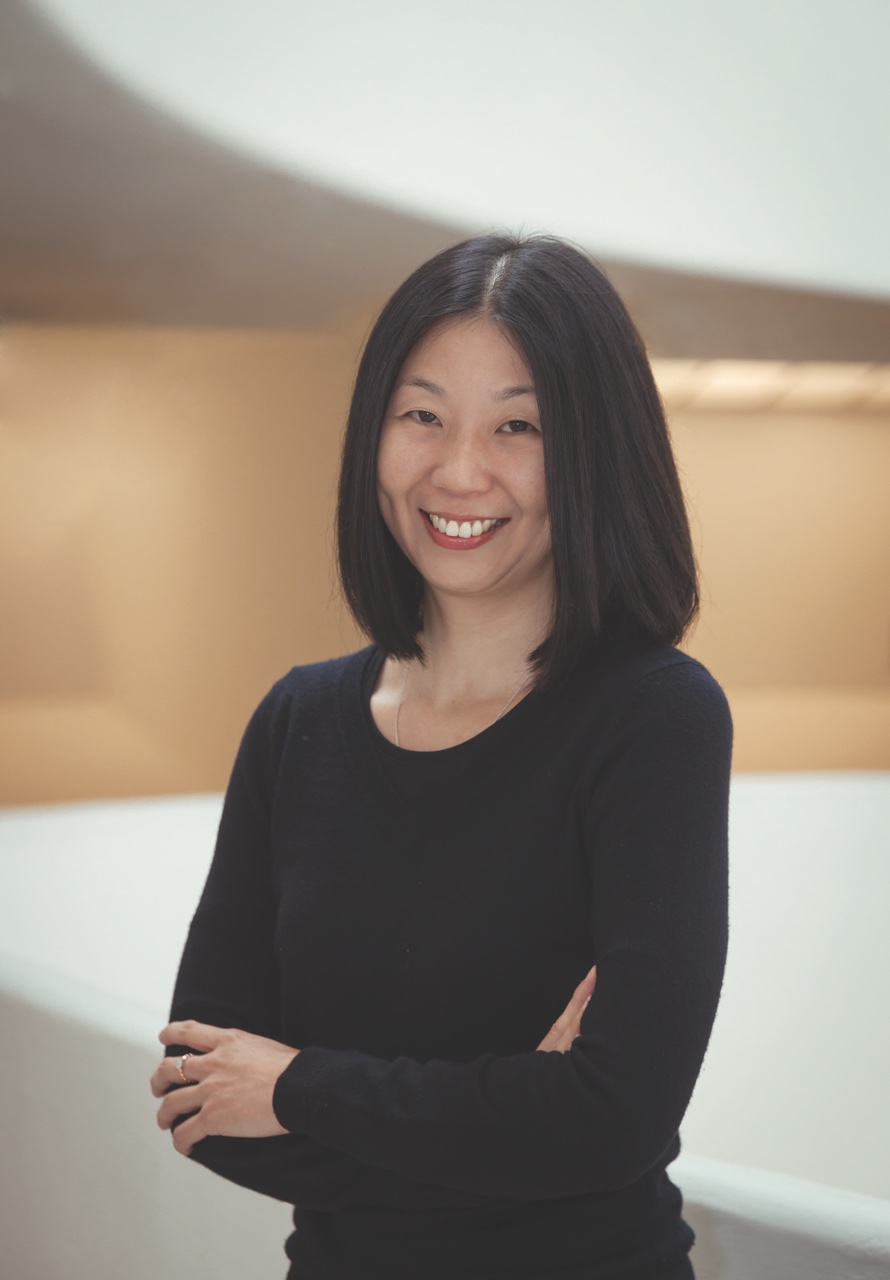
June Yap. Photograph by David Heald © Solomon R Guggenheim Foundation, New York.
June Yap
Venice is a very nationalised platform, a global meeting of art that is constituted with very specific positionalities involved. That said, in the past few editions there have been pavilions that have refused to assume the integrity of this geopolitical definition. So we have always been aware that these are extremely problematic divisions. But in the cultural sphere, the nation still remains an effective shorthand. This is why as cultural practitioners, as much as we don’t need to obsess over it, the nation is still something we need to consider as an assumption we might explore. There are artists who are engaging head-on with this problem, refusing to be contained by these definitions. Ho Tzu Nyen’s participation in the last Pavilion, The Cloud of Unknowing (2011) was a deliberate blurring of what it meant to be a Singaporean Pavilion, especially since the references he used spanned a broader history and aesthetic.
Ho Rui An
Works like Cloud, as well as many of the works within the exhibition, are often spoken in terms of their “global” appeal. But what exactly does it mean for a work to be “global”? Is there an assumption of an international aesthetic language?
June Yap
Yes and no. There are ways to read a work within a certain vocabulary that is seen as global, such as when we read a work as a painting, a performance or a video, but these categories are themselves ambiguous. What becomes interesting for any exhibition is when you try to expand or work the limits of these categories. These categories then become frames of reference that are superimposed to get some traction, in order to figure out how close, or how far, an idea of what an artwork is doing, is in fact really what it is trying to do.
Ho Rui An
The show has travelled to two other locations since its first showing at the Guggenheim. How has the reception varied with each change in location?
June Yap
The project from its onset was intended to travel, and in this case when it moved from New York to Asia via Hong Kong, it allowed for us to consider the artworks in relation to an expanded notion of Asia, to look at how we rationalise this broader region culturally. The reception in Hong Kong was interesting. There is increasingly greater understanding of what’s happening south of Hong Kong in Southeast Asia, actually even South Asia. But because Hong Kong has been largely caught up in what we consider to be the East Asian scene, the artworks and artists still weren’t terribly familiar. There is not a lot of reason to think about South and Southeast Asia when your immediate concern is China.
But when it moved to Singapore, it returned to where the works came from. Thus here, it was more the issues within the works than notions of East and West that came into play. It was the specific content that had a more immediate resonance.
Ho Rui An
Historically speaking, the idea of Southeast Asia being an entity in itself was in part a construction of Cold War-era politics, especially through America’s involvement in Vietnam and the whole field of Southeast Asian Studies that was constituted in the wake of that. Within the show, there were also many references to the incidents of Vietnam. Given this, was there a level of reflexivity for an American audience viewing the show?
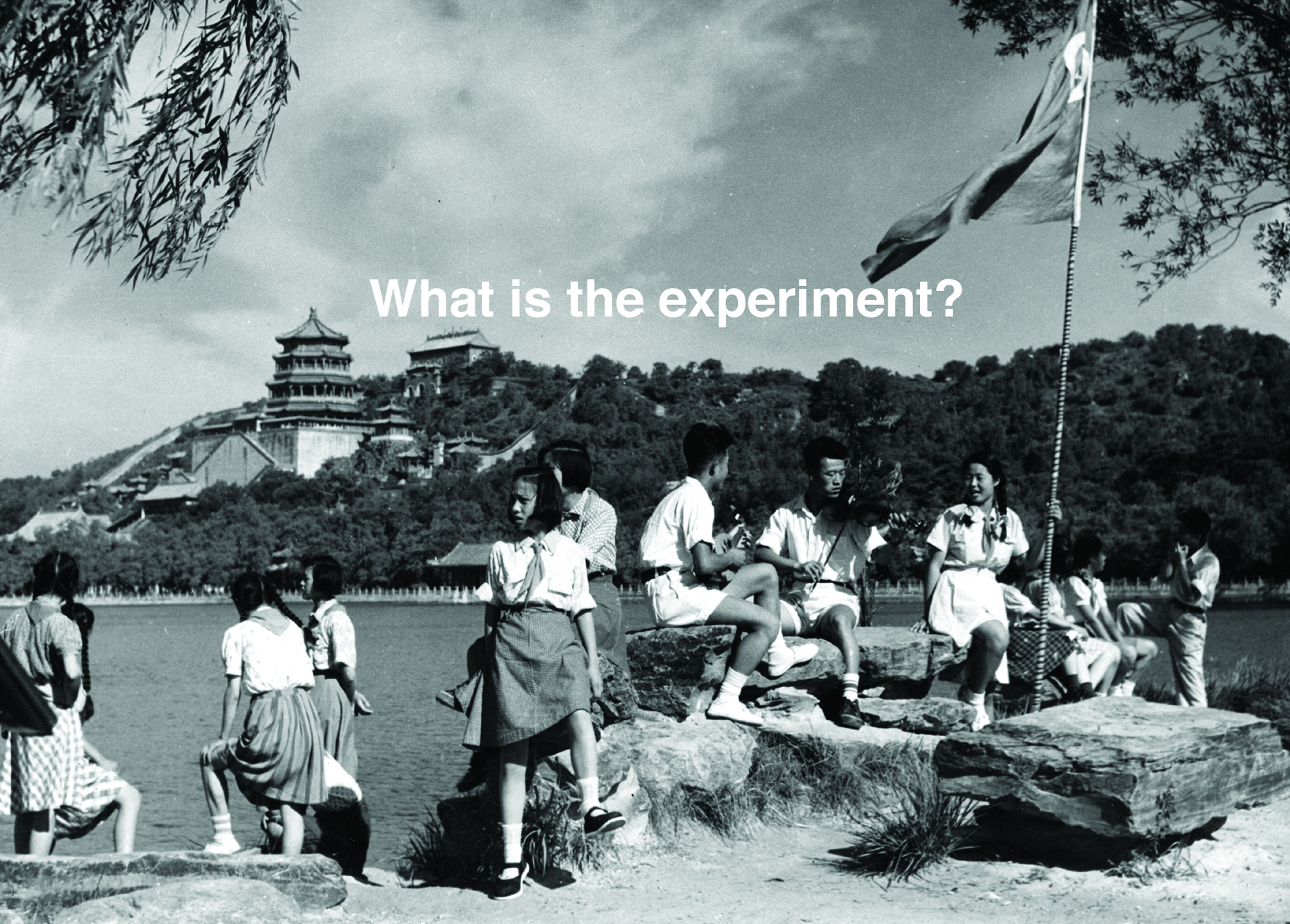
The Otolith Group (b. 2002)
Communists Like Us, 2006-10
Black-and-white video, with sound, 23 min., 5 sec. edition 2/5
Solomon R. Guggenheim Museum, New York Guggenheim UBS MAP Purchase Fund, 2012
2012.163
June Yap
I cannot really generalise a response, but at least while we were putting the show together, working with the team, there was an awareness of what happened in the past, of these intertwined histories. Yes, there was the Vietnam War. Yes, there was the Philippine-American war. What the artworks did was bring home what exactly that meant. It nuanced their understanding. In Hong Kong, where we presented Vandy Rattana’s Bomb Ponds (2009), there was a video that showed the Cambodians relating their experiences during the bombings that were in fact meant to flush out the Viet Cong. Stories like these do not often get told, and provide for much needed micro-narratives within complex histories.
Ho Rui An
How much of a consciousness of the region did you think the individual artists and works had?
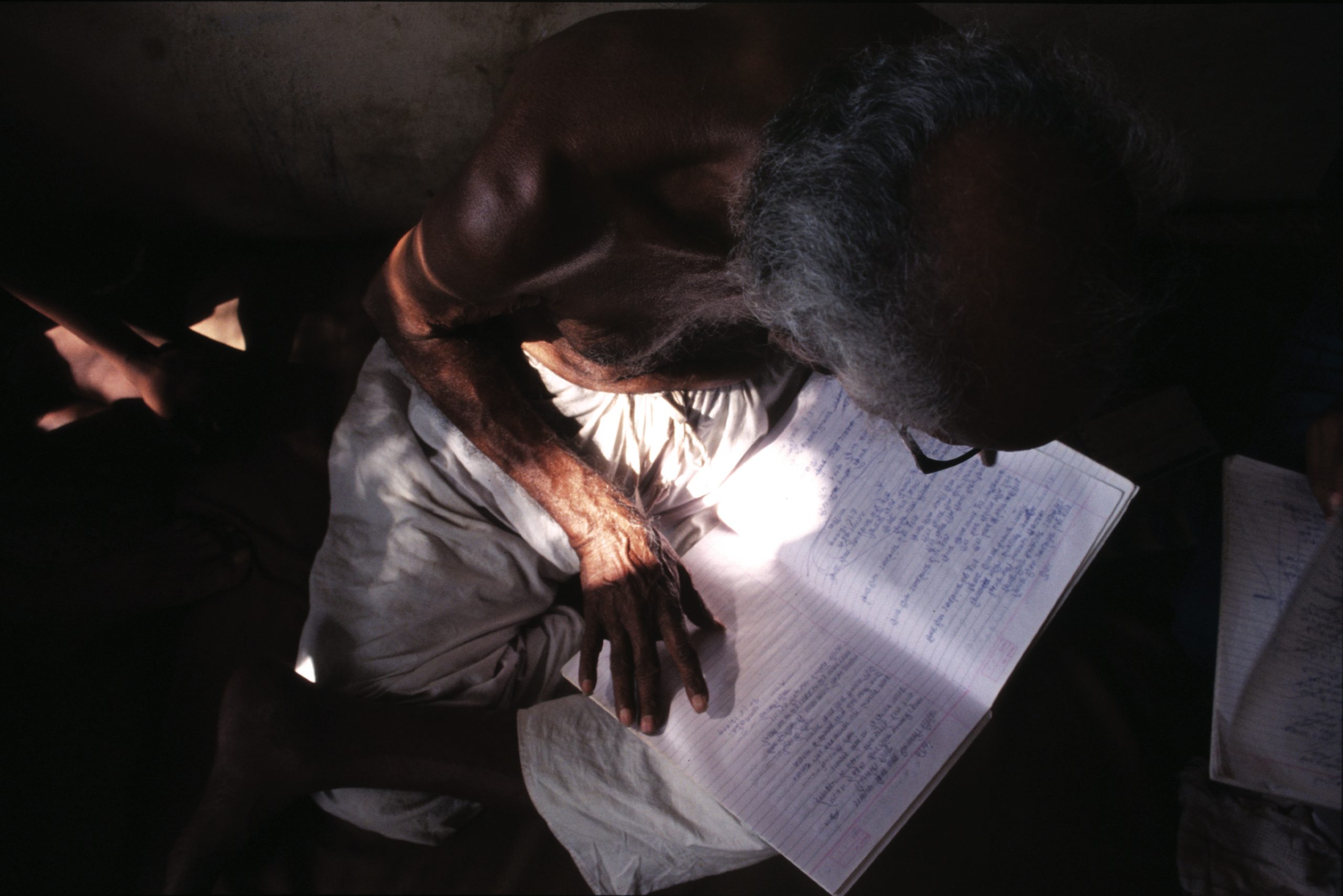
Amar Kanwar (b. 1964)
The Trilogy: A Season Outside (1997), To Remember (2003), A Night of Prophecy (2002), 1997-2003
Three colour videos, two with sound, one silent; 30 min., 8 min., and 77 min., respectively edition of 6
Solomon R. Guggenheim Museum, New York Guggenheim UBS MAP Purchase Fund, 2012
2012.150.1-3
June Yap
It varied. Let’s take for instance the artwork Communists Like Us (2006–2010), by the London-based collective, The Otolith Group. Both Anjalika Sagar and Kodwo Eshun are conscious of what occurred within the region, but also of how they are not and in fact do not need to locate themselves within it. They are an example of how one can quite deftly examine and play with ideas concerning the region objectively, without losing a sense of intimacy. The images in the film come from Anjalika’s family, so there’s a very immediate, visceral connection. But there are also detached observations of its historical context, such as in the two musical pieces and the dialogue from the Godard film, La Chinoise. In this, you have the interesting tension of being close yet always standing apart. Showing the work in the context of an exhibition like this expanded the discussion beyond South and Southeast Asia. From our relationship to the Cold War, one can understand why it is here in the exhibition, yet in its slightly distanced approach you do not necessarily quite recognise it as coming from the region as well. It allows us to be more conscious of the signposts we rely on to identify representations of the region.
Ho Rui An
The exhibition is about the region of South and Southeast Asia, but there are also the regions within each country are dealt with in particular works. In Amar Kanwar’s A Night of Prophecy (2002), it is the regions within that are doing the work of testing the stability of the nation-space that is India. How do you deal with the complexities of the regional at such a specific level?
June Yap
One jumps right in, which is what Amar Kanwar does. A Night of Prophecy does that, moving from Maharashtra to Andhra Pradesh to Nagaland to Kashmir. There is no preamble, no apologies, and that’s what is significant about that work. I appreciate how it doesn’t begin with the binary of centre and periphery, and then tries to work the periphery until it takes over the centre. It just quite plainly shows you that this is what the reality is, and one has to recognise and deal with it.
What are your aspirations for this final staging of the show in Singapore?
Ho Rui An
I don’t really set the outcomes. For me, it’s more about the process. You try something and then find out. With this project, I was attempting to complicate the ways we represent the region, because I have observed artists doing that as well, engaging directly with the problems of being pigeonholed.
June Yap
An exhibition is not the endpoint; rather, it’s a continuing process. Curatorially, you learn something from each project. It’s all part of a larger process of thinking about what you can do with art, how cultural discourse is being created and where you come in. After all what art does is not limited to the aesthetic sphere; its implications are more far-reaching than it often appears. With each project, you learn more about what art can do. The question is with this knowledge, how do you respond?
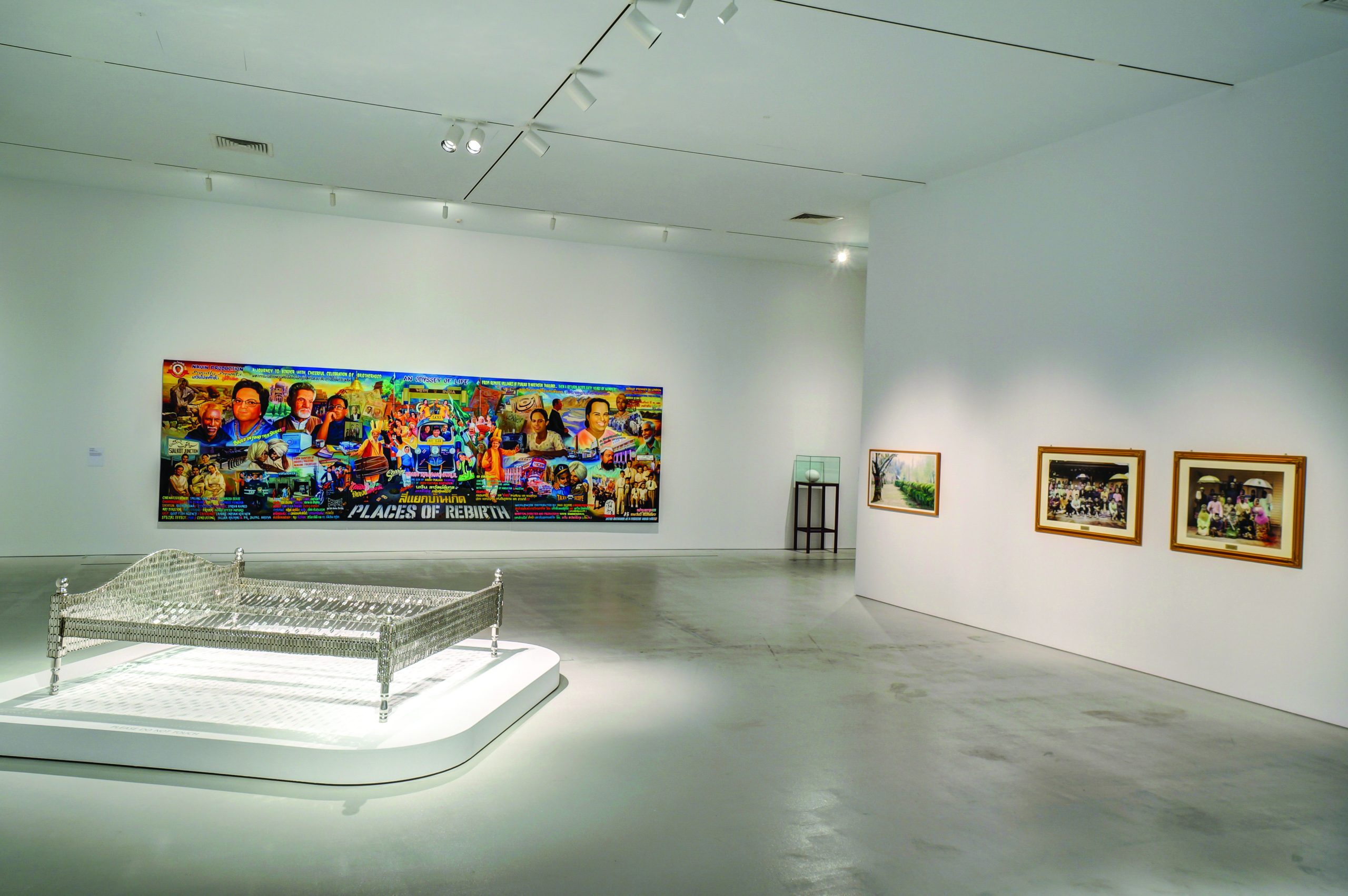
Installation shot of No Country: Contemporary Art for South and Southeast Asia,
theinaugural touring exhibition of the Guggenheim UBS MAP Global Art Initiative,
at the Centre for Contemporary Art, Singapore,
a national research centre of the Nanyang Technological University (NTU), May 10, 2014 – July 20, 2014.
Courtesy of Solomon R. Guggenheim Museum, New York, and the Centre for Contemporary Art, Singapore
Interviews
Bala Starr
In June I travelled from Singapore to Johor Bahru (JB), over the causeway into Malaysia, to visit Zai Kuning at his home and studio. There was a school next door, and it was a sports day, with frequent sirens and noisy cheering. Zai’s large open studio was under cover at the back of the house. Zai prefers JB to the island city of Singapore. He enjoys the peacefulness and space to work but hopes to move with his family to a wooden house nearer the sea. Once we started talking, Zai’s conversation quickly moved to the history of the Malay people and the Riau Archipelago.
At the time of this writing, Zai Kuning has an exhibition, We are home and everywhere, of new work at Ota Fine Arts, Singapore, from 27 June to 10 August 2014. He is developing elements of his ongoing Dapunta Hyang project for the Institute of Contemporary Arts Singapore from 20 September to 26 October 2014.
Zai Kuning
My suffering is that the Malay people don’t understand their history. The first man is Dapunta Hyang. Some people don’t like him because he is actually a figure like Alexander the Great, a conqueror. He wanted to conquer the world, and the Malay people mostly don’t know about him. Why? Politically they just talk about the history of Parameswara. But Parameswara is nothing to me.
From very young I read about him but I know this part of the history. OK, we say seventh century to thirteenth century is Dapunta Hyang. Fourteenth century is Parameswara. And they both [came] from Palembang, from Sumatra, to fight with the Johor Empire. Dapunta Hyang was the earliest king who said, ‘Malaysia, Sumatra, Java, Myanmar, all belong to me’. We call him Sikander after Alexander the Great. Beautiful, but nobody knows about this story. And he is not Muslim. That’s the problem. They denied him, the whole empire denied him, because he was a Hindu and a Buddhist. In Palembang or the island of Singapore in the seventh century there was only Hinduism and Buddhism. Islam came in the fourteenth century. And that is with Parameswara as well. But he is also not a Muslim—I think he pretended only for political reasons.
Bala Starr
How long have you been working with the history of Dapunta Hyang and what was your first interest?
Zai Kuning
I would say 1999. I have been searching for these people [the Orang Laut or sea gypsies of the Riau Archipelago]. Do you know how much trouble I had? They are the original people of the islands, the sea-faring islanders who travelled from island to island to island and claimed everything as their own. But now they cannot have the rights [to this land].
Bala Starr
You are talking about their travelling and their nomadic existence, and this has also been the basis for your own research and practice.
Zai Kuning
You know I was born in a village. A Bugis village near Pasir Panjang, in the south-western part of Singapore island. We saw many islands in front of us and we always used boats. We always used ships and boats as our vehicles. My father’s side. We didn’t think about motorbikes, we didn’t think about cars. Every day we thought, can we make a boat or not?
We would always go towards the sea. We go to Pulau Bukom, Pulau Brani, and many other islands, and the boat—many different kinds—is our pride. That is the idea of a vehicle, you can go very far, very far. The better the wood you use, you go very far. Seven hours, eight hours. I go fifteen hours, eighteen hours, twenty hours. We took water, we had everything.
Bala Starr
These were the destinations of your family. Did you also travel beyond the southern Singapore islands, to the islands in the Riau Archipelago? Do you call it exploring?
Zai Kuning
No, not exploring. We are at home, because that is our home. Few hundred islands, everything is our house. We can go here, we can go there. Mixed marriage here from this island and mixed marriage there. They’re all mixed marriages. They keep moving here and there. They are not exploring, they are living their lives. This is completely misunderstood. They are completely discriminated [against]. Moving from one island to another and mixed marriages between—it’s natural. It’s very natural.
This archipelago is island-based. You know how many islands there are? Three thousand. They are not deserted. These people have been moving around in these islands for more than 2000 years. And their psychology is not the same as nomadic people who are in the desert in the Middle East or in Australia for instance. They deal with water. They deal with the sea. But this sea doesn’t have waves. It’s flat. Waves would mean South China Sea, open sea. But these Malay people were living with flat water. Their boats are different, they don’t need big ships. So that is the world that I’m living with.
Bala Starr
You talked about the different psychology of these island people. What sort of differences are you meaning?
Zai Kuning
Islanders are very peaceful. The only problem I discover is religion. Fishermen don’t need religion because fishing already is very religious. You bring food to people but this religious idea at times is too much. It’s just too much. Fishermen should be left alone. They are the ones who provide food. Farmers too.
Where I grew up it was very peaceful. We are kampong [village] people. I am a kampong boy. We climb a tree, we take a mango, go to the river. My unhappiness for the Malay people is that we have lost all this already. Everything is destroyed. We make boats, we make houses ourselves, we make everything ourselves, we don’t hire people. Now it’s all gone, of course. Only contractors make. That’s why I left Singapore and came here.

Zai Kuning
RIAU (video stills)
2003
Video, colour
29’45”
Image courtesy of the artist and Ota Fine Arts.
Bala Starr
To Johor?
Zai Kuning
Actually we plan to move further. I want to go to Muar [a coastal town closer to Malacca, north of Johor Bahru]. I want to live in a wooden house. I think that is the best for me. It’s closer to the sea. Here we have no sea. Growing up every day I would swim [in] the sea, jump [in] the river. That’s my spirit. I am already old. I am already fifty. To think like desert always I cannot. Too dry. But I have to wait.
Bala Starr
Can we continue to talk about your sense of place, the kampong and the sea, and how your traditional cultural experience is more nomadic? How your cultural life connects with a strong sense of living and travelling by the sea?
Zai Kuning
OK. I must explain something to you. I am not a Malay man. I am a Bugis. We come from Makassar [on the island of Sulawesi, Indonesia]. The Bugis are warlords from Makassar. They were warriors. Thousands of them came to Johor because the Johor Empire had no army. This capital of colonialism came to the Straits of Malacca, to Johor and Singapore, and the Johor Empire had no army. Can you believe it? The Bugis came to Johor to defend Johor in colonial times and became the power behind the Johor Sultanate.
I am a Bugis, my father is a Bugis, my village is all Bugis. The Bugis people are strong. They always fight. They can kill very easily. Do you want me to show you something?
***
[We move outside to the studio adjacent to the kitchen. There are work benches, shelves, chairs and a low wooden platform on the concrete floor. Small table-top and larger freestanding sculptures of wood, found tools and functional objects, wax and thread are all around. From time to time the sounds from the nearby school sports activities overwhelm our conversation.]
We are Bugis. I’ll show you. [Throws a knife into the wooden platform that is part of Dapunta Mapping the Melayu, 2014.]
Always misunderstood, the Bugis. But the Bugis people are, we are warlords. Warriors. And very grumpy. [Throws knife.] The Malay people are different. The Bugis people also capture the Malay world. They are also assholes. They are not nice people. But they come to this area to serve the Johor Empire. Few thousand of them with big ships and they are good like that, very good. I was trained from young to throw a knife. But we cannot kill people. Not any more, since the time of Raja Ali Haji. He said, ‘Throw away your knife, take a pen and write’. OK, there came a point, he was telling all the warriors, because a few thousand warriors who can really throw knives, this is a different kind of problem too. And he said, ‘Stop it. Take a pen’.
Raja Ali Haji was born in Selangor (although some sources state that he was born in Penyengat, off Bintan Island, in 1808 or 1809), and was the son of Raja Ahmad, who was titled Engku Haji Tua after accomplishing the pilgrimage to Mecca. He was the grandson of Raja Ali Haji Fisabilillah (the brother of Raja Lumu, the first Sultan of Selangor). Fisabilillah was a scion of the royal house of Riau, who were descended from Bugis warriors who came to the region in the eighteenth century. His mother, Encik Hamidah binti Malik, was a cousin of her father and also of Bugis descent. Raji Ali Haji soon relocated to Penyengat as an infant, where he grew up and received his education.
He is the one who formalised Malay language with the idea of ‘unification’ as many islanders speak with different ‘lingo’. He also the one who began promoting press or printing of writing for all in Riau. As in this period most people don’t read nor write as it’s an oral history tradition. No writings but a lot of storytelling.
You know in Bintan, people are so scared of me. [Throws knife.] They all run away from me.
***
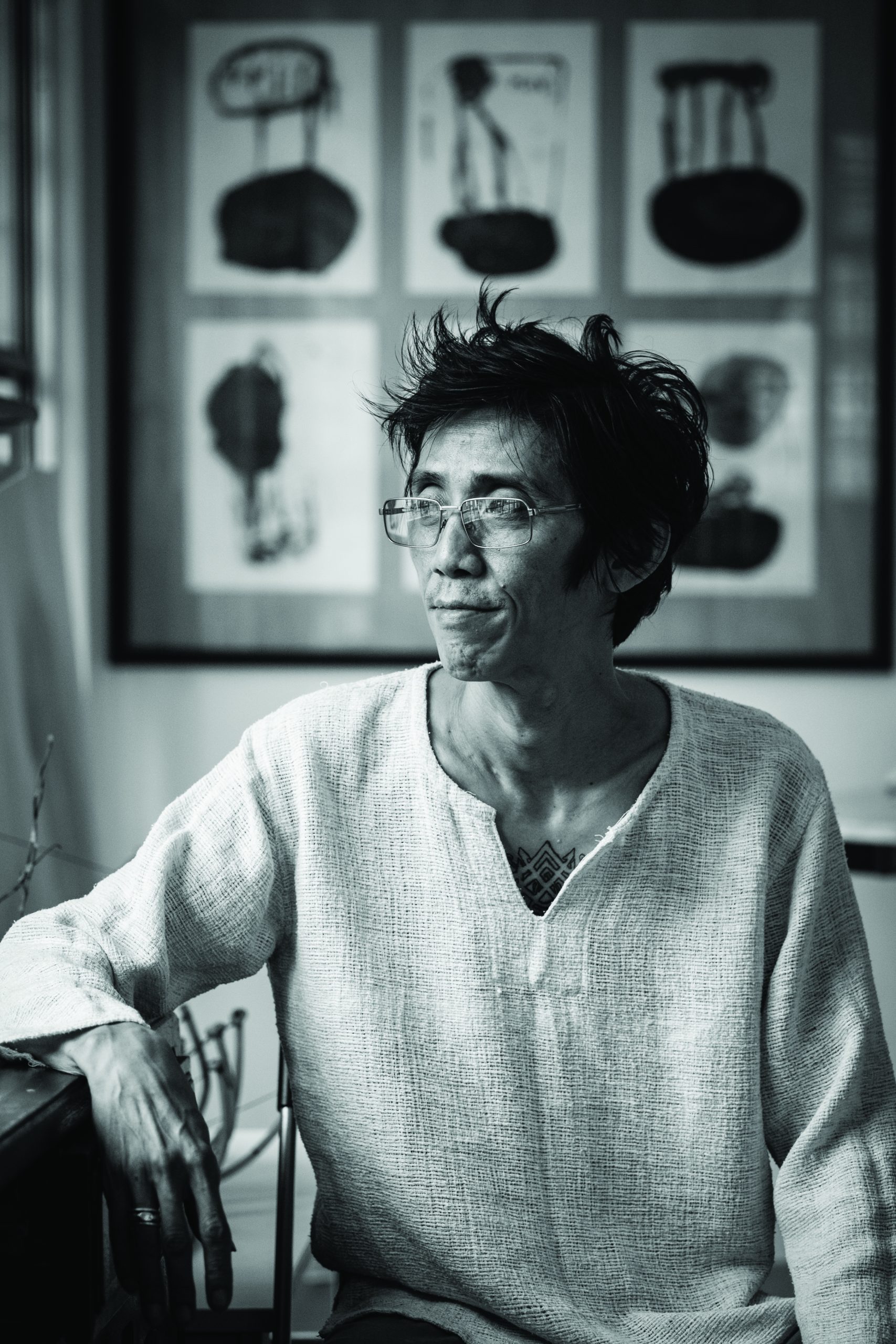
Image courtesy of the artist and Ota Fine Arts.
Photography by Tan Ngiap Heng.
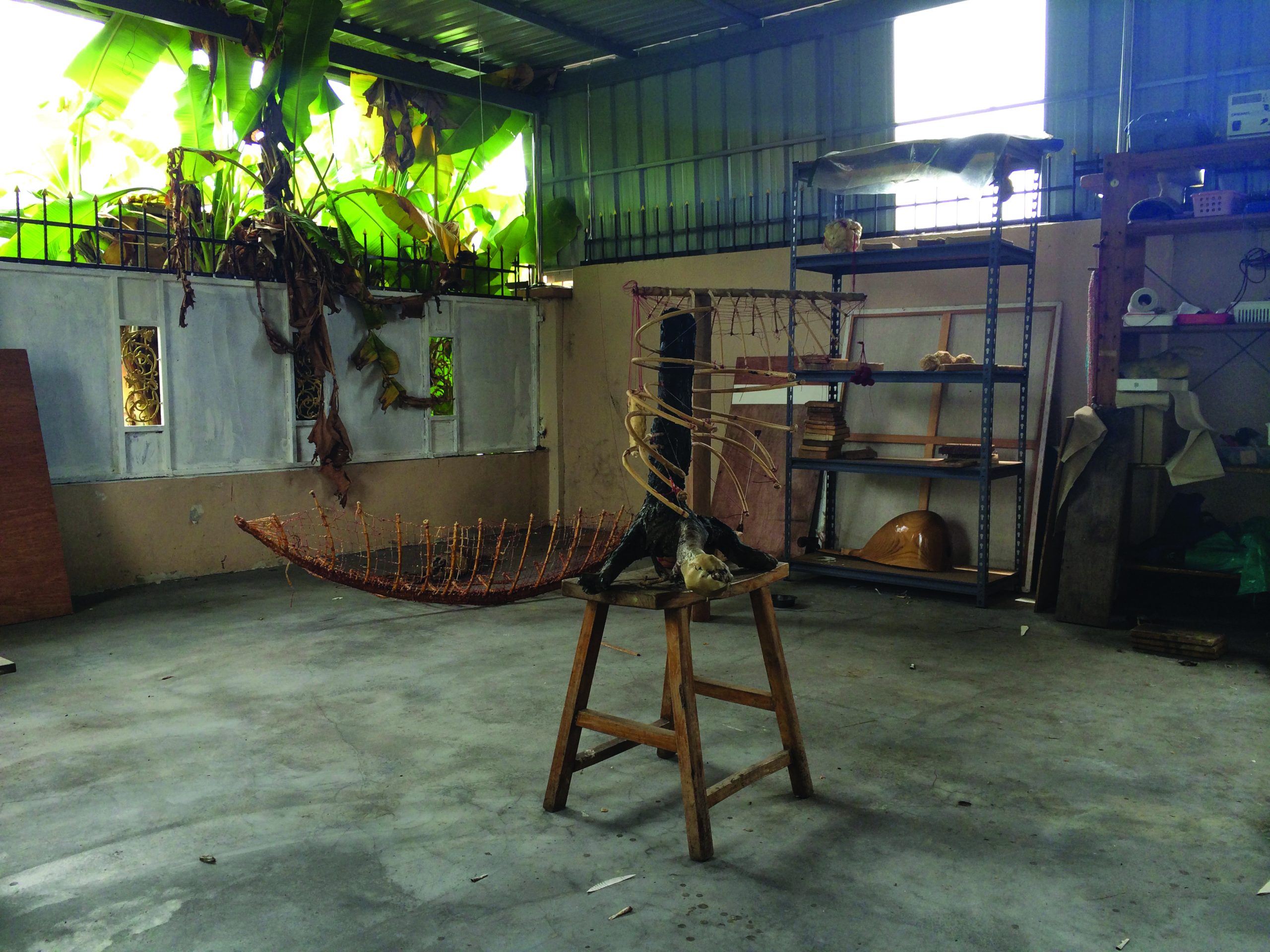
Bala Starr
Zai, I’ve got to ask you about these beautiful sculptures here in the studio. This is a rib cage [points toward Justice, 2014]?
Zai Kuning
Yes, it’s a rib cage, you are right—the wisdom of the ancient world. If you want to make something float you need a rib and they [the Buginese people] studied the ribs and they made a boat. The idea that ships and boats all come from. They realised that the rib is the structure that can make it work. That’s the Bugis world.
It’s from my childhood. If you want to make something float you have to make a rib. It is a philosophy that things just grow.
There is one thing and then something else will grow.
Feel your body. There is a centre at the back. That is how the Bugis discovered how to make a ship. There must be a centre and then something at the side. Beautiful actually.

Bala Starr thanks Zai Kuning, Lin Shiyun, Wardah Mohamad (Ota Fine Arts) for her assistance with the transcription of the interview, and Milenko Prvacki (LASALLE College of the Arts) for the drive to Johor Bahru.
Except where stated, images courtesy of Bala Starr.
Photographic Essay
Khayalan Island |pəˈlou ˈhäyālan|
Khayalan Island is rumored to have disappeared in the early 19th century just as Sir Stamford Raffles was establishing a post in Singapura. This project consists of gathering stories, collecting artifacts and conducting a journey to rediscover this island in the contemporary port of Singapore. Excerpts from The Story of Khayalan Island have been specially edited for this volume.
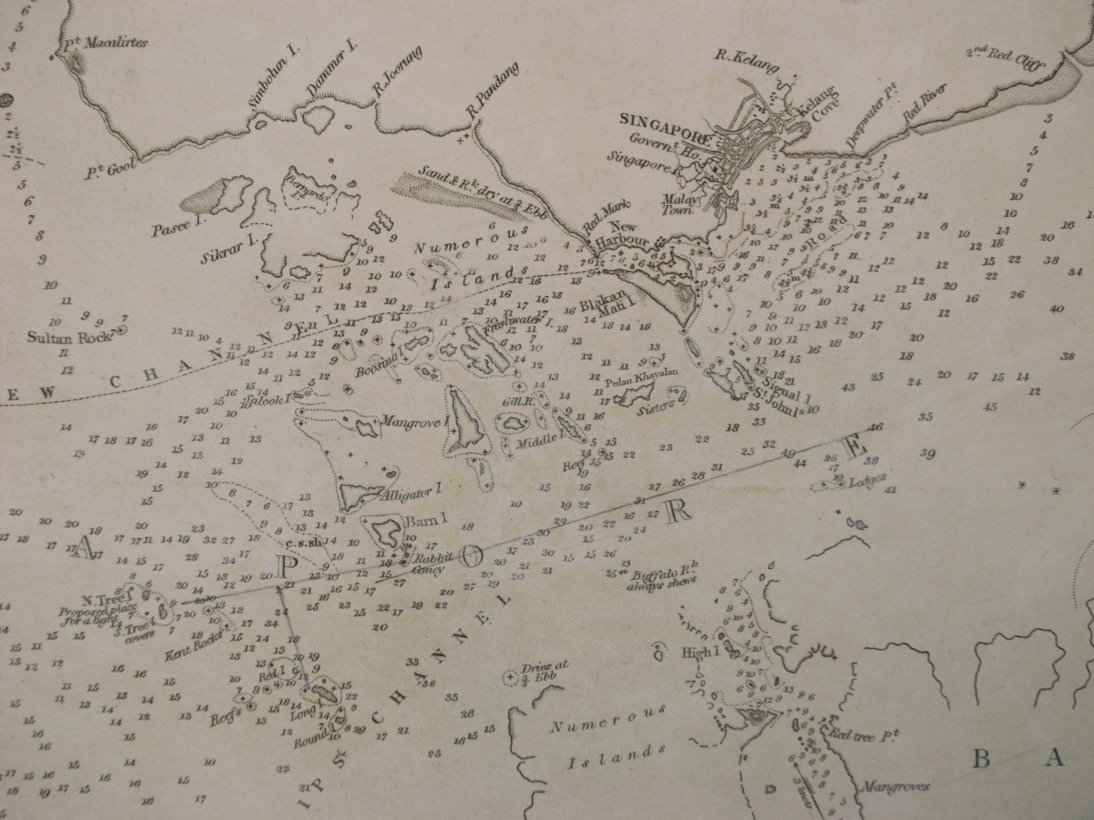
Singapore, Battam, Gallat, Sabon and Khayalan Islands Map,
Ink on paper, 1822/2014.
Image courtesy of the artist.
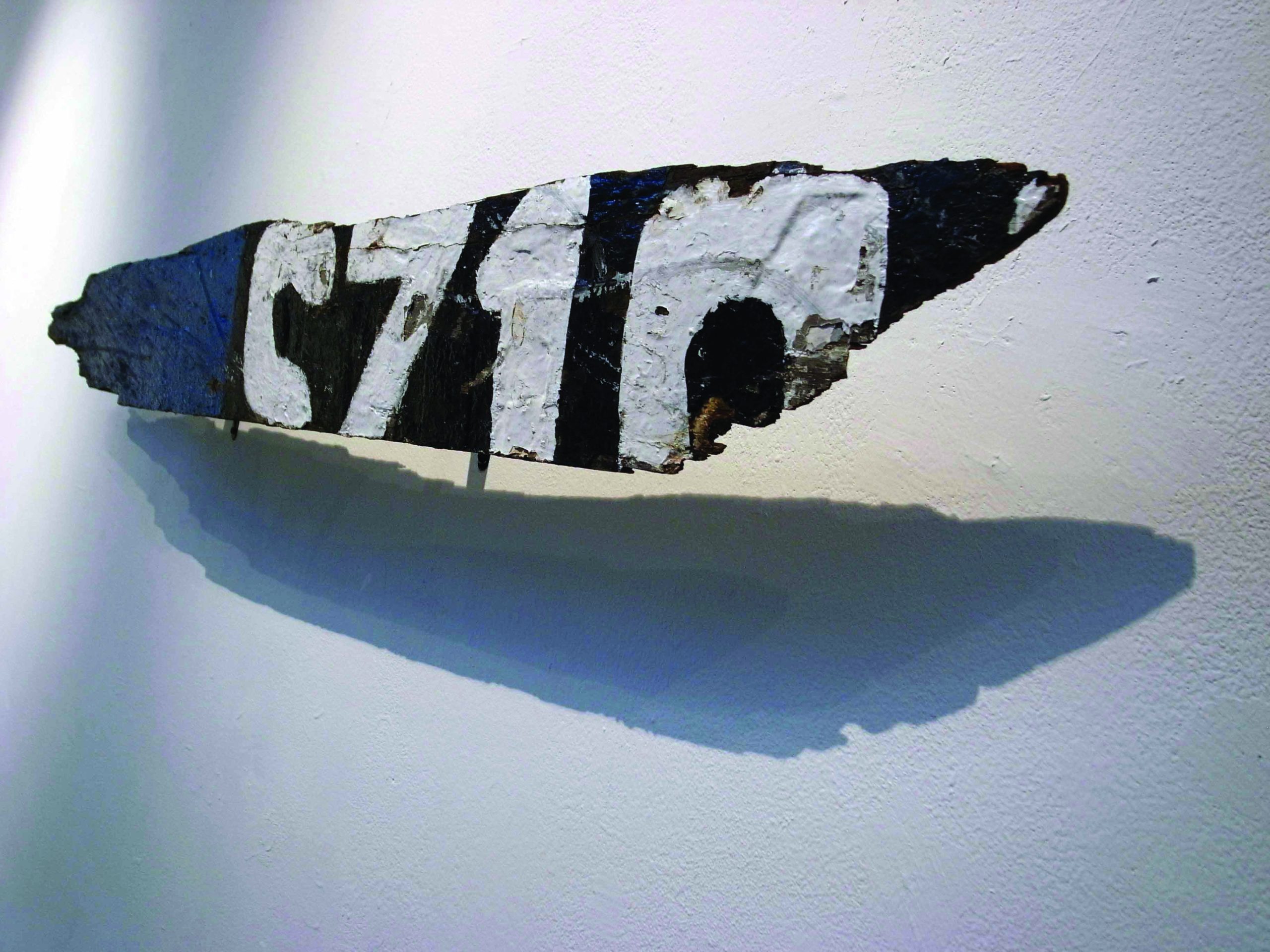
Remnant of a Vessel, 2013.
Exhibition view Institute of Contemporary Arts Singapore, Photo courtesy of the artist.
Spirit of a boat
7,253 meters
off the southern coast
of Singapura
rumor says
there was an island
in between
Belakang Mati and Sebarok
less than forty minutes
to circumambulate on foot
“shoals of stone and sand, with one to two feet of water at low tide, or even less on moon tide days, it would not be difficult to visit the islands without a boat”
yet there is a challenge to the feet
sharp igneous stone on the shallow bottom
known to cut the feet
interspersed with tree coral
on the southeast and west shores
which upon being broken
makes an earthy sweet sugar
now searching for the name of the harbor
I have not yet encountered anyone who knows precisely where it was.
was it forgotten, or is it more about forgetting?
an untold history of the people who worked in the harbor
the land they lived on
what they did after breakfast and before sunset,
looking after this harbor
watching boats come and go
lying under the shade of the sea almond tree
contemplating how to find stories
of a place on the verge of disappearing
…………
now strolling along the reclaimed coastline
what “Pulau Khayalan” did she refer to?
walking one foot in front of the other
square stones and cement orderly fitted one against the other
to hold back the uncertain land covered beneath the surface.
a clear image of a rib cage on this very site
flashes before the back of my eyes
fragments of a disintegrating boat
rotting senegal mahogany
half sunk in the mud
a wooden framework of a sampan boat remains
a spirit among all those that were once docked here
betel palm and rambutan trees dotted the harbor line
along with durian trees
whose wood was used to make sampan boats
sliced, stripped, bent and formed
noticing without waiting
…………
saltwater penetrating the wood fibers
keeping it alive day by day
now freshwater fills it like a tub
slowly rotting the disappearing planks
presence in absence

Search for an Unknown Island, 2014.
Image courtesy of Art Base Momoshima, Photo by Misaki Ohashi.
Island connecting to everywhere
sunshine
laughing
a-i-u-e-o!!!!
ooooo-aaaaaa
it has a mouth
it has chichi
in this shape!
this island
doko demo tsunagatoru
a bridge here
taka tall!
a bridge expert
can get there in one minute
……..one minute
one minute!
or by boat
this island moves
it moves
can go in one minute de
kore na
it moves
in katakana
arriving in one minute
ankiro sound
stone
“can get there in one second”
whale island anchor
ooooaaaa
ummmmmmmmm
kokoya
“what are you writing?”
a dolpin
Mushroom Island
a-a-a
this island
shio-Ta haru-KI
I wrote “doko demo tsunagaru shima”
“island connecting to everywhere”
pirates, whales, sharks and mushroom island
sea, bridges and…
island city
treasure box
many shapes for islands
children
open
an island in the mind
“doko demo tsunagaru shima”
preparing for a journey
to an unknown place
where it is possible
to build a city
appreciating what lies below
inside the earth
water
people
life
reconnect
is this the future
or is it the past?
Really

Journey to an Unknown Island, May 6, 2014.
Photo by Mihoko Furuya.
The scenic channel
one of the smallest boat taxis
six passengers max in the hatch
the dock on the other side
must be far smaller than this one
wind from the south
steadily picking up since we arrived
standing still moving
our boat stops three boats away from the dock
scurry across
one boat to the next
touching for a moment
engines pushing together
ropes lie coiled on deck
green potted plants
on the rooftop of the boat
as I duck in below
flowers, grass and a small tree
with heart shaped leaves
looks so familiar
but not in this generation
a locust tree from Whaddon?
seeds carried from Holland
to be planted in the contingent ecosystem
on the boat
a gentle rocking begins
swaying continues
for the rest of the journey
back and forth——up and down
unpredictable but rhythmic
three other passengers board quickly
sitting on the blue painted slats
we face each other
sliding away from the harbor
just as we push off from land the boat rocks fiercely
jerking starboard and port
waves colliding
as if we might capsize, but that’s impossible
the captain is far too relaxed for that
…………
a choice between a scenic pathway
or the shortest route between two points
inside the boat
slipping off my sandals to step up the five stairs
to the driver’s cabin,
one young boy sits listening to music on headphones
while the other drives
with one hand on the steering wheel, the other hand texting:
………….
in this steamy cabin
a/c reserved for the passengers
watching ahead through scratched and tinted plexiglass
looking down far from
Pulau Belakang Mati on the right
slowly moving forward in the channel, depth 23 meters
previously 2.5 meters at low tide
dredged for passage of tankers in the 1980’s
underwater scenery distorted
memory of contours in dissaray
Kusu Island on the left
slowing down near St. John Island
…what is that tuft of mangroves in between
a sign of Khayalan?
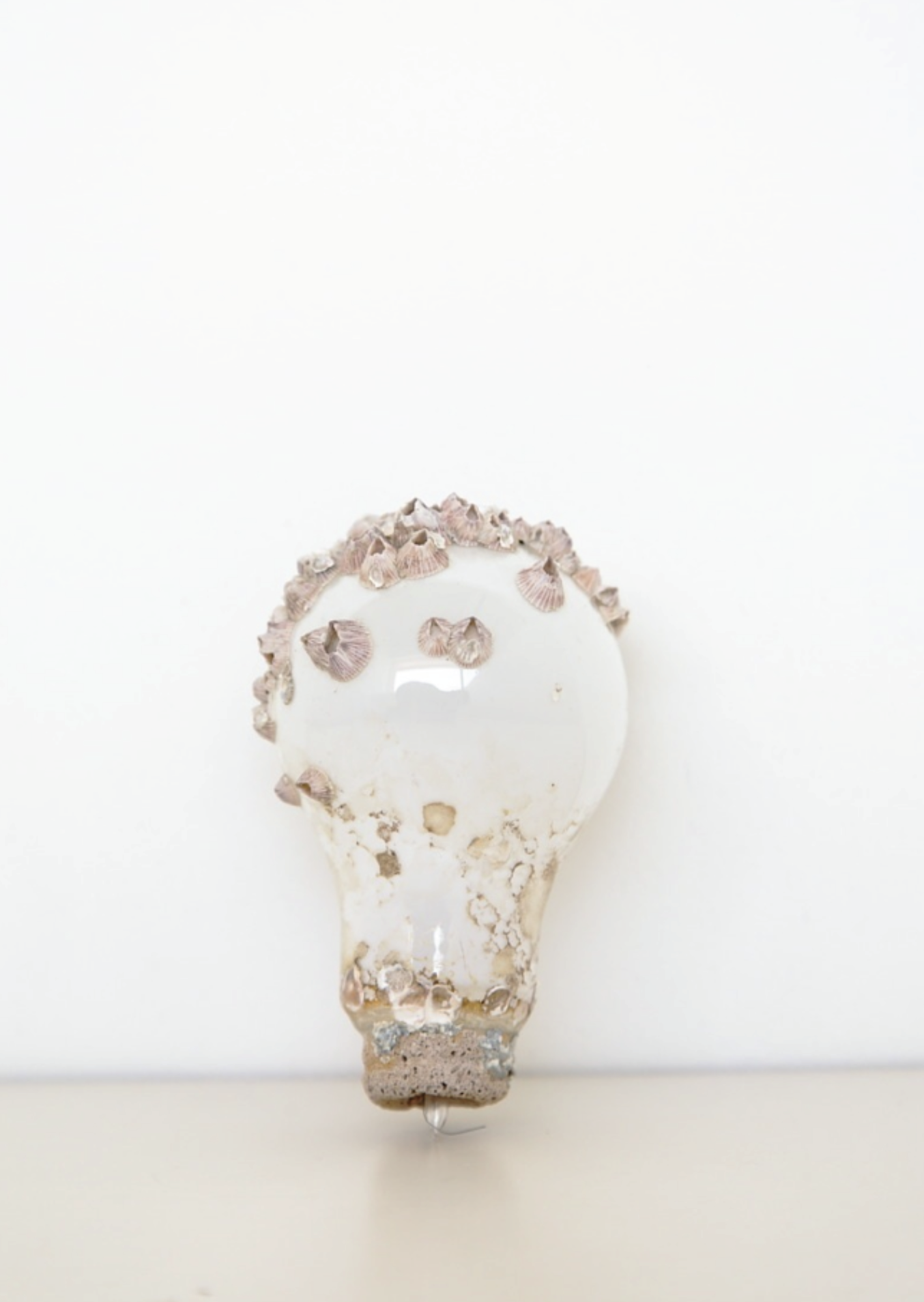
Khayalan Island Artifact
Image courtesy of Art Base Momoshima, Photo by Taro Furukata.
Digging
sitting beneath mangrove shadows
exhausted
lost
I quit searching
a light blue plastic corner protruding from the sand: a clue?
the two of us start digging along the edges to find its dimensions
with cupped hands pulling handful after handful of sand away
from the uncertain form
a stern begins to appear
toru looks for anything that could become a shovel
foraging amidst a rusty gas can, aluminum foil, a blue rubber sandal with no match
round plastic
and bottled plastic
and more plastic
he grabs a broken plastic pitcher and a small white bucket
all useful items
yesterday
we dig
and dig
uncovering red ants,
plastic bags
and rope.
dig, dig, digging until light-headed
pausing by the sea
a plank of wood floating on the threshold of land and water
rotting, heavy with seawater
dark blue paint on one side raw wood on the other
the letters “SZ18…” in white but cut off halfway
…………
certainly a boat, but far too deep and much much bigger than it appeared
a tree sprouting through the midrift
completely buried in sand—probably won’t float anyway
canary tree leaves now lie where passengers sat decades ago
sailing between Changi, Pulau Ubin and Tekong Islands
is…land
island
what is land?
…………
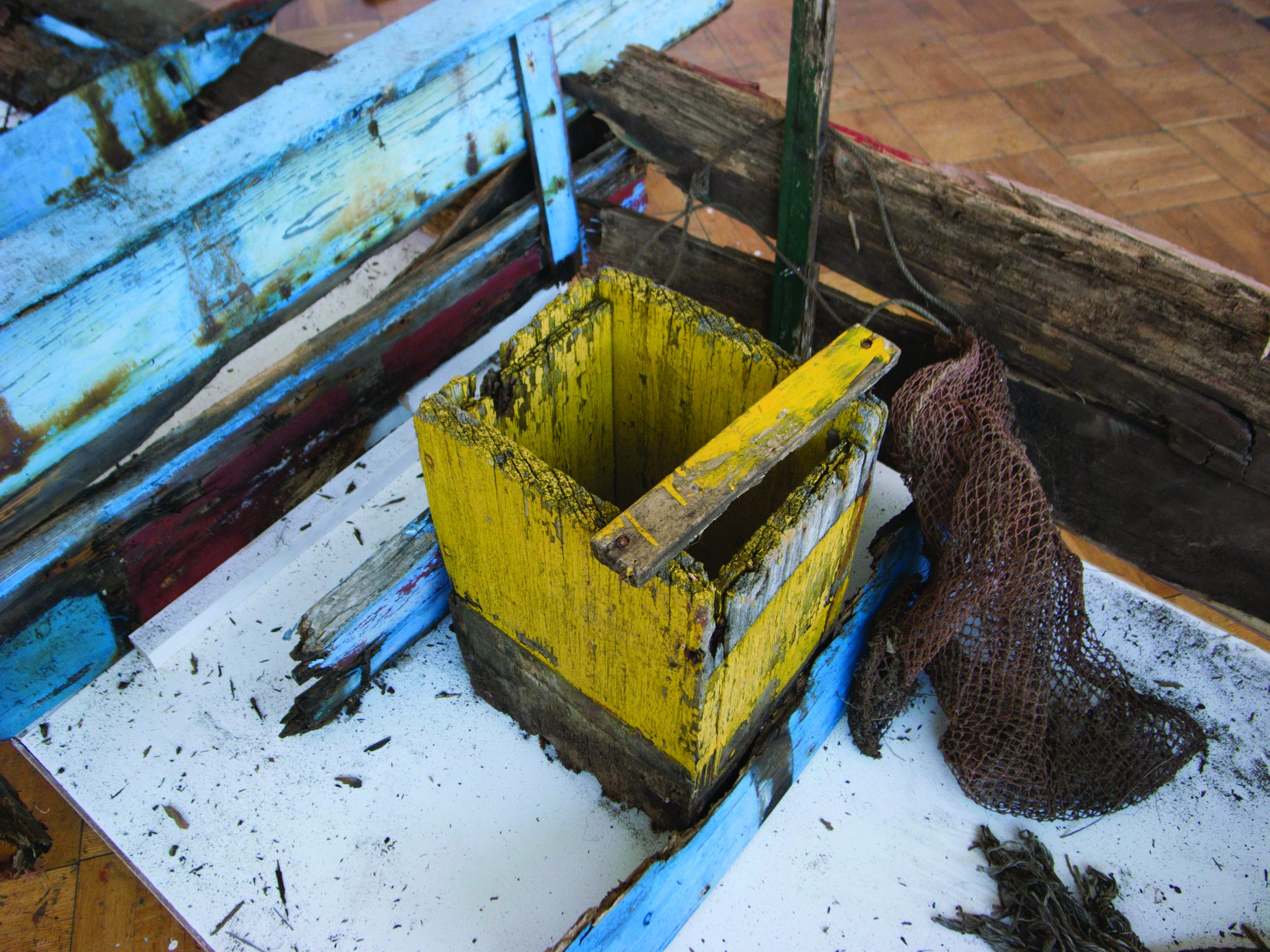
Reconstructed Vessel. Decaying wood and paint.
Exhibition detail from Tokyo University of the Arts, 2014.
a yellow square box in the center towards the rear of the boat
immediately intrigued
with its chipping paint
and faint wood core
fading with the saltwater wind
without human touch
yet retaining the memories
of nakamura
the man who cared for this boat’s delicate existence
in the last years he slowly lost the mobility to venture out
fish were dwindling
and the aching of his lower left back
made it painful
to sit
on the boat slats
for more than an hour
it was even more painful
for him to recapture the feeling
of returning home at dusk
with the blue waterline of his boat riding low in the water
heavy with buckets of pomfret and mackerel
moved
by these memories
in the disintegrating boards
of this small wooden boat
5.5 meters long
vanishing
staring at the rib cage of this skeleton
on the verge of returning to the earth
only visible because of all the oversize garbage items
that have been disposed of inside of its gunnals
standing back
to gaze at what’s left of its hull
no trace of its name on the chipped paint
nothing but bright red painted boards remain
but three can be quite easily reassembled
one split matches the next
after noticing this
I set down the red parts
and notice a corner of curved wood
a stunning shape
that is no longer retained
on boats today
sleek square hulls
a slice of evidence to be examined
no name, just one pale sky blue piece of wood
Unknown Island
start with water
then look at the traces
of that water
paint an Island
that doesn’t exist
paint another faint layer
a very thin wash
the whiteness around an island
minimal void
emptiness around the islands
it can be the sky
it can be water
that experience
i paint what i know
not what i see in the outer environment
I work to know the tree
by observation
talking to people around
the locals
to feel the weather
to paint what I know
in the landscape
try to remember that feeling
I found there were no mountains in Singapore
linear
flat lines
what is this flatness
obviously a lot of it is manmade
there used to be many hills
here looking at photographs
but there is a closeness
of bringing land and water
together
making new shapes
I see long linear lines
I feel a peacefulness
in this imaginary landscape
a seagull struggling in the
harsh wind
being pushing up and down
while trying to go forward
I will just add some ink
and see what happens
the paper itself
has a lot of properties
its like meditation
imagine myself there
in the island
start building a boat
in the shadow of the island
faded, not very clear
blending with the shadow
the boat is the darkest of all the forms
stones are a mix, big rocks in the front
dark ink with dry brushstrokes
looking through the cliff
and in the back there is the island
with space between the island and the cliff
get on the boat
actually, only part of a boat
not the whole boat
but the boat might not make it there
because its an imaginary island
viewers can swim there
or they could fly
References
Gleason, Henry Allen. “Botanical Sketches from the Asiatic Tropics III. Java (Continued)” Torreya, Vol. 15, No. 8, (August 1915), pp. 161-175.
Horsburgh, James and W.F.W. Owen. “Some Remarks Relative to the Geography of the Maldiva Islands, and the Navigable Channels (At Present Known to Europeans) Which Separate the Atolls from Each Other”, Journal of the Royal Geographic Society of London, Vol. 2 (1832), pp. 72-92.
Japan Scientists’ Association Setouchi Committee. “Umetate jigoku no setouchi engan: Kaihatsu no shōrai ha kore de yoi ka?” (“Setouchi Coastline Reclaimed Land Hell: Is this future development right?”), Kyoto: Hōritsu bunka sha Press, 1985.
Morris, Robert. “Notes on Art as/and Land Reclamation”, October, Vol. 12 (Spring, 1980), pp. 87-102.
Newell, Frederick H. “What may be accomplished by Reclamation”, Annals of the American Academy of Political and Social Science. Vol. 33, No. 3, Conservation of Natural Resources (May, 1909), pp. 174-179.
Schwartz, Neil H. and Raymond W. Kulhavy. “Map Features and the Recall of Discourse”, Contemporary Educational Psychology 6, (1981): pp.151-158.
Yeoh, Brenda S.A. Contesting Space in Colonial Singapore: Power Relations and the Built Environment. Singapore: Singapore University Press, 2003.
*Special thanks to Chand Chandramohan, Steve Dixon, Taro Furukata, Milenko Prvacki, Ade Putra, Seng Yu Jin, Jishi Shuho, June Yap, the children of Seikenji Temple nursery school, Danny Liu and residents of Pulau Ubin.
Map, Straits of Singapore, Durian and Rhio,
from surveys by Captain Daniel Ross and Others, 1840,
reproduced with permission of Singapore Maritime Museum Collection,
Courtesy of National Archives of Singapore.
Contributors’ Bios
Contributors’ Bios
John Clang (b. 1973, Singapore) is a visual artist working in photography and film. His photographs examine and raise questions of the world he lives in, providing not pictorial documentation but an intimate mental reflection of one man’s mind. Clang’s first exhibition, at age 20, was a duo-show at 5th Passage Artists, Singapore. In 2010, he became the first photographer to receive the Designer of the Year Award. He was one of the 30 finalists for the 2010 Sovereign Asian Art Prize.He has had solo exhibitions at the Bank Gallery, Los Angeles, (2003) the Jendela Gallery, Singapore (2004), The Substation, Singapore, (2007), the 2902 Gallery, Singapore, (2010) the Pekin Fine Arts, Beijing, (2012), and the Pekin Fine Arts, Hong Kong, (2014). In 2013, a showcase of over 90 works by Clang was exhibited at the National Museum of Singapore. His work has also been shown in group exhibitions including the Proud Galleries, London, (2002), the Singapore Art Museum, (2009), the Annexe Gallery, Kuala Lumpur, (2010), the mc2gallery, Milan (2010), the National Museum of Singapore, (2010), the 2902 Gallery, Singapore, (2011), the LACE, Los Angeles, (2011), the KSU Art Museum, Kennesaw, (2012), and the CCC Strozzina, Florence (2014). His work can also be found in the permanent collections of Singapore Art Museum and National Museum of Singapore. Clang lives and works in New York and Singapore.
Tony Godfrey (b. 1951, England, UK) has been writing on contemporary art for over thirty-five years. To date he has published more than 130 articles and 300 short pieces. His 1998 book, Conceptual Art, was the first publication that highlighted the significance of Conceptual Art as a global phenomenon. Fifteen years on it continues to be in print and has since been translated into five languages. From 1989-2008, Godfrey worked for the Sotheby’s institute, London where he was Director of the MA in Contemporary Art. He was also professor of Fine Art at the University of Plymouth before moving to Singapore in 2009. Since taking up residency in Singapore, he has worked as a writer and curator with artists from Southeast Asian and China. He currently writes for LEAP, Art Monthly (China), Broadsheet and C-Arts Magazine and is curator at Equator Art Projects, Singapore. Godfrey’s books include New Image in Painting (1986), Drawing Today (1991), Conceptual Art (1998), and Painting Today (2009). He has recently co-authored the book Contemporary Photography in Asia and is currently writing a book on Contemporary Indonesian painting.
Ho Rui An (b. 1990, Singapore) is an artist and writer based in London and Singapore. She is working at the intersections of contemporary art, cinema, performance and theory. In a practice that involves writing, talking and thinking around images and their sites of emergence, he seeks to construct new frames and architectures through which notions of transmission, community and incommensurability vis-a-vis the image, are negotiated. He has presented projects at the Serpentine Galleries (London), the LUMA/Westbau (Zürich), the Witte de With (Rotterdam) and The Substation (Singapore). He is the Singapore desk editor for ArtAsiaPacific and has contributed to numerous catalogues and periodicals. In 2011, his first novel, Several Islands, was published by The Substation.
Ho Tzu Nyen (b. 1976, Singapore) creates projects that take the form of films, musical concerts and theatrical performances. His works are characterised by the investigation and incorporation of important cultural moments and ongoing experimentations on the relationships between sound and image. Recurrent concerns include: historiography and the reworking of historical objects, ranging from philosophical texts, historical paintings and popular songs; and the analysis of the production of visual aesthetic and acoustic deconstruction. Recent one-person exhibitions include: The Cloud of Unknowing at MAM Project 016, Mori Art Museum, Tokyo (2012); the Singapore Pavilion at the 54th Venice Biennale (2011); and EARTH at Artspace, Sydney (2011). He has also exhibited at various biennales, including: the 26th Sao Paulo Biennale (2004), the 3rd Fukuoka Asian Art Triennale (2005), the 1st Singapore Biennale (2006) the 6th Asia-Pacific Triennale (2009), and the Asian Art Biennale (2011). Ho’s films have been presented as various film festivals, including the Sundance in 2012 and Venice in 2009. His first feature film HERE premiered at the 41st Directors’ Fortnight at the Cannes Film Festival (2009). Theatrical performances by Ho have been presented at: the KunstenFestivaldesArts (2006, 2008), the Singapore Arts Festival (2006, 2008) and the Theater der Welt (2010). He has also collaborated with many musicians in his work, including: Yasuhiro Morinaga (Japan); Stefano Pilia (Italy); Black to Comm (Germany); Wolfram (Poland); Oren Ambarchi (Australia); Randolf Ariola (Singapore); Bani Haykal (Singapore); 3 Tigers (Singapore); and Aki Onda (US/Japan). In 2011, De Stijl Records released the soundtrack to EARTH by Black to Comm, featuring Vindicatrix on vocals.
Hou Hanru (b. 1963, Guangzhou, China) is a writer and curator based in Rome, Paris and San Francisco. He is currently the Artistic Director of MAXXI (National Museum for 21st Century Art and National Museum of Architecture), Rome, Italy.Hou received degrees from the Central Academy of Fine Arts in Beijing in the 1980s and moved from China to France in 1990. After working as an independent curator and critic based in Paris, he became Director of Exhibitions and Public Program and Chair of Exhibition and Museum Studies, at San Francisco Art Institute (SFAI) from 2006 to 2012. His main program at SFAI has been summarised in his new book Paradigm Shifts, Walter and McBean Galleries Exhibitions and Public Programs, San Francisco Art Institute (2011). Hou has curated and co-curated around 100 exhibitions over the last two decades including: China/Avant-Garde, National Museum of Art of China, Beijing, (1989), Cities On The Move, (1997–2000), at the 2nd Johannesburg Biennale, Hong Kong, etc., (1997), the Shanghai Biennale (2000), the Gwangju Biennale (2002), the Venice Biennale, French Pavilion, 1999, Z.O.U. -- Zone Of Urgency, (2003), the Chinese Pavilion, (2007), the Nuit Blanche, Paris, (2004), the 2nd Guangzhou Triennial (2005), the 2nd Tirana Biennial (2005), the 10th Istanbul Biennial (2007), Global Multitude, Luxembourg, (2007), Trans(cient)City, Luxembourg, (2007), EV+A 2008, Limerick, (2008), The 10th Biennale de Lyon, (2009), By Day, By Night, or some (special) things a museum can do, at the Rockbund Art Museum, Rockbund, Shanghai, (2010), Power of Doubt, PhotoEspagna, (2010), Madrid, at the Times Museum, Guangzhou, (2011), Dirty Realism, Liu Xiaodong in Hotan (organised by the Today Art Museum, Beijing, Urumqi, 2012, Beijing, (2013), Zizhiqu – Autonomous Regions, at the Times Museum, Guangzhou, (2013), and If you were to live here… – The 5th Auckland Triennial, Auckland, New Zealand, (May – August 2013). He is a consultant for numerous cultural institutions (museums, foundations, collections, etc.) internationally including the Deutsche Bank Collection, the Solomon Guggenheim Museum, New York, the Times Museum, Guangzhou, the Rockbund Art Museum, Shanghai, the Kadist Foundation, San Francisco, etc. He frequently contributes to various journals on contemporary art and culture and teaches in numerous international institutions including Flash Art International, Yishu, ArtAsiaPacific and LEAP while serving as jury member for art prizes including the recent “Hugo Boss Prize Asia Art”, etc. His books include On the Mid-Ground (English version published in 2002, by Timezone 8, Hong Kong, and a Chinese version published in 2013, by Gold Wall Press, Beijing), and Curatorial Challenges (conversations between Hou Hanru and Hans-Ulrich Obrist, in Art-It magazine as “curators on the move”, Japan, 2006-2012, Chinese version, Gold Wall Press, Beijing, 2013).
James Jack (b.1979, United States) is an artist, art writer and current PhD candidate in art practice at the Tokyo University of the Arts. He is concerned with rejuvenating fragile connections that exist in the world, putting artworks in direct relationship to a place and the people who live there. He has developed socially engaged projects for recent group exhibitions including the Setouchi International Art Festival, the Busan Biennale Sea Art Festival, the Art Base Momshima and the Echigo-Tsumari Art Triennial. As part of his investigation of the contradictory relationship between nature and culture, he has facilitated collaborations with other artists including the exhibition “Play with Nature, Played by Nature”, which included seven artists responding to natural disasters as well the one on one collaboration “Solvitur Ambulando”. His artworks that establish a connection between our lives and the hidden layers of the land have been featured in solo exhibitions at the Honolulu Museum of Art, Kujira Space (Yokohama), the TAMA Gallery (New York City) and the Satoshi Koyama Gallery (Tokyo). His published writings, which consist primarily of interviews, have appeared in The Japan Times, Modern Art Asia, Art Asia Pacific, Tokyo Art Beat as well as numerous gallery and museum catalogues.
Lim Kok Boon (b. 1978, Singapore) is an educator, artist and art critic. He has curated exhibitions, penned exhibition catalogue essays and written reviews for the defunct Vehicle. He holds an Art History and Fine Art degree from Goldsmiths College, London and a Master of Philosophy degree from the Faculty of Education, University of Cambridge. Named a President’s Young Talent in 2001 for his art practice, he is writing art reviews as part of a 10-year art history experiment and as his contribution to art education in Singapore. Part one of this project was published as Not in Any Order: Writings on Singapore Art 2006-2010. http://www.boonscafe.com
Pawit Mahasarinand (b. 1972, Thailand) has taught world dramatic literature, theatre and film criticism classes at Chulalongkorn University’s Department of Dramatic Arts since 1992. He has written dance and theatre reviews for English-language daily newspaper The Nation since 2001— which allows him to watch about 150 performances a year, mostly in Asia and Europe. He has translated and staged Thai-language productions of Mamet’s Oleanna and Handke’s Offending the Audience, among others. He read his academic papers on Thai and Southeast Asian dance and theatre at the International Federation for Theatre Research (IFTR) conferences in Canterbury, Lyon, Amsterdam, Osaka, Barcelona and Coventry; and the Performance Studies International (Psi) conferences in Tempe, Singapore, Palo Alto and Shanghai. He also gave lectures on play translation and adaptation as well as dance and theatre criticism at the Tokyo Metropolitan Theatre; the GoetheHaus, Jakarta; LASALLE College of the Arts; and the Southeast University, Nanjing. His entries on Thai theatre are in The Encyclopedia of Asian Theatre, published by Greenwood Press. As the artistic director of “World Performances @ Drama Chula” program at the Sodsai Pantoomkomol Centre for Dramatic Arts in Bangkok, he has been working with local dance and theatre companies as well as foreign embassies and cultural institutions in presenting and producing contemporary performances, including Pichet Klunchun Dance Company’s Nijinsky Siam, Black and White and Nay Nai; Tim Crouch’s An Oak Tree; Oriza Hirata’s Sayonara; and Pascal Lambert’s Clðture de l’amour. As the first president of the International Association of Theatre Critics’ (IATC) Thailand Centre, he was a critic-in-residence at Festival/Tokyo 2011 and will be part of the Asia Pacific Dance Festival 2015 in Hawaii. Samples of his reviews can be found at http://blog.NationMultimedia.com/DanceAndTheatre.
Aubrey Mellor is an award-winning theatre director and arts educator and currently Senior Fellow of Performing Arts at LASALLE in Singapore. He studied acting and directing under Sir Tyrone Guthrie, Giorgio Strehler and others, including the son of Komparu Noh master, Hideo Honda. He is known as translator and director of plays, musicals and operas. Formerly Director of the National Institute of Dramatic Art (NIDA); he has been Artistic Director of the Playbox-Malthouse, the Royal Queensland Theatre Company, the Nimrod Theatre Company (now Belvior) and the Jane Street Theatre. The first Australian to study Asian traditional theatre, his awards include the Churchill Fellowship, the Order of Australia Medal, the Australian Writer’s Guild (AWGIE), the Dorothy Crawford Award, and the International Theatre Institute’s Uchimura Prize for best production (Tokyo International Festival).
Jonathan Mills (b. 1963, Australia) is a prize-winning composer and festival director, born and raised in Australia. He has dual Australian and UK citizenship. He studied composition under Peter Sculthorpe at the University of Sydney and graduated with Master degree in Architecture at the Royal Melbourne Institute of Technology (RMIT) in 1999, focusing on acoustic design and the role of sound in the built environment. Between 1998 and 2003 he was an Adjunct Professor at RMIT. His work includes the operas, Ghost Wife, Sandakan Threnody, Eternity Man, an oratorio, a ballet, song cycles, concertos, and chamber music. He has directed a number of arts festivals in Australia, and since 2006, he has been Director of the Edinburgh International Festival. He has an honorary doctorate from the University of Stirling, St Andrews, Edinburgh. In 2011, he was appointed an Officer of the Order of Australia, and was knighted in the Queen’s Birthday Honours (UK) of 2013.
Allan Sekula (1951-2013) was an American artist, whose photography was often exhibited or produced into books and films. His photographs dwelt on global economic systems of late capitalism. Since the 1970s, his works had been shown across the world, predominantly in Europe and the US; they were also showcased in China, Korea, Taiwan, Turkey, Laos and Ivory Coast. Some of his solo exhibitions were displayed at the Museo de Arte Contemporánea de Vigo, Spain (2012), The Dockers Museum (2013), and the Galerie Michel Rein, Paris (2013). He participated in, the Yokohama Triennial (2001), the Documenta XII and Documenta X1, Kassel, Germany (2002, 2007), the Busan Biennale 2006: Everywhere, Busan, South Korea (2006); the 10th Istanbul Biennial, Istanbul, Turkey, (2007), and the Media City Seoul 2, 6th Seoul International Biennale of Media Art, South Korea, (2010). In 2011, Palau de la Virrena (Barcelona) showed a retrospective of Sekula’s films.
Bruno Serralongue (b. 1968, France) is a photographer who lives and works in Paris. Some of his selected solo shows were at: Air de Paris, Paris, (1996 and1997), FRAC Corse, Corte, (1998), Villa Arson, Nice, (1999), Air de Paris, Paris, (2000) Centre National de la Photographie, Paris, (2002), Overgarden, Copenhagen, (2003), Air de Paris, Paris, (2004), Le Triangle, Rennes, (2005), Baronian Francey, Brussels, (2006) Centre de la Photographie, Backdraft, Geneva, Air de Paris, Paris, (2007) Francesca Pia, Zürich, (2008) La Veireina, Bacelona. (2009), Jeu de Paume, Paris, (2010) and Baronian Francey, Brussles (2011).
Bala Starr is the Director of the Institute of Contemporary Arts Singapore at LASALLE College the Arts. She was previously senior curator at the Ian Potter Museum of Art at the University of Melbourne. Prior to her position at the Ian Potter Museum of Art, she was international program manager at the Melbourne International Biennial, and director at the Contemporary Art Centre of South Australia, Adelaide. Throughout her career, she has sustained a reputation for working closely with artists and building the discourse of contemporary art practice. Her earliest professional experiences at Gertrude Contemporary Studio, alongside exhibiting artists, remain a foundational influence in her curatorial work.
Dubravka Ugrešić (b.1949, Croatia) is one of Europe’s leading novelists and essayists. Over the past 30 years, her writing evolved from early postmodernist writings to elegiac prose. In both fiction and documentative observations, her work highlights the disintegration of Yugoslavia, her homeland, and the fall of the Berlin Wall. Ugrešić attained degrees in Comparative and Russian Literature, and worked for many years at the University of Zagreb’s Institute for Theory of Literature. Ugrešić was an outspoken critic of war and ethnic conflicts between Serbs and Croatians in the early 1990s. As a result of constant public ostracism and media harassment, she left Croatia in 1993. Her books have been translated into over twenty languages. She has taught at Harvard, at UCLA, and at the Free University of Berlin. She is the winner of several major literary prizes, most recently the 2012 Jean Améry Essay Prize, awarded for her essayistic work as a whole. Karaoke Culture (2011) was a finalist for the National Book Critics Circle Award for Criticism. Her newest collection of essays is Europe in Sepia (2014). Ugresic is a regular columnist for Salamagundi Magazine, and her writings appear in The Baffler, Gazeta Wyborcza, Peščanik, Reč and other periodicals. She lives in Amsterdam.
David Williams is the translator of the works of Dubravka Ugrešić’s Karaoke Culture (2011) and Europe in Sepia (2014). He is currently a DAAD (German Bureau for Academic Exchange) postdoctoral fellow at the University of Konstanz. He has authored Writing Postcommunism: Towards a Literature of the East European Ruins (Palgrave, 2013).
June Yap (b. Singapore) is an independent curator, previously the Deputy Director and Curator of the Institute of Contemporary Arts Singapore, and curator at the Singapore Art Museum. Selected curatorial projects include No Country: Contemporary Art for South and Southeast Asia as part of the Guggenheim UBS MAP Global Art Initiative, The Cloud of Unknowing at the 54th Venice Biennale with artist Ho Tzu Nyen (Italy), the video programme You and I, We’ve Never Been So Far Apart: Works from Asia for VideoZone5 for the Center for Contemporary Art in Tel Aviv (Israel), The Future of Exhibition: It Feels Like I’ve Been Here Before at the Institute of Contemporary Arts (Singapore), Das Paradies ist Anderswo / Paradise is Elsewhere at Institut für Auslandsbeziehungen (ifa)(Germany), and Bound for Glory with artist Wong Hoy Cheong at the National University of Singapore (NUS) Museum.
Zai Kuning (b. 1964, Singapore) received his BA in Fine Arts from LASALLE College of the Arts in 1995 and currently lives and works in Johor Bahru, Malaysia. Constantly engaging with the unique culture and ecology of the Southeast Asian region, he has pioneered a versatile multi-disciplinary and improvisational practice. Kuning has participated in notable group exhibitions including The Second Asia Pacific Triennial of Contemporary Art, at the Queensland Art Gallery, Brisbane, Australia (1996), The 3rd Fukuoka Asian Art Triennial, Fukuoka Asian Art Museum, Fukuoka, Japan (2005), the Singapore Biennale 2011: Open House, Singapore (2011) and Welcome to the Jungle: Contemporary Art in Southeast Asia from the Collection of Singapore Art Museum, Yokohama Museum of Art, Yokohama, Japan (2013). His work is collected by the Singapore Art Museum and the Fukuoka Asian Art Museum.
Venka Purushothaman (b.1965, Singapore) is an art writer, academic, and arts and cultural manager. He is currently Vice-President (Academic) and Provost at LASALLE College of the Arts, Singapore. He has researched and written extensively on visual arts, performing arts and arts management with an interest in contemporary art. He has written essays on numerous artists including Pierre & Gilles (France), Nathalie Junod Ponsard (France), Parvati Nayar (India), Salleh Japar (Singapore). His artist monographs include: The Art of Sukumar Bose: Reflections on South and Southeast Asia (2013); Dance Me through the Dark: The Photography of Tan Ngiap Heng (2008); and Salleh Japar: Gurindam dan Igauan (2004). His books on arts and culture include Making Visible the Invisible: Three Decades of the Singapore Arts Festival (2007) and Narratives: Notes on a Cultural Journey, Cultural Medallion Recipients, 1979-2002 (2002).
Susie Wong (b. Singapore) is an art writer, curator and artist. She contributes to several publications in Singapore: she was a regular art reviewer in the 1990s for The Straits Times, Life! Singapore, and a regular art feature writer for magazines such as The Arts Magazine (publ. The Esplanade), ID, and d+a in architecture and design, among many others. She has written for publications such as Southeast Asia Today, 1995 (publ. Roeder). She is a member of AICA (International Association of Art Critics - Singapore Chapter). She has published 2 special edition art books: Trace (2008) and Tracing Land (2014).
